Heavy Freight Wagons of the American West
Text By Gary Carter
Photos sourced by Western Mining History from various archives.

Author`s Note
Twelve billion tons of freight were transported by truck in the United States last year. The skilled drivers have CB contact, radio, headphones, paved roads, power steering, sleeper cabs, and comfortable seats. Truck stops provide food, showers, and fuel.
One of the least appreciated but important jobs during the era of the western expansion was moving freight to provide everything from food to machinery, household goods, ore, and needed equipment for the rancher, miner, farmer, households, and storekeeper. Yet the “mule skinner” or “bull whacker” ranked near, if not at the bottom, on the scale of importance in stories about the old West, and even during their time they were looked down upon.
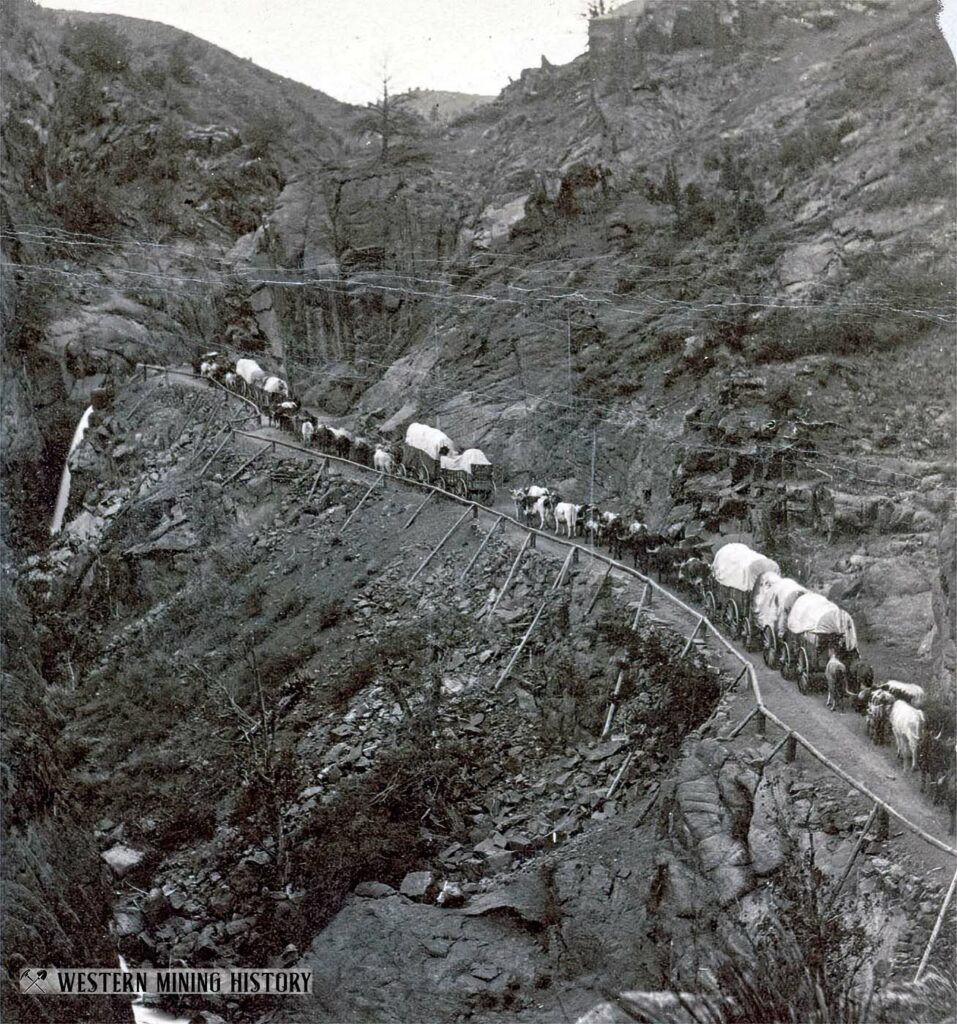
This article will provide a snapshot of the operation and men (mostly) of early freighting in the period before wheeled vehicles. The use of steamboats on navigable waters in the west, and the steady growth of railroads from the 1840’s well into the latter part of the century provided a huge slice of the freight transporting business, but those modes generally reached cities and large towns, off loaded and needed to be transported.
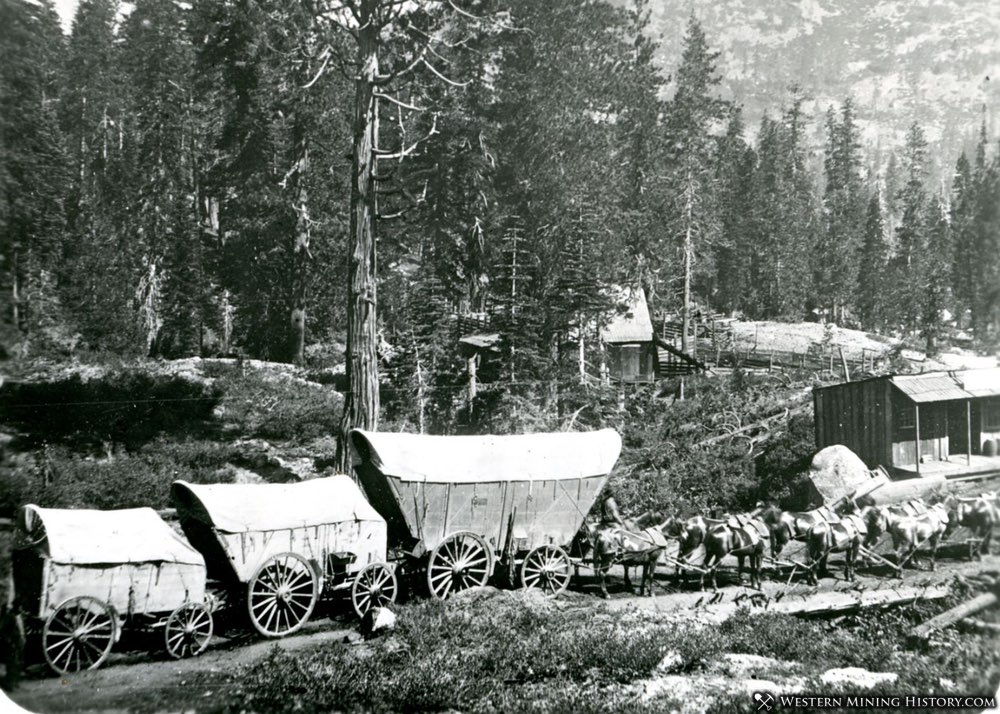
The focus of this article is on heavy duty freight wagons. Light weight express wagons, farm wagons, “Prairie Schooners“ and Conestoga wagons typically used along the trails heading West, military supply/escort wagons, and stage coaches will not be addressed. I hope readers will be as surprised, interested and entertained as I was doing the research.
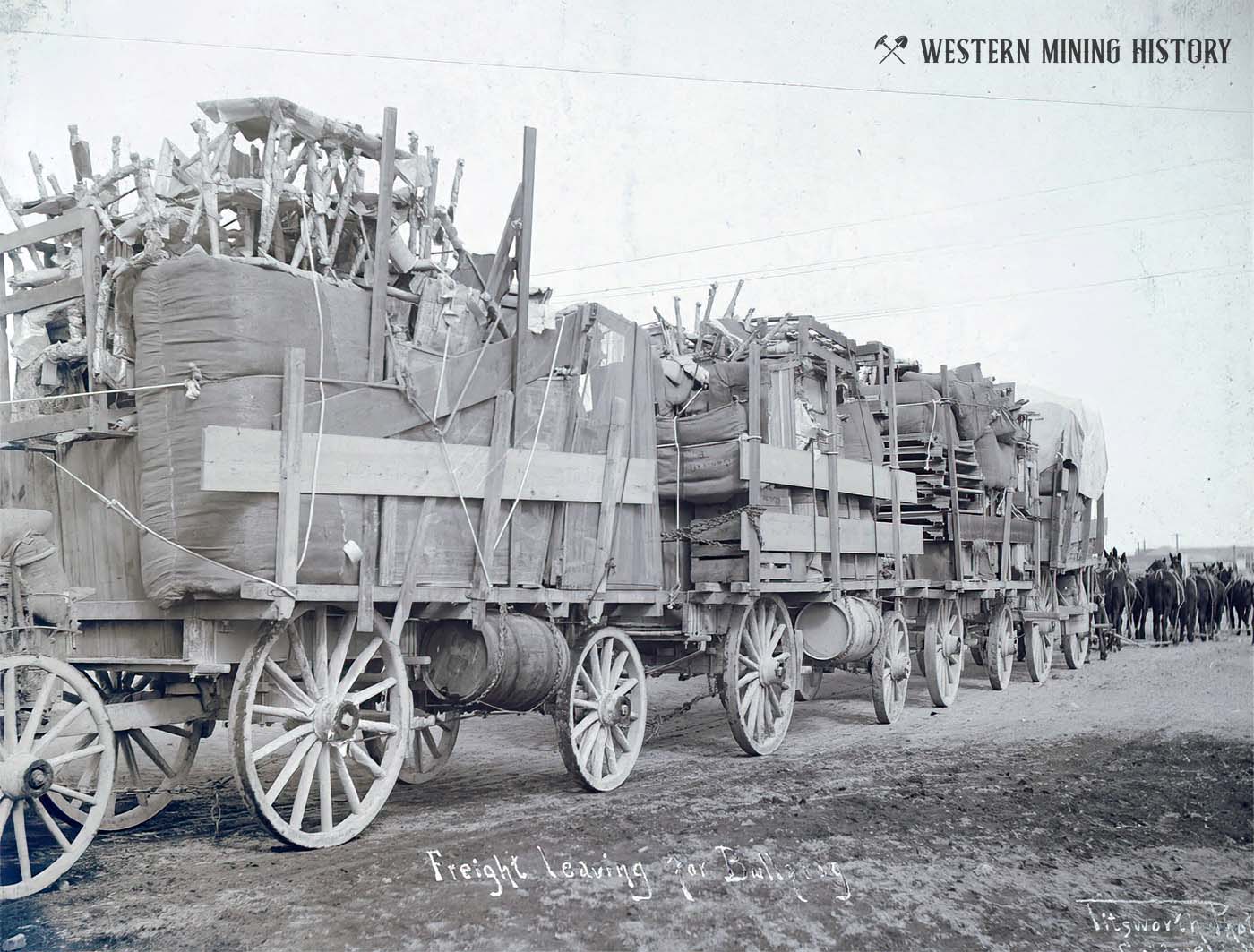
The Freight Companies
Sometimes the scope of things really doesn’t change that much. Just as today, in the early days (up to 1900), there were large freight companies and plenty of independent operators who saw a need to earn a living transporting goods.
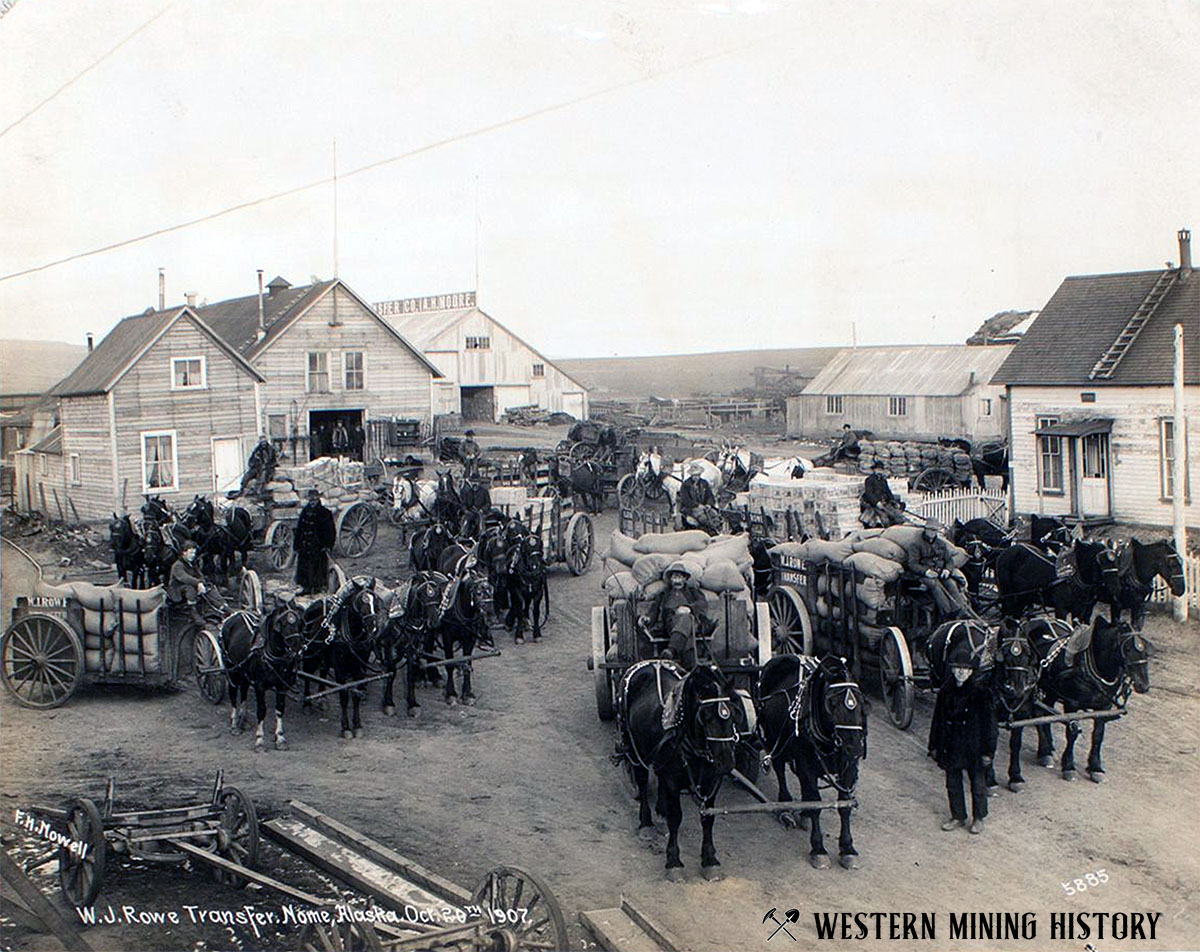
Some of the larger companies in the Western States were: The Miller Brothers Freight Company in Arizona, Charles T. Hayden’s Freight company, which had a wide range of coverage. Russell, Majors, and Waddell, while starting in the Great Plains eventually grew to ship goods throughout the west via Santa Fe. Ketchum’s Fast Freight Line served most places in Idaho.
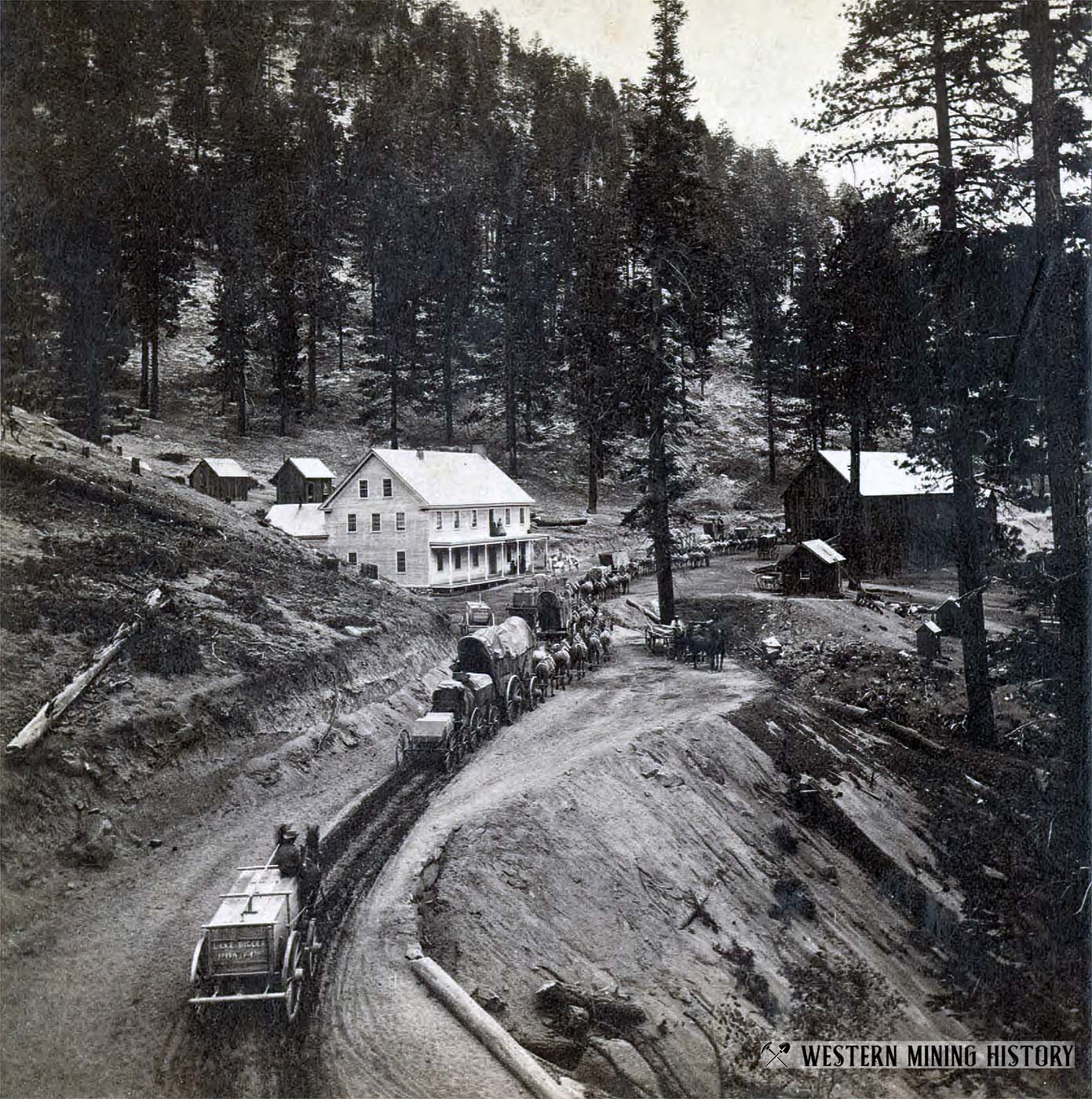
Frank Shaw had a large freight operation that supplied many towns and mines in eastern California and western Nevada and hauled out the first Twenty Mule Team borax wagon load from Death Valley.
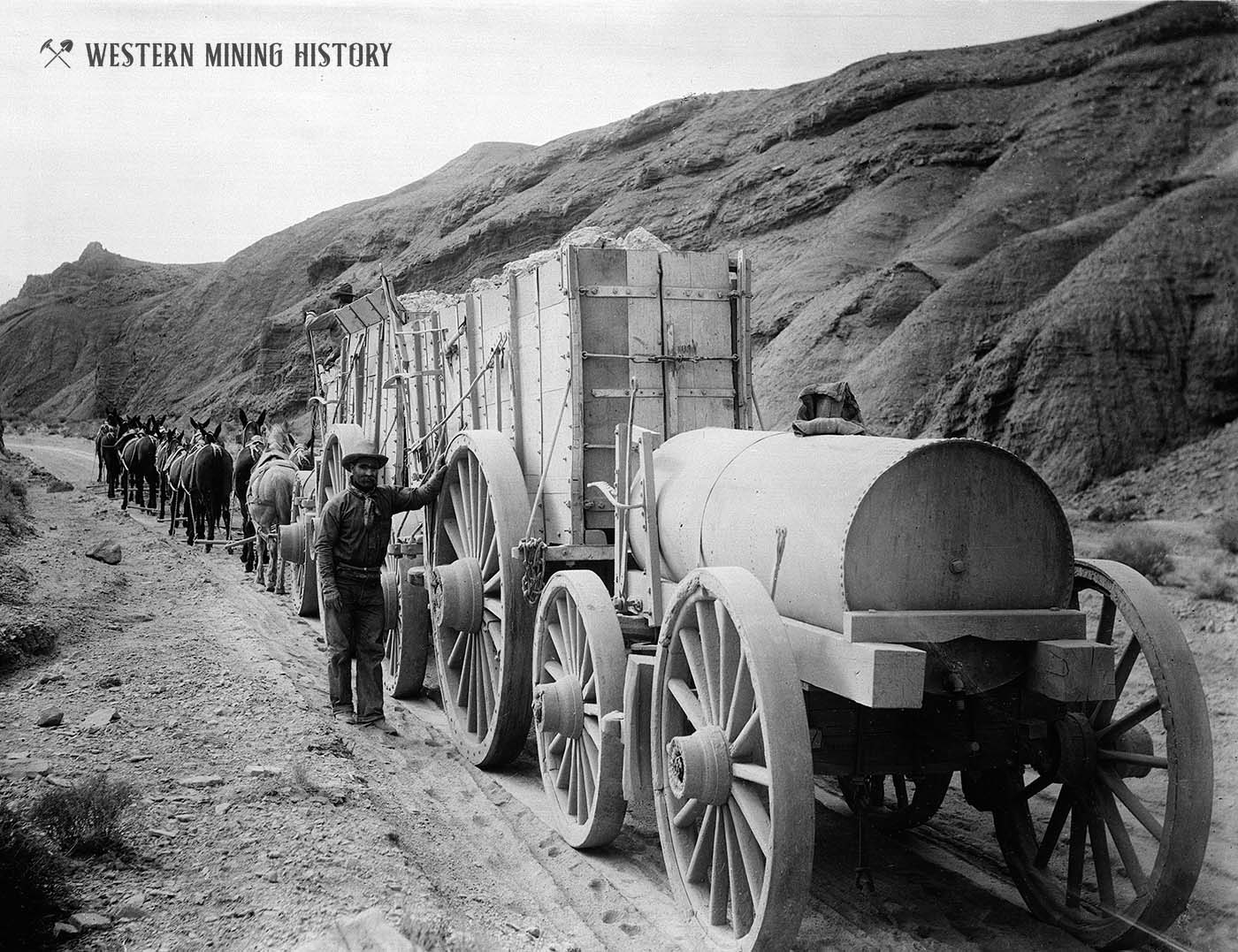
Remi Nadeau was known as the king of the Desert Freighters and his company regularly moved goods from Los Angeles to Salt Lake City and Virginia City, Montana. In the late 1860’s Remi Nadeau and Mortimer Belshaw, part owner of the famous Cerro Gordo silver mine, combined to operate the famed Cerro Gordo Freight Company which served most of California and clear into New Mexico.
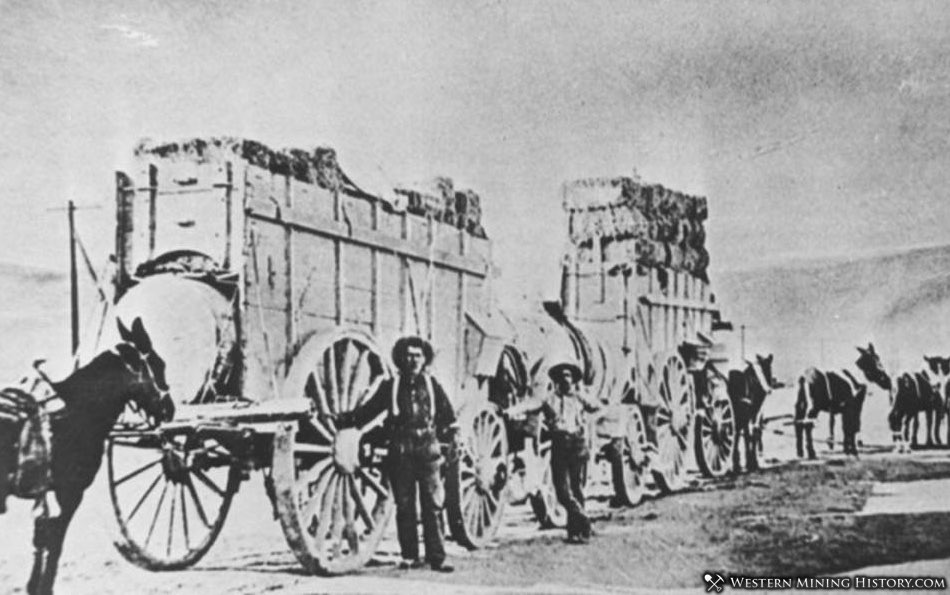
During the California Gold Rush, mining camps were often so remote and difficult to reach that pack trains of mules carried supplies and much of this was done by individuals. By the mid 1850’s some trails were sufficient to be attempted by wagons, and Phineas Banning and David Alexander formed a freight company which supplied many camps. Their livestock included over 500 mules and horses capable of hitching to forty or more wagons.
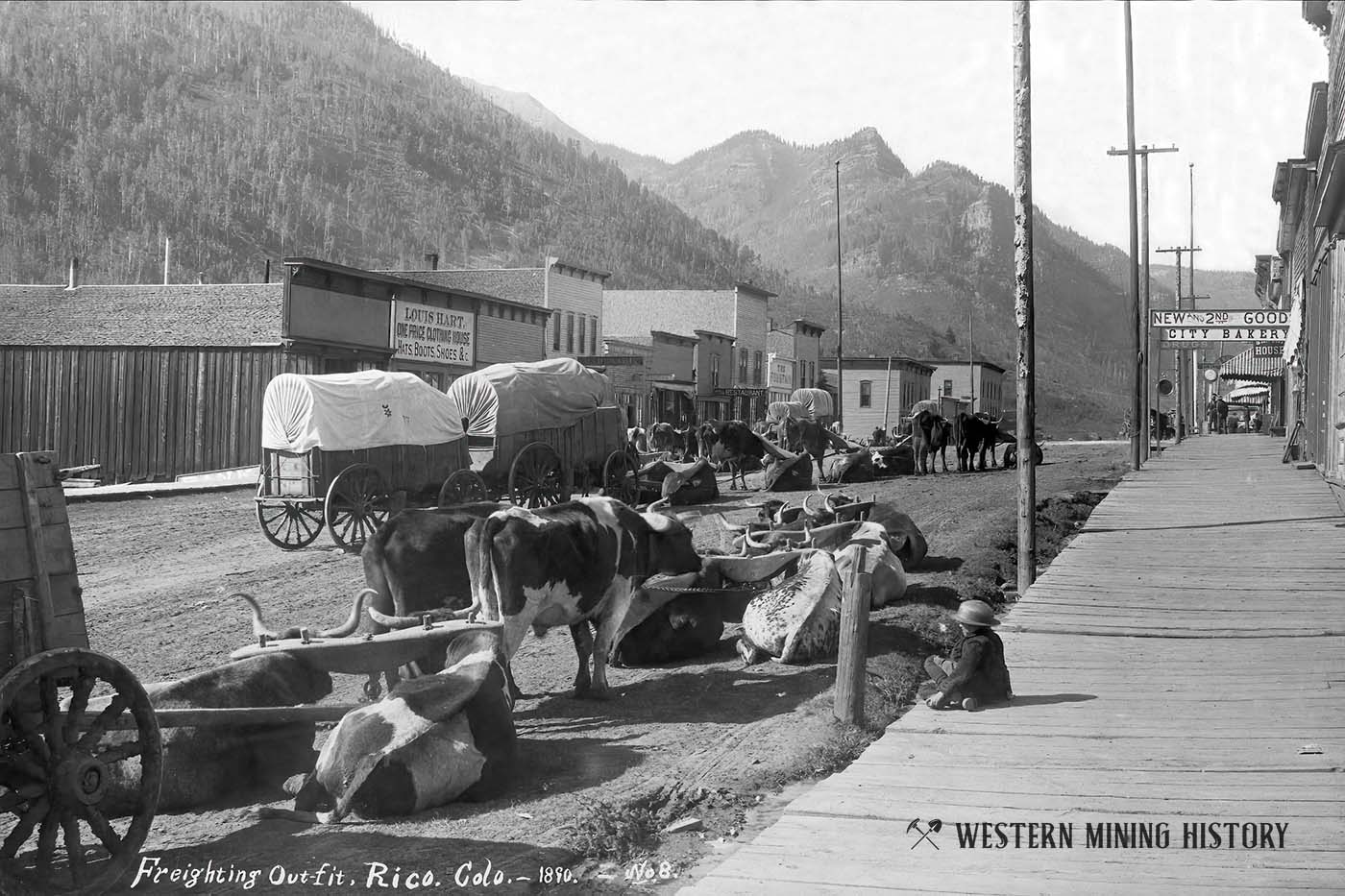
In Colorado, especially in the rich San Juan Mining District, John Ashenfelter ran a large pack train and freighting company that supplied the towns and mining camps, and along with Dave Wood were the largest freighters into Southwestern Colorado towns and mining districts.
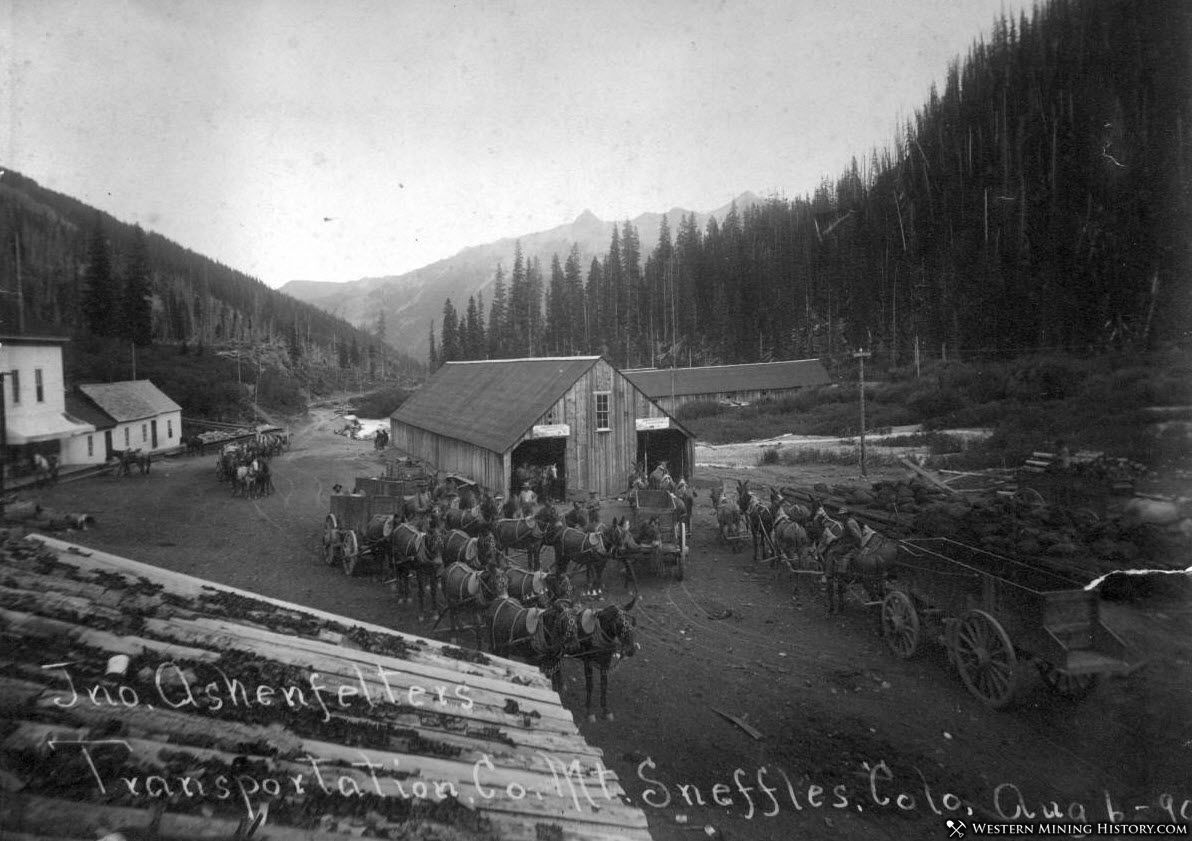
These are just a few of the larger freight companies. On a smaller scale were the independent and often lone teamsters who took on the contracts too small, dangerous, or remote for the larger outfits to bother with.
Mule Skinners and Bull Whackers
Depending on your team of animals those who drove the freight wagons were called mule skinners or bull whackers. The mules, of course were not skinned, but the “bull whackers” did have long whips with which to “urge the oxen along”.
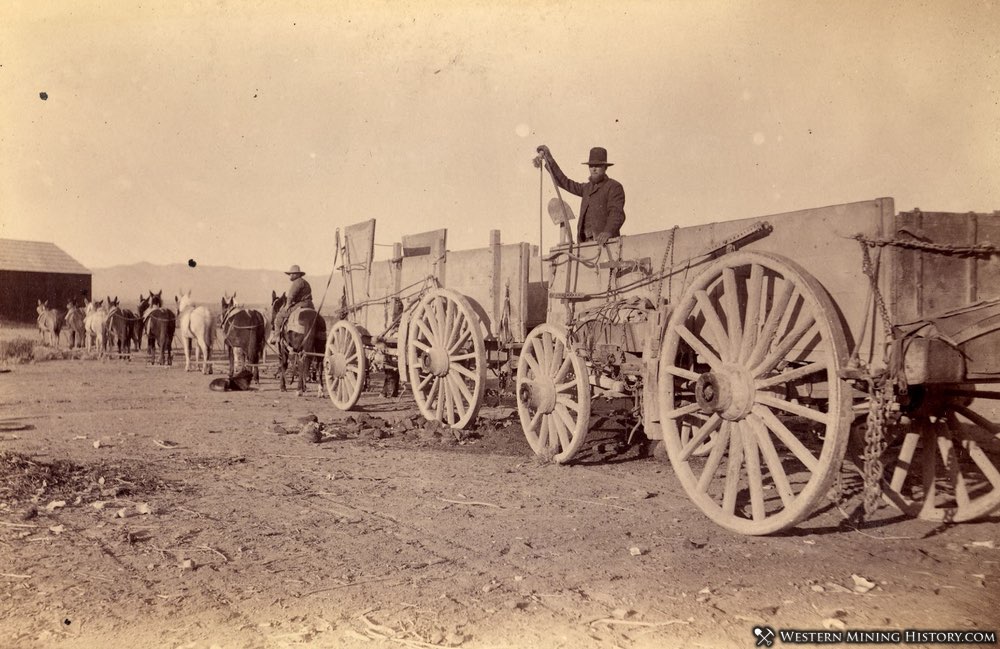
Typically drivers were loners, and might go days without seeing another human, a bath, decent food, or necessities. They slept in the open or under the wagons and most often the larger wagons, especially the ore wagons, had no place to sit, so the freighter rode on the last animal that was in harness or yoke. Some of the wagons had wooden bench seats but men often walked since it was easier on the body than the bouncing of the wagon.
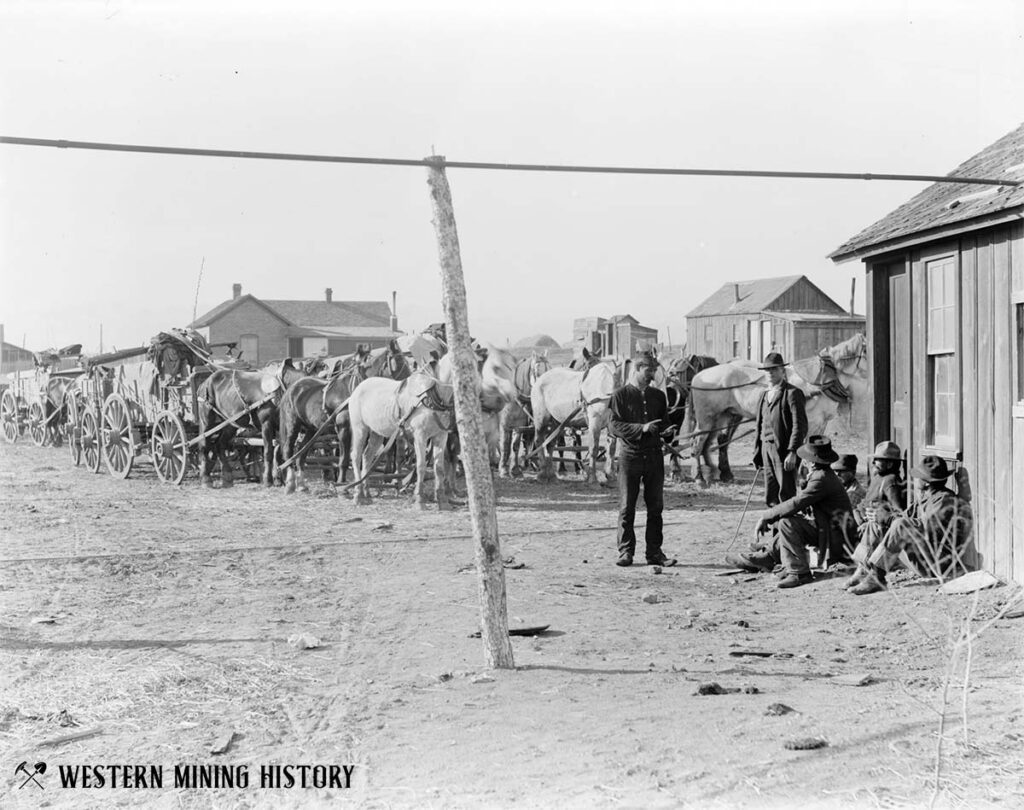
There were often no way stations, no pull offs, no places to safely seek shelter. Up until around the mid 1880, Indians were a menace and quite eager to attack a lone freight wagon and take the animals and goods.
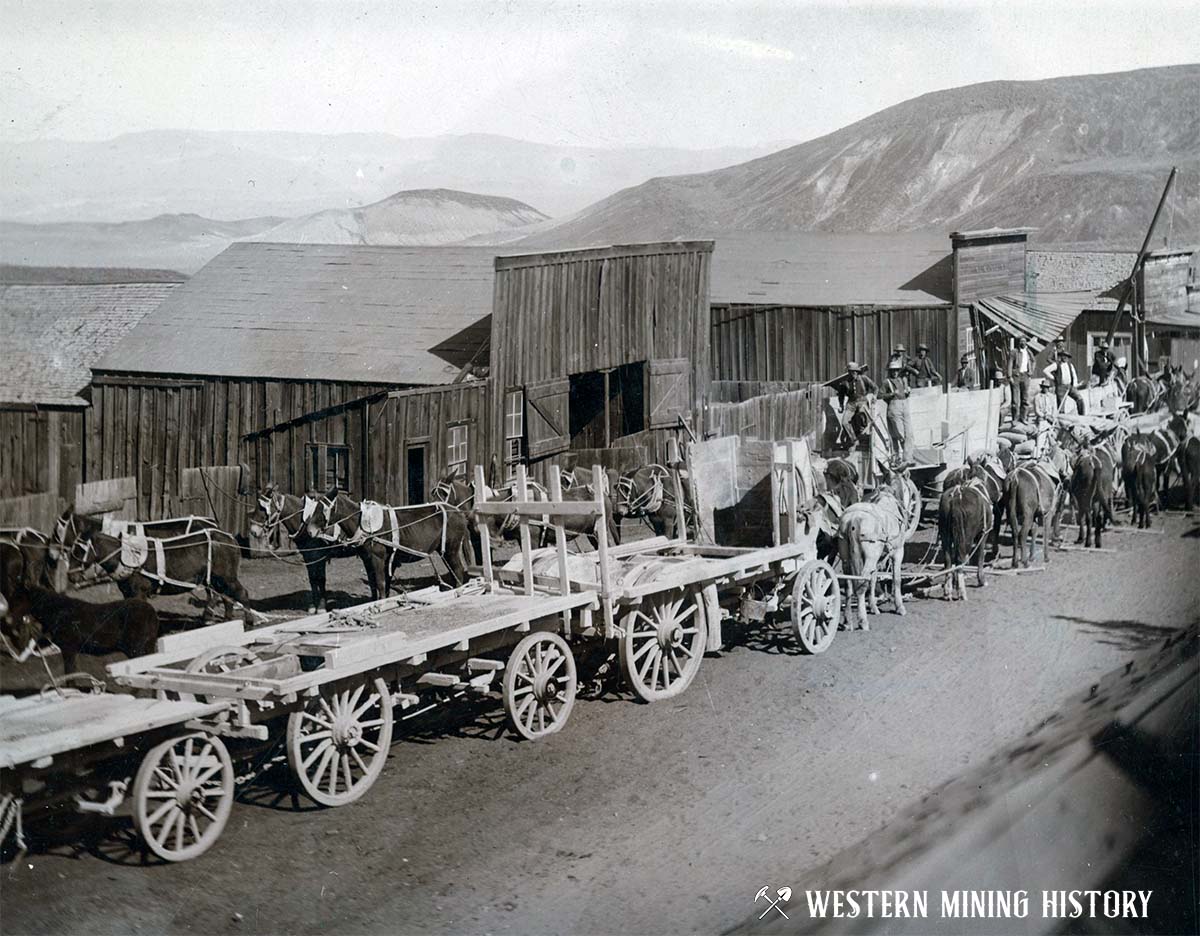
The teamsters usually traveled light carrying a hat, knife, rifle, and the clothes they wore including heavy boots. A rough and ready group, full of profanities and lack of social etiquette, their work day began early and ended late – taking care of the animals and feeding themselves. John Bratt, a bull whacker, said he only ever knew one who did not chew tobacco, swear or drink.
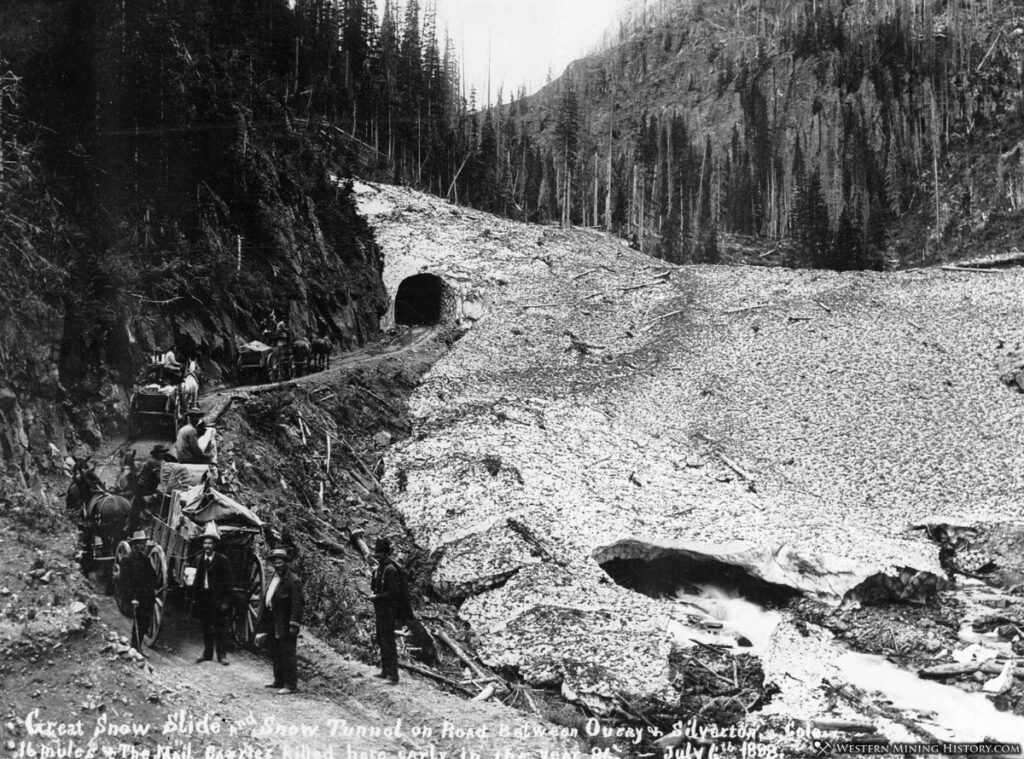
Their life on the trail and vices generally meant most were single and when they did have free time it was often spent on booze, gambling, and soiled doves. The pay of around $70-$80 a month for an experience hand was above that of common laborers or miners who generally got from $2.00-$3.50 a day. To put that in perspective, before the Civil War soldiers (privates) stationed in the West received no more than $15 a month.
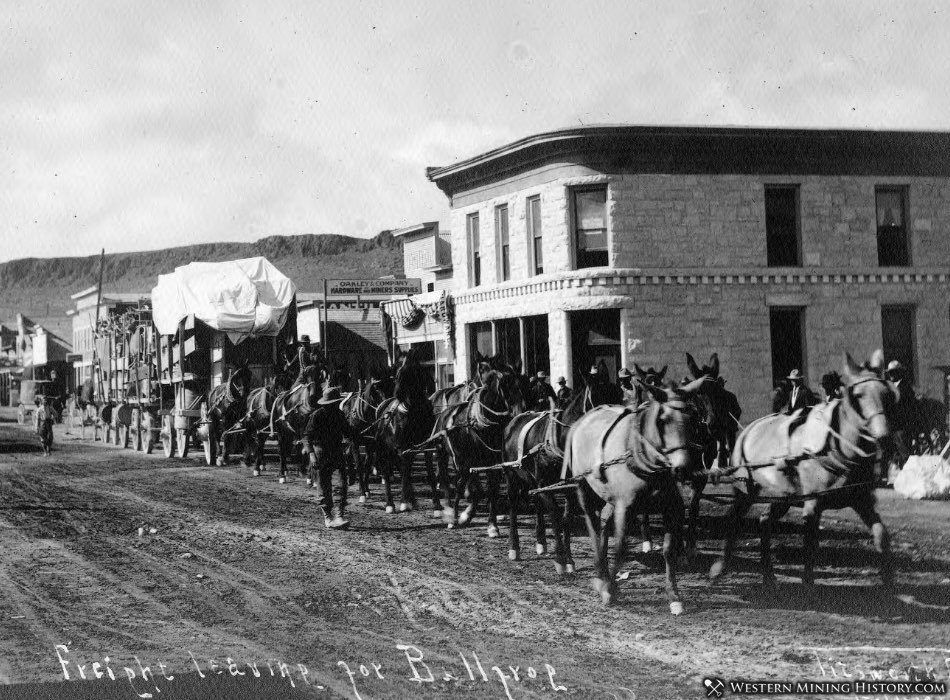
A typical charge to haul freight might be $8 to $10 per one hundred pounds but also depended on distance, dangers and difficulty. Large companies with many outfits on the road could do quite well. Russell, Majors and Waddell wagons once made $300,000 on one trip carrying supplies for the army.
The Earp brothers were often engaged in the freight trade, taking turns as “swampers” (helpers who generally assisted in loading and unloading) and drivers.
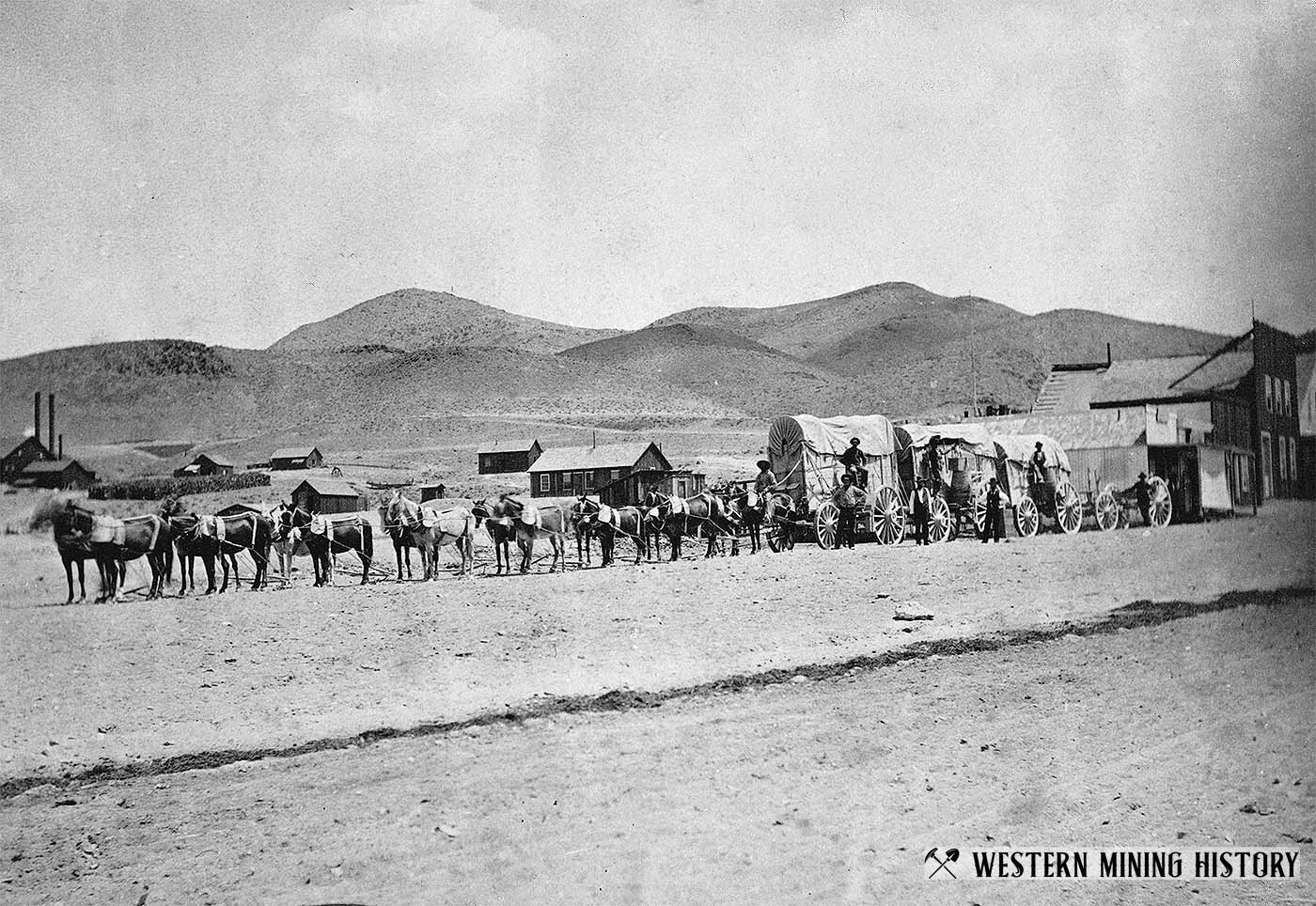
In deliveries to towns of any size there often was an area of town where the needs of the freighters, such as reshoeing and repairs, could be obtained. More often, especially on lonely, isolated stretches, the swamper and driver performed the chores. Fortunately the wagons were so carefully and sturdily built that despite the difficult conditions serious breakdowns were infrequent.
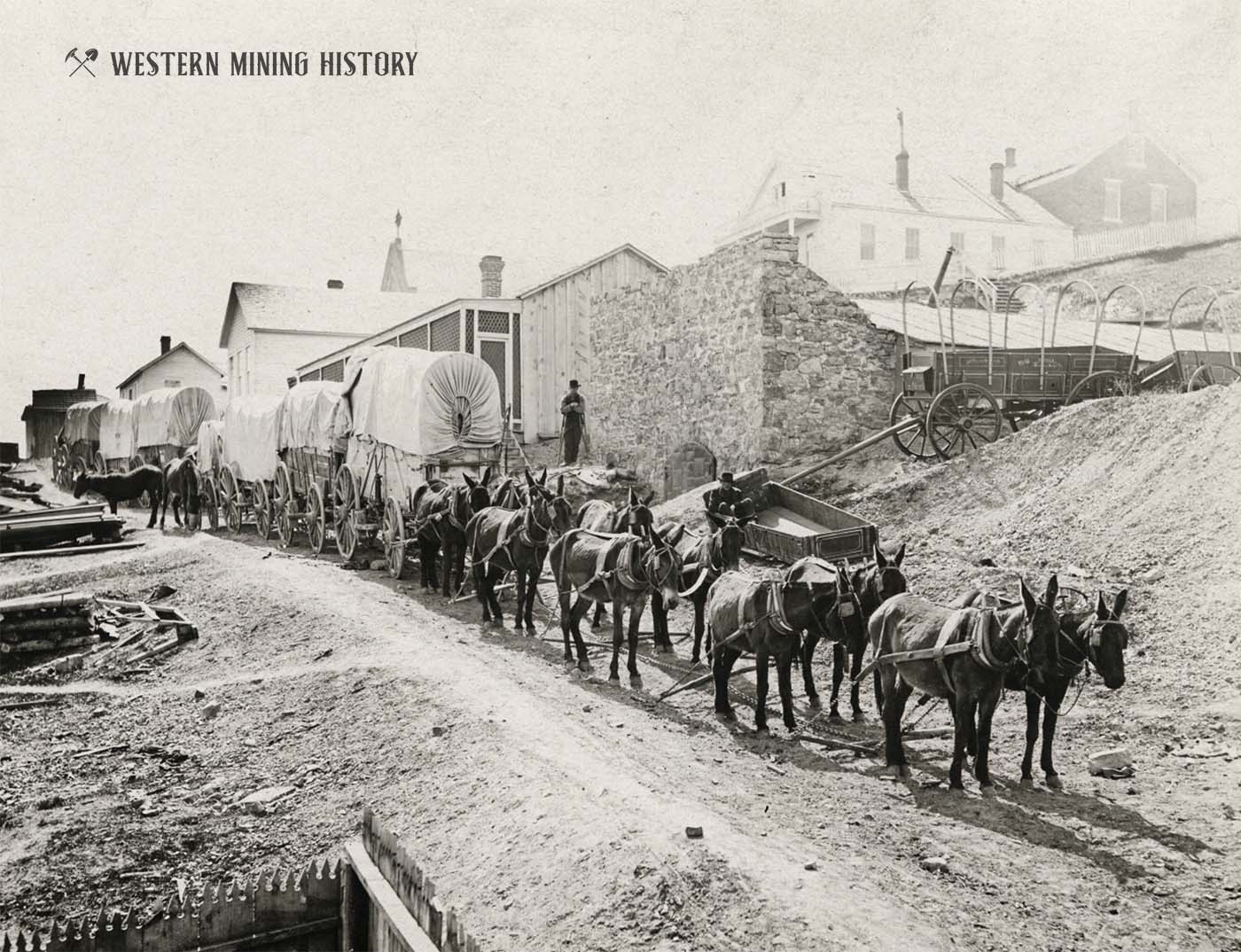
The Animals
As you might imagine the most important aspect of the trade were the animals. Oxen, mules, and horse were all put in harness and each contributed their own advantages and disadvantages.
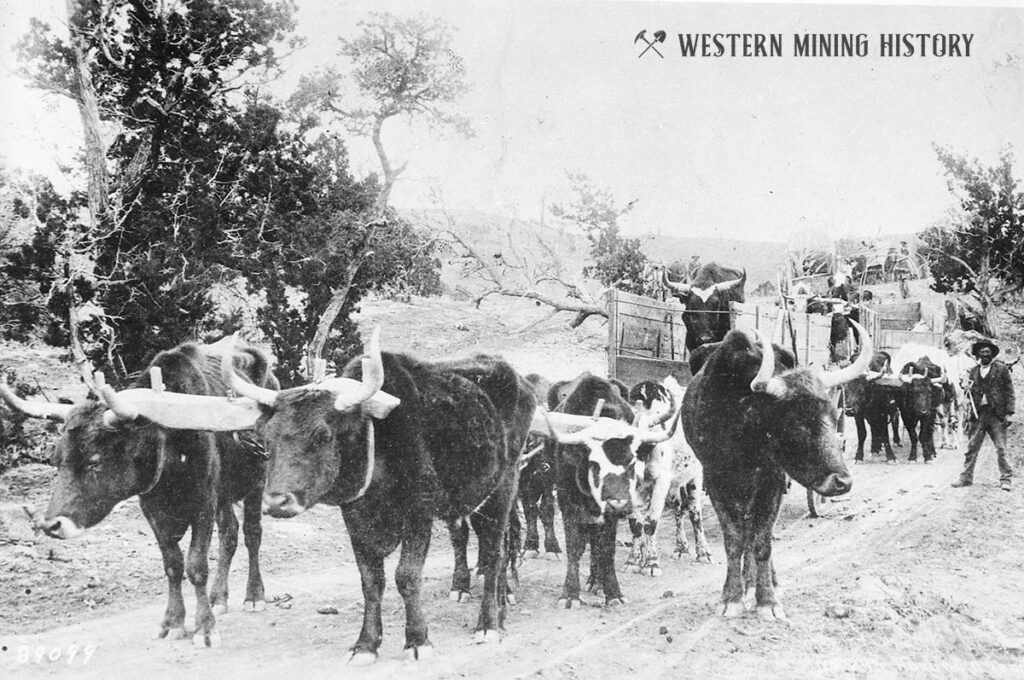
Oxen were much cheaper to buy (a pair for about $65 in the mid-1880’s) and could pull considerable weight. They needed less water and feed and often foraged off the land but were much slower than horses and mules. Travel by oxen was at an average of about two miles per hour, which was one-half to two-thirds the speed of a horse or mule.
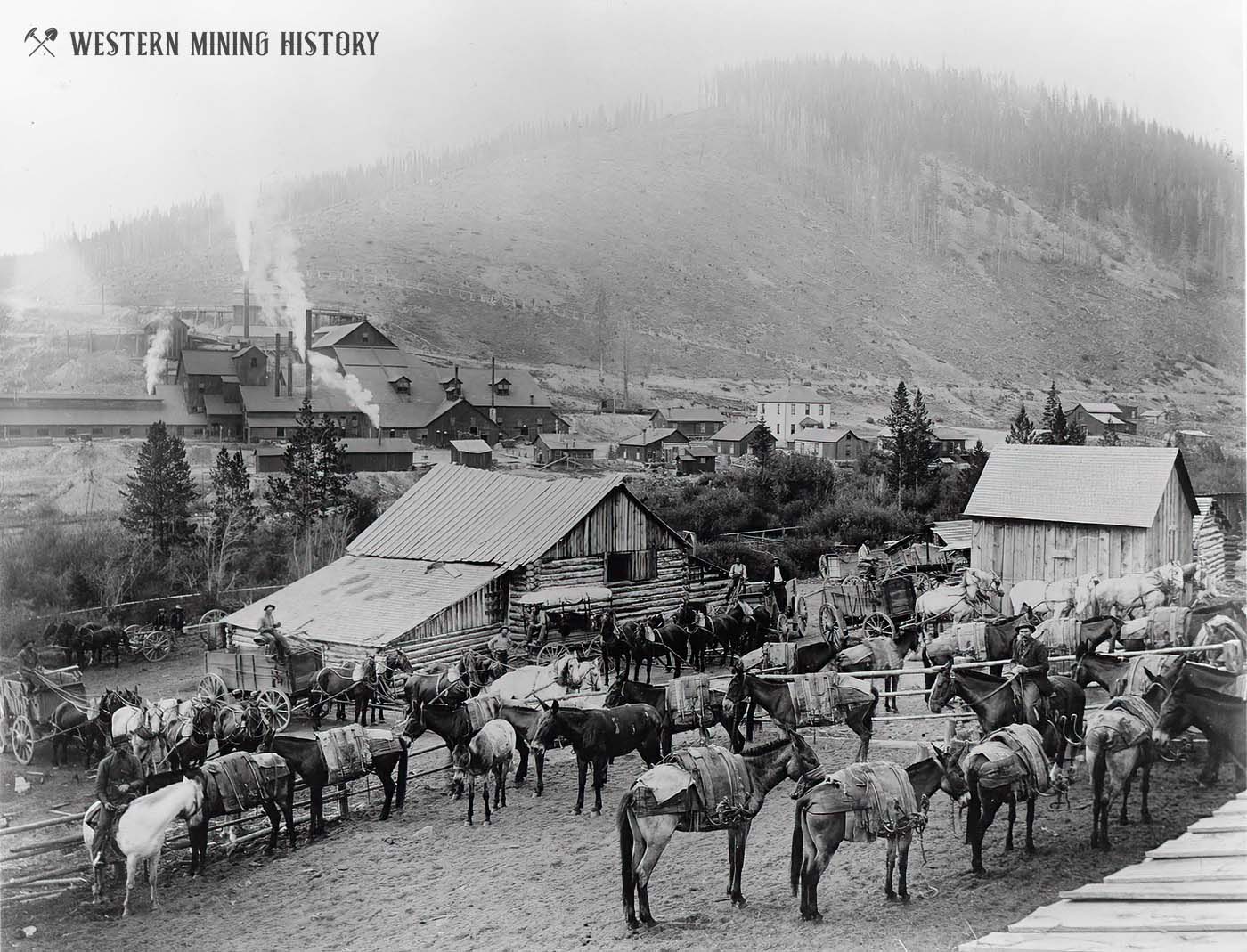
Big steers with horns were generally the choice for “oxen” with Texas “long horns” or big Durham’s often used. Horns helped to brace the steer on both the up and down hill. The bull whacker chose his stock with care and an experienced eye, not only because of cost but his safety and livelihood often depended on it.
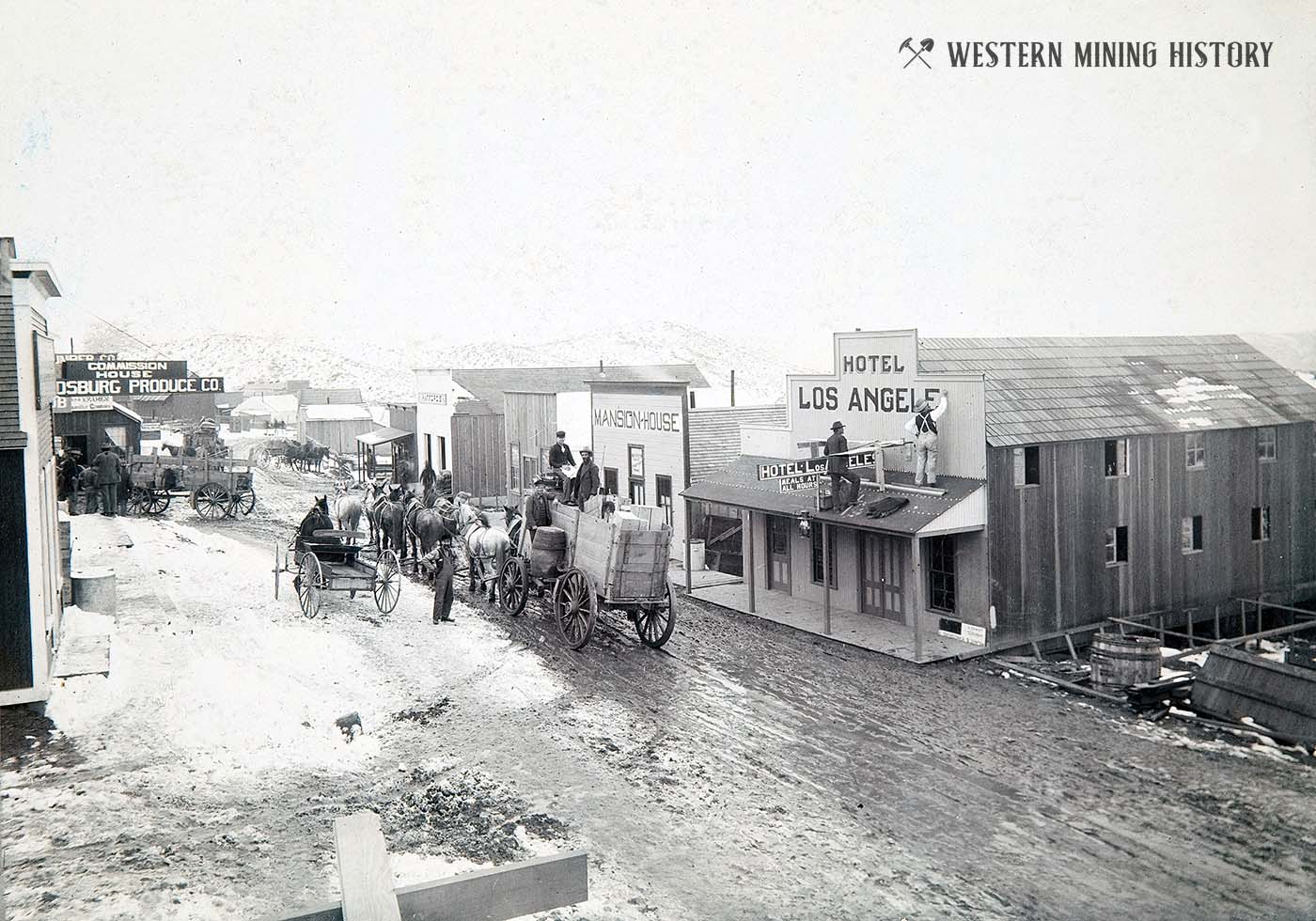
Horses and Mules were expected to pull their weight, thus the etymology of the phrase – “to pull your own weight”. A large mule or horse was typically judged to be able to pull one ton.
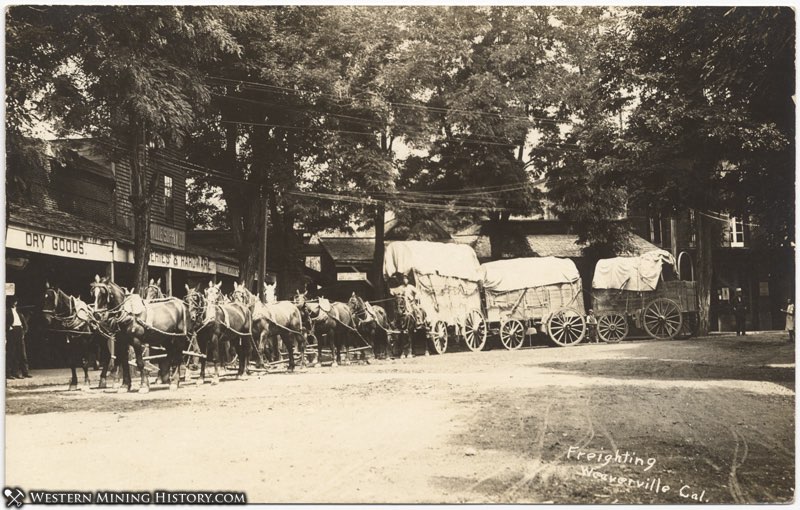
Wagons were loaded according to the number of horse or mules needed. A big mule could pull more than a ton and more than the average size horse. Mules and horses were more expensive than oxen with a pair of mules costing about $50 more than the average price for two horses (about $100-$150 in the mid 1800’s).
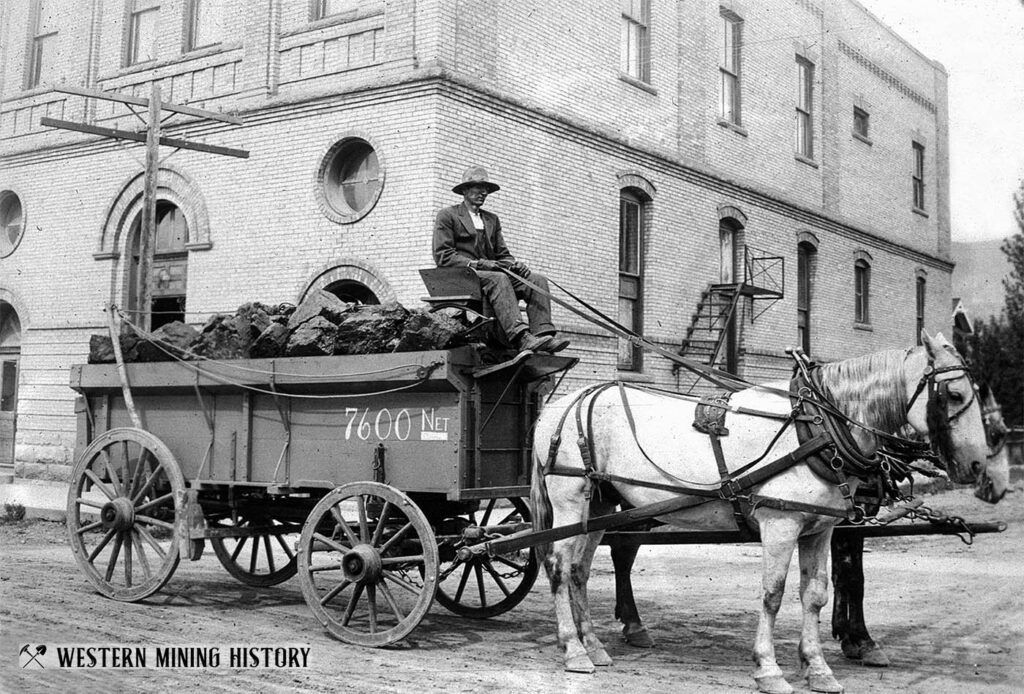
These animals could cover more ground than an oxen team but needed good feed and more water, which was not always available, especially in the Southwest. Mules and oxen were sure footed and often used over rugged and narrow terrain.
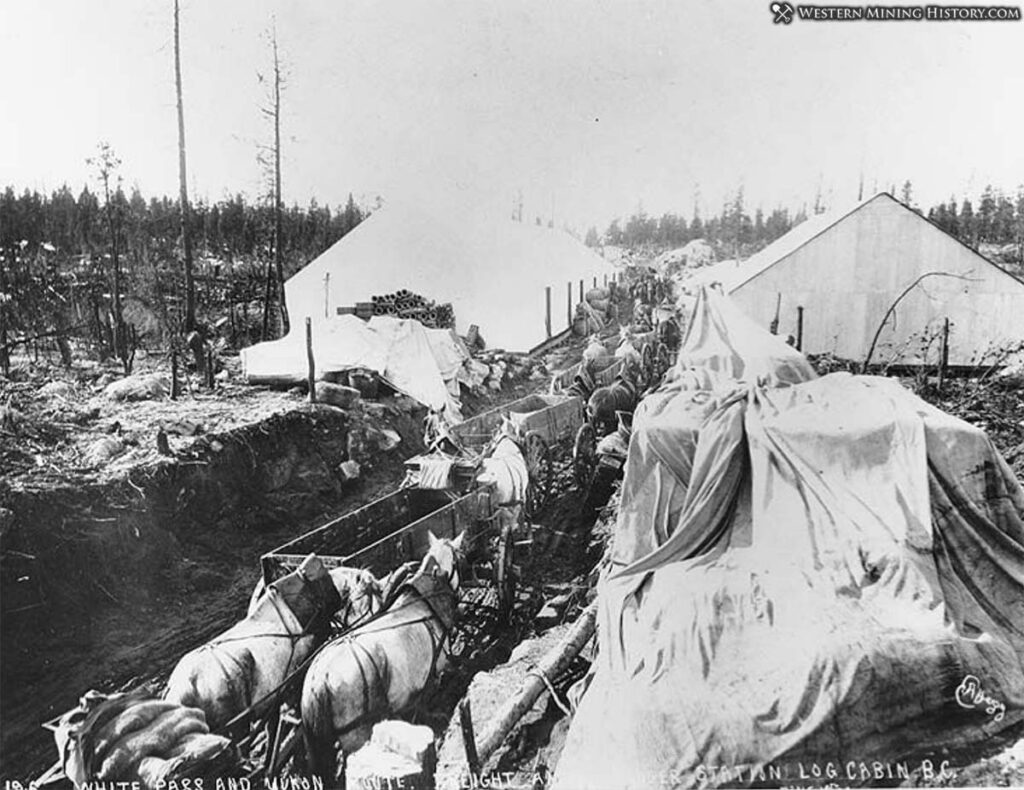
The Wagons and Freight
The immediate challenge was terrain, and the word “path” really speaks to the early routes covered by the big freight wagons more than calling them roads.
Rocks, washes, drop offs, mud during rainy weather, slides, dust, steep, treacherous climbs, narrow one-way paths and brake burning descents were the conditions that the driver and wagon needed to negotiate. Usually the only “road maintenance” was continued use which often rutted the trail.
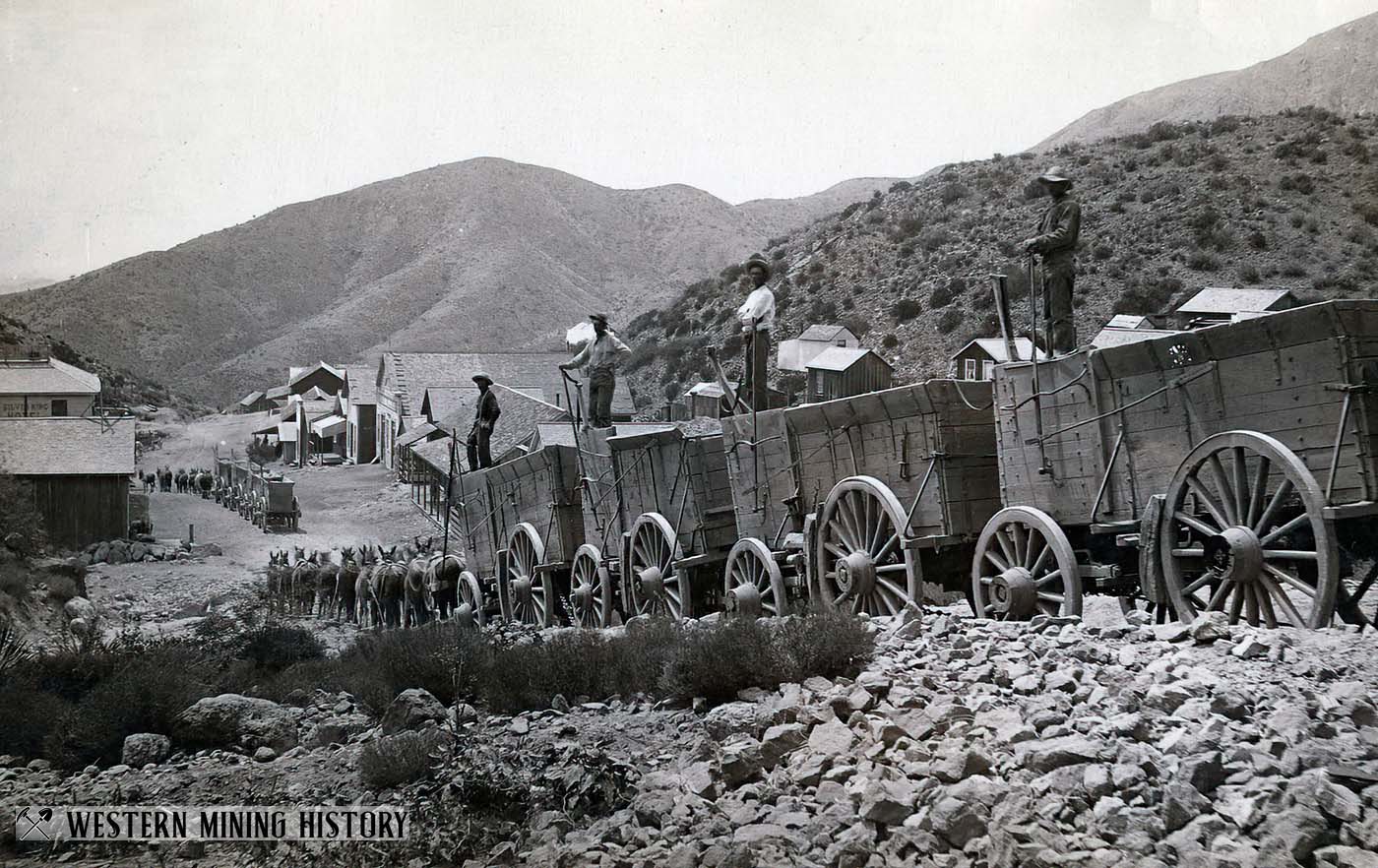
Today it often takes an all-terrain vehicle to reach some of the abandoned towns and old mining camps that were serviced by pioneer freight wagons.
Of necessity, the wagons were built for endurance, durability and carrying capacity. Under carriages were made of iron and the beds and wheels of oak or other durable wood. Dimensions varied, but empty wagons weighed from one ton up to the nearly 8,000 pounds for the big 20 Mule team Borax wagons which operated out of Death Valley.
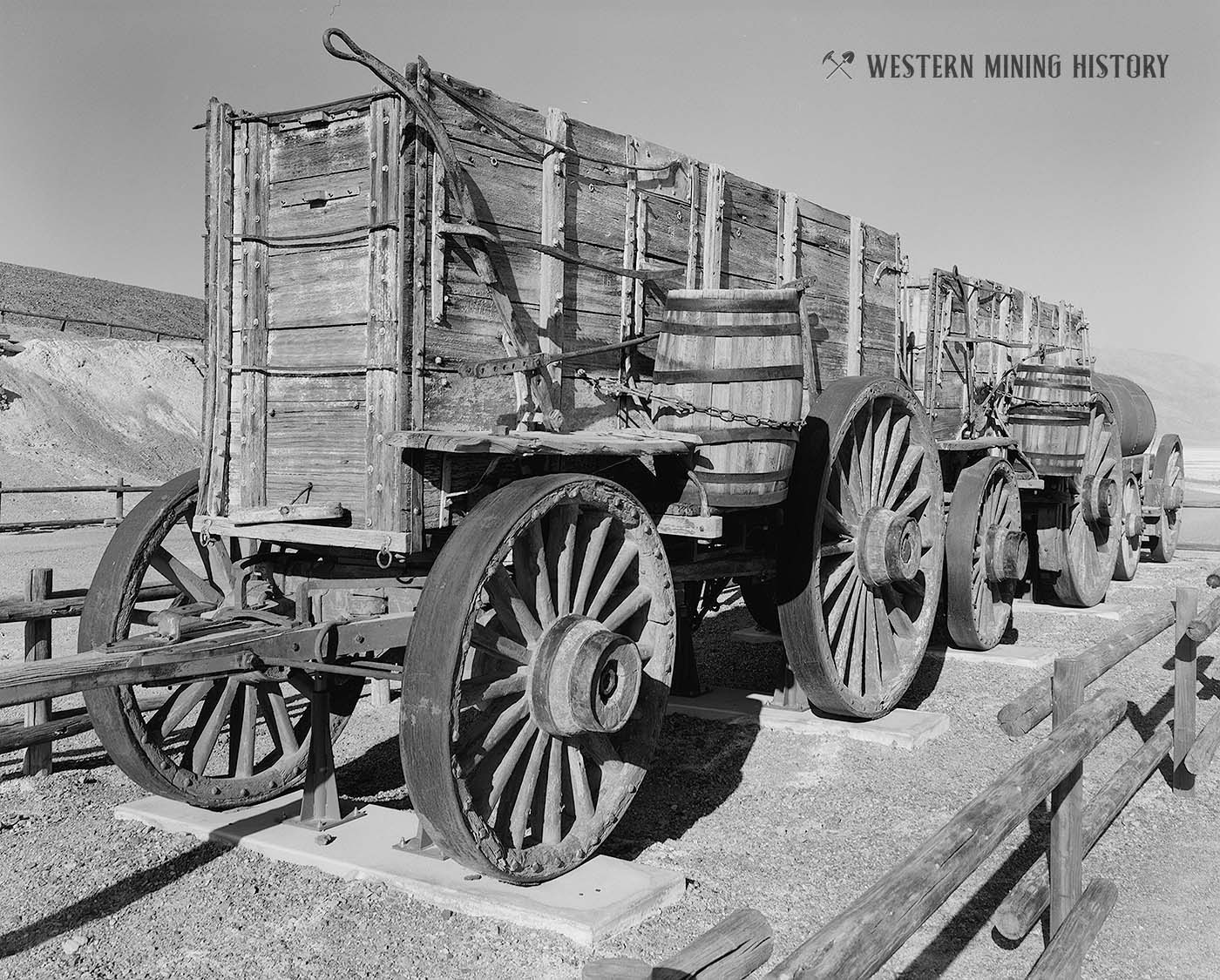
Freighters, depending on size and need usually hauled from three up to thirty plus tons of cargo.
The big Twenty Mule Team borax wagons that operated out of Death Valley were some of the largest at Sixteen feet long, four feet wide and six feet deep. They carried over thirty-five tons when loaded and had seven foot high rear wheels. Their customary route was from what is now the Furnace Creek Ranch area to the railhead at Mohave, some one hundred and sixty miles through the desert. It was generally a ten day trip.
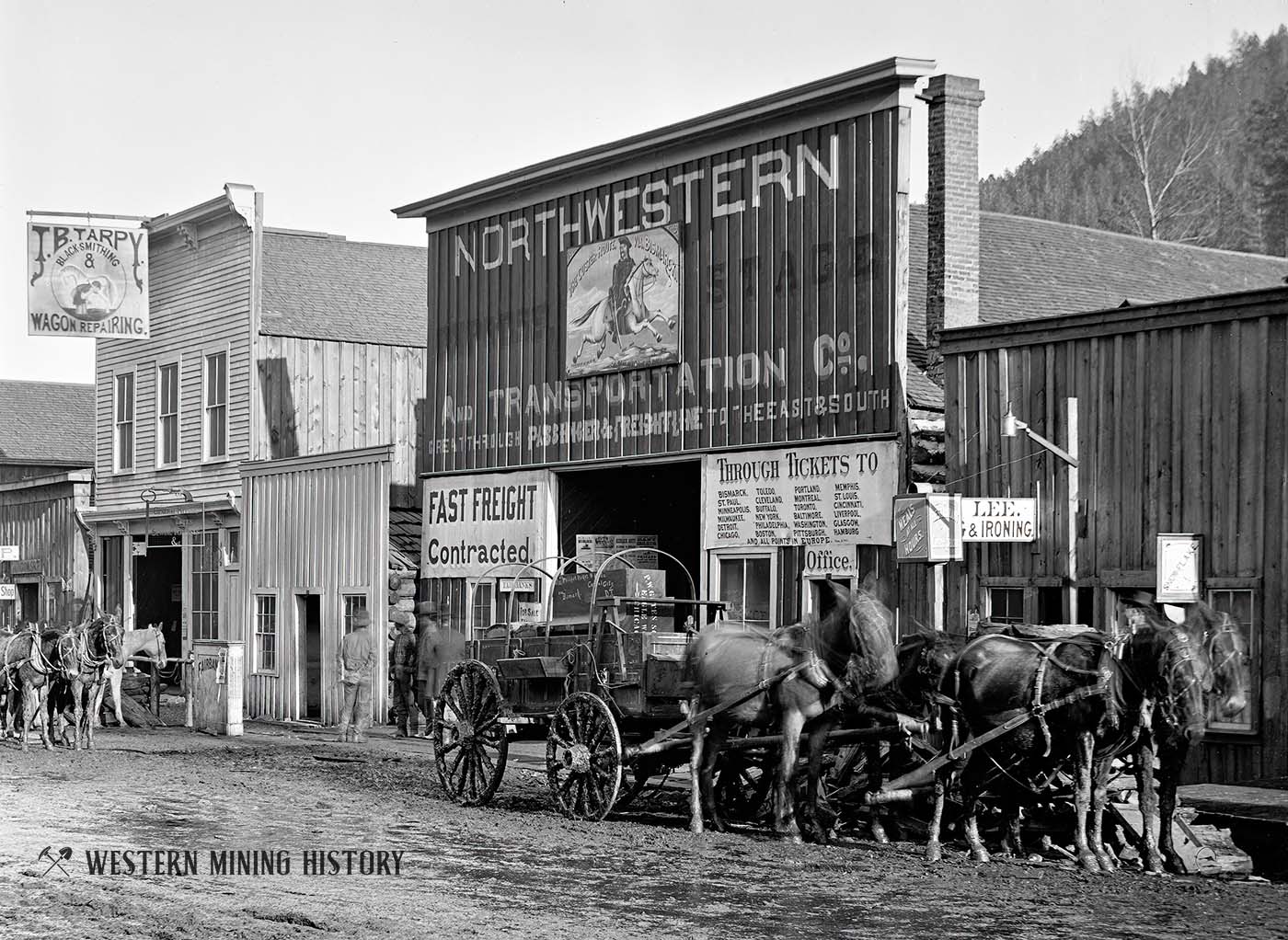
Overnight travel required the teamster to make provisions to carry water for himself and animals and perhaps feed as well. On long trips in dry areas or places with few streams, it was impossible to carry enough water so drivers needed to be aware of and plans stops at known springs and water holes.
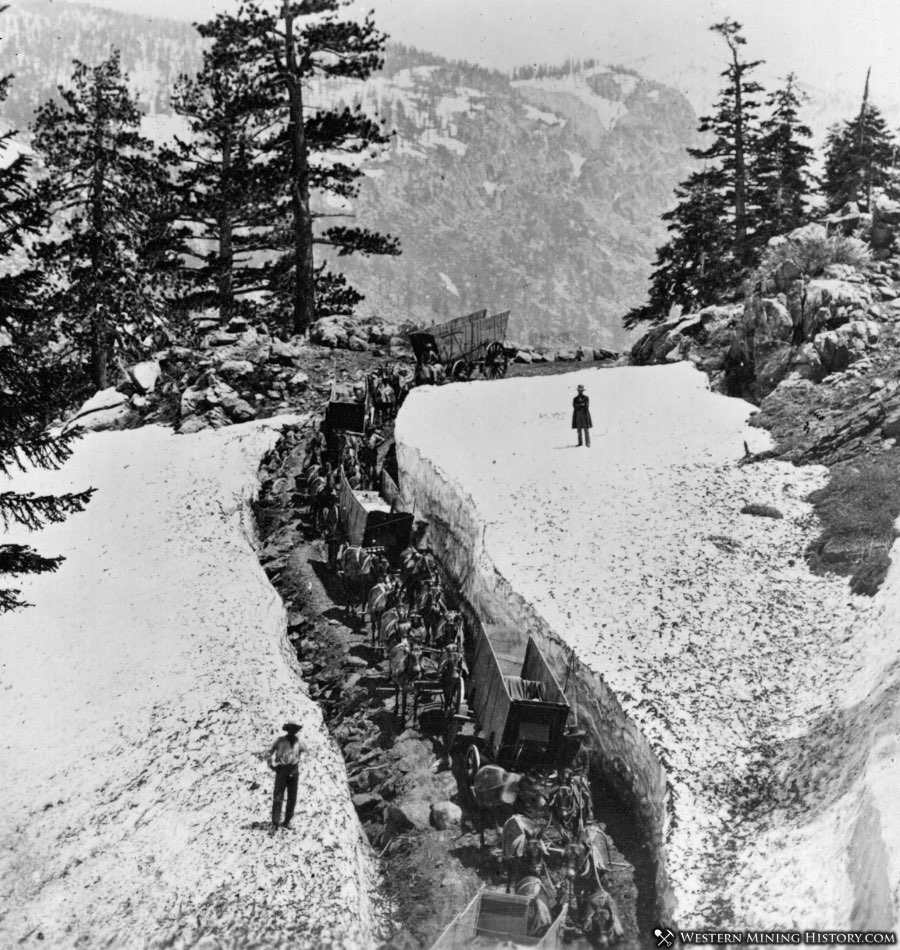
Stream crossings, especially in the spring, were traversed with great caution as unseen rocks, deep spots or an eroded soft bottom could cause problems for the animals and wagons. Likewise steep uphill grades often required the unhitching of one team and using it to help the other ascend and then repeating the process for the other wagon.
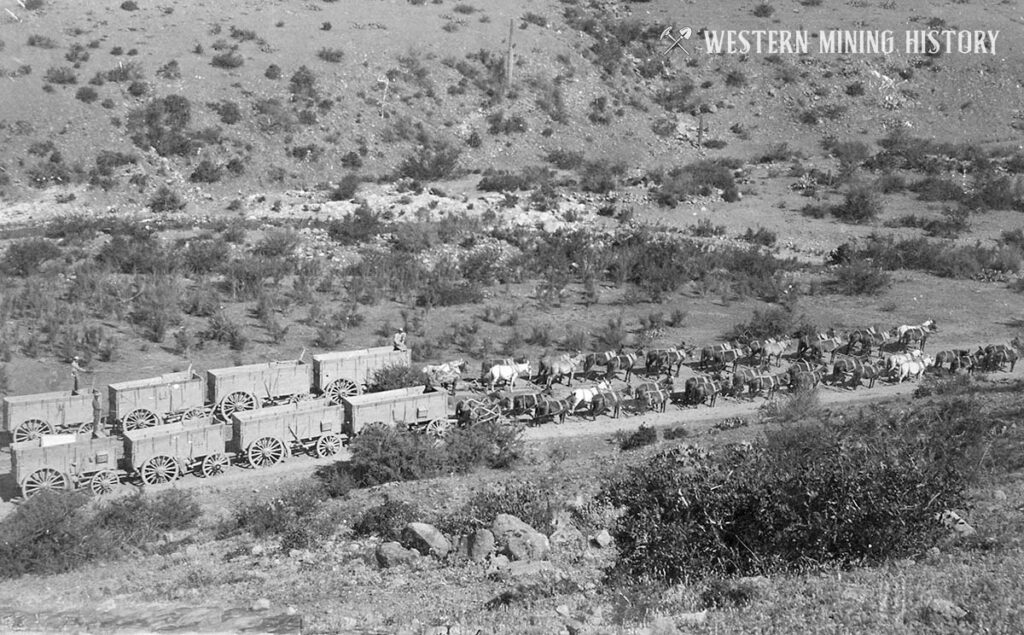
On one trip from Prescott to the Pima Villages in Arizona, the driver waited several days for the Gila River to recede and when it did not he built a raft, unloaded the goods, poled them over piecemeal and then drove the team and wagon across, reloaded and was on his way.
The freighters generally got their loads from the mines, in the form or ore to deliver, from steamboats that carried cargo, from big towns and manufacturers, or from the railroads delivering goods to towns like Denver, San Francisco, or other major stops throughout the West.
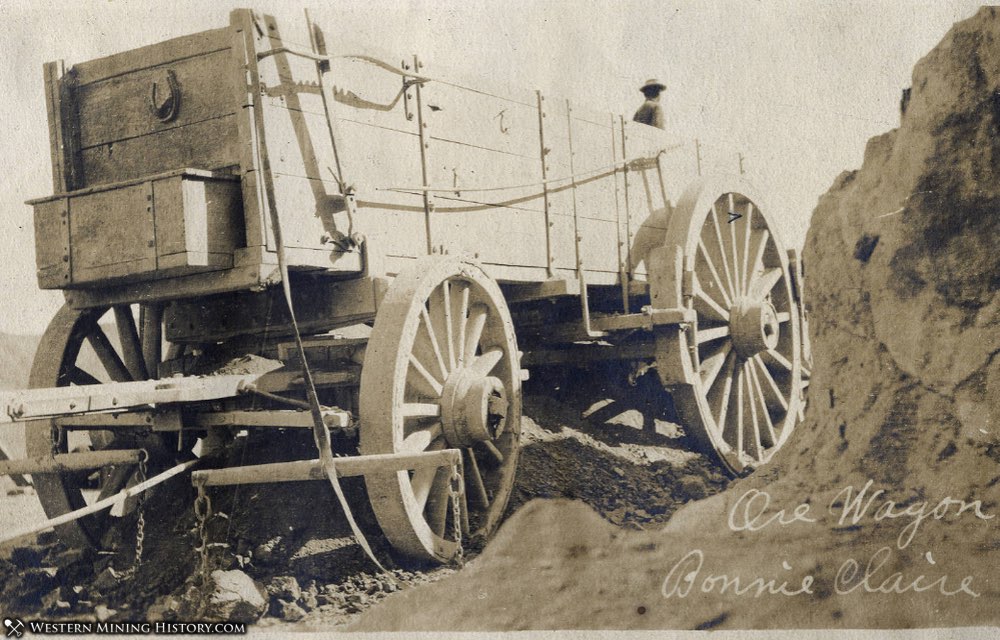
It was big business and newspapers were always reporting the arrival of freight – the “West Wind” made our landing last evening, loaded to her guards with a large quantity of freight and two crushers for the mine.
The arrival of a railroad provided not only an impetus for the growth of small towns but new ones often sprang up. There were plenty of spur lines (especially to mining centers) delivering and obtaining materials. The increased need for supplies resulted in fierce competition between freight companies.
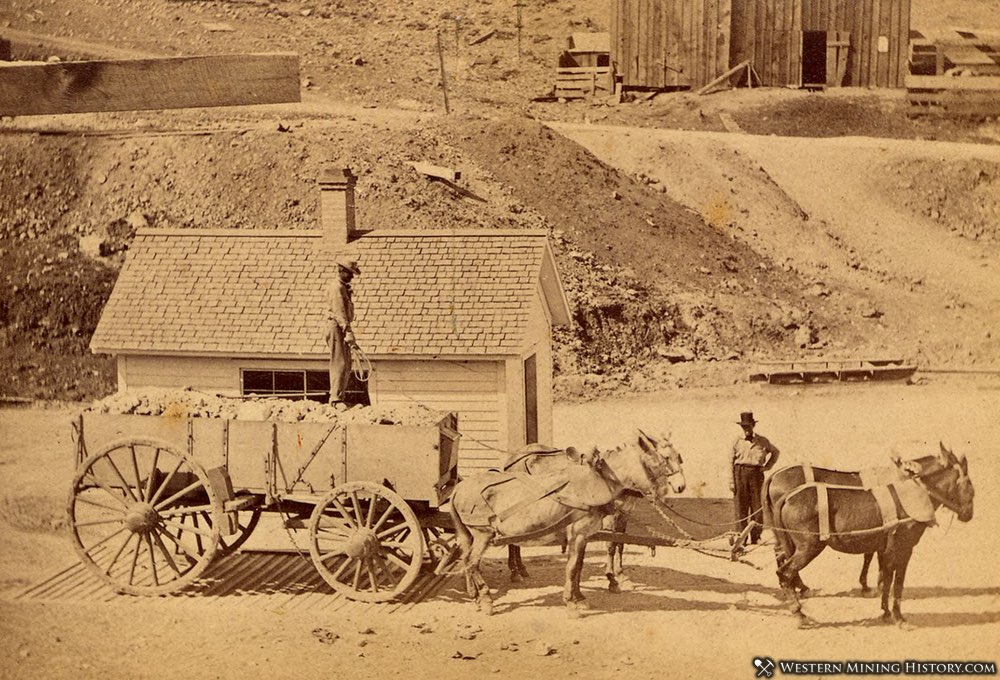
Military Contracts were some of the most sought after jobs. Once forts became more numerous, and many were in isolated areas, the army needed to be regularly resupplied. This created a consistent source of work and income and Army contracts often spanned a year.
It is hard to envision the number of departures and arrivals of large freight wagons. One paper stated that “the large freight wagons are constantly clogging the streets and last week 110 passed through, each one carrying an average of five thousand pounds.”
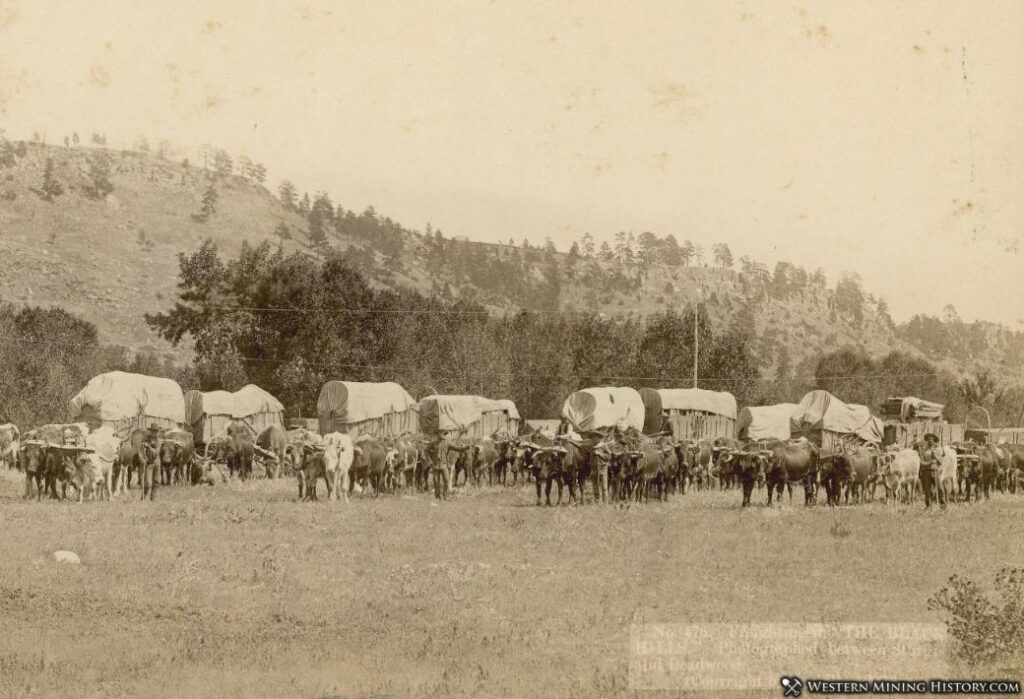
Large outfits generally had the larger contracts which called for a string of wagons, a dozen or more in line were not uncommon, this alignment worked best on well traveled roads as a breakdown in one of the front wagons on a rocky or narrow route could cause major problems. Large outfits traveling together provided much more protection and assistance for one another.
Weather might cause delays but was no deterrent when goods were needed or contracts were on the line.
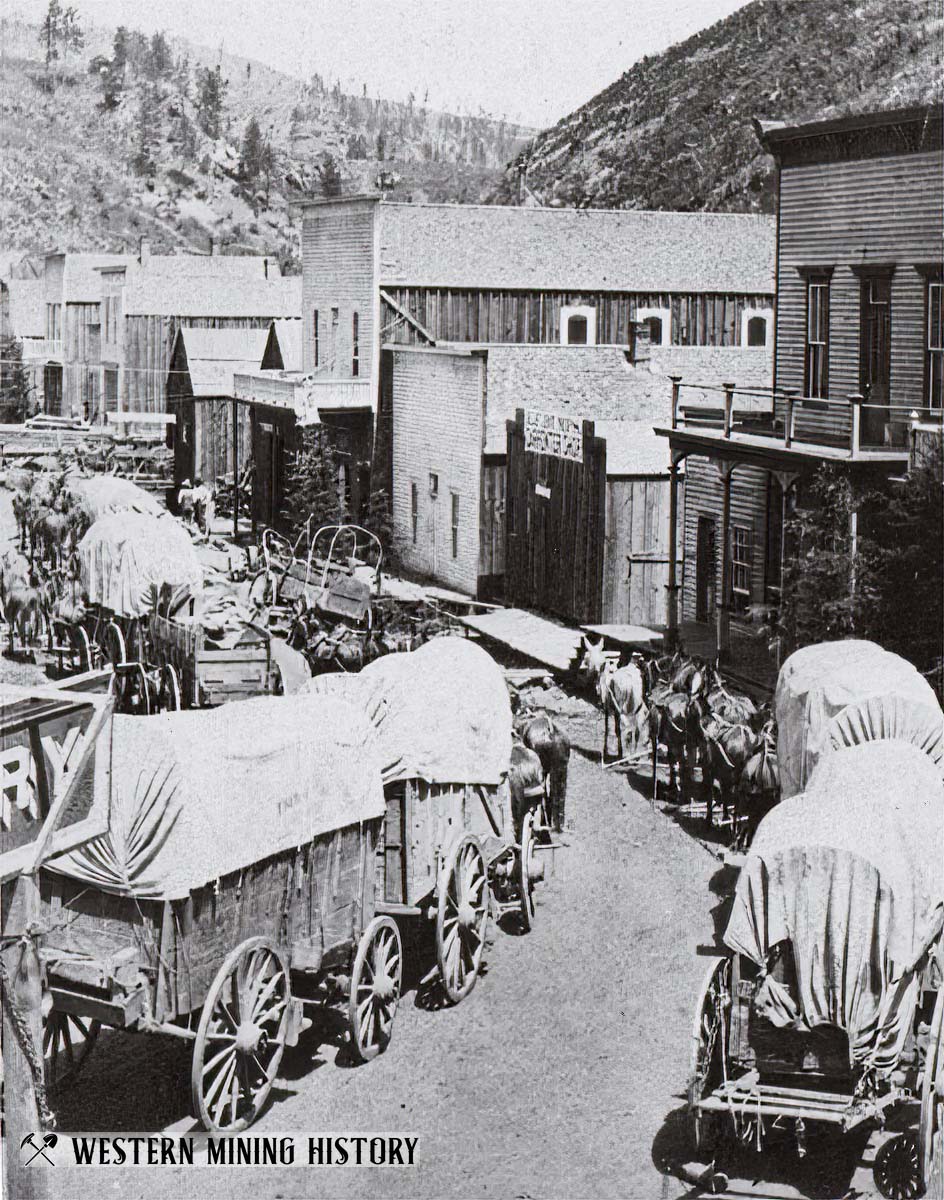
End of The Road
Large freight wagons gradually became victims of progress. Trucks, better and more roads, an increase in rail lines and service to smaller towns lessened the need for many of the big wagons.
As motorized vehicles became less expensive, more reliable, and plentiful, many companies, mining operations, and businesses acquired their own fleet of trucks for delivery. Smaller and more manageable wagons still worked the farms and delivered goods but as the road systems improved and reached more isolated spots, the large freighters became less seen and not needed.
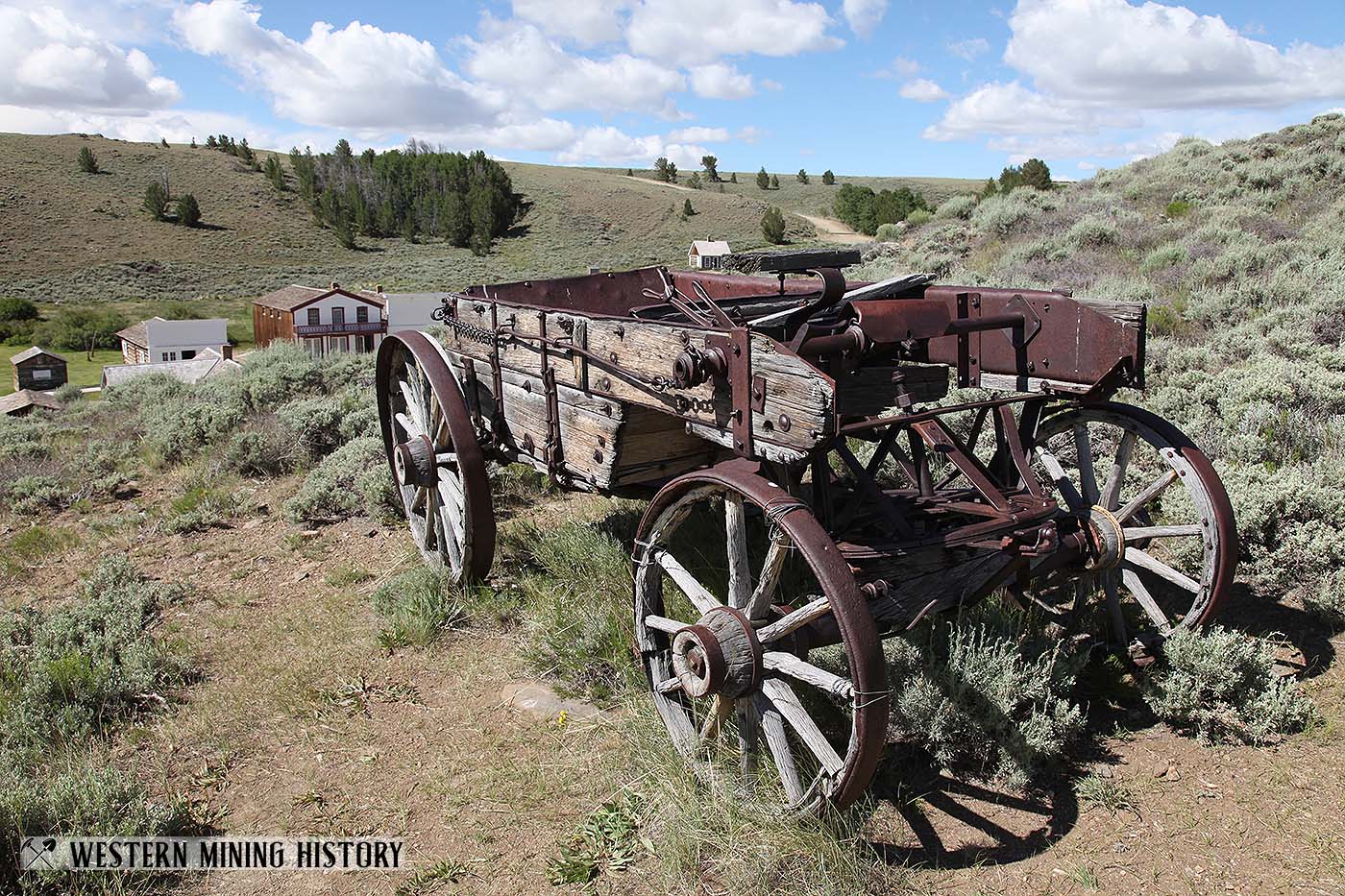
Trucking grew and slowly replaced wagons as the automobile replaced stages and carriages. By 1910 there were still only about ten thousand trucks in the entire country but by World War I and certainly by 1920 the proliferation of paved roads and trucks changed the freight industry.
The speed and service improvements meant the utilization of trucks to carry everything from gasoline to hay, which were more cost effective, quicker, more sanitary, and less cumbersome than using wagons.
Now one can find trucks to fit every need and service –from the giant Belazarus mining truck which can carry 450 tons at once to the small U. S P.S. truck that delivers your mail.
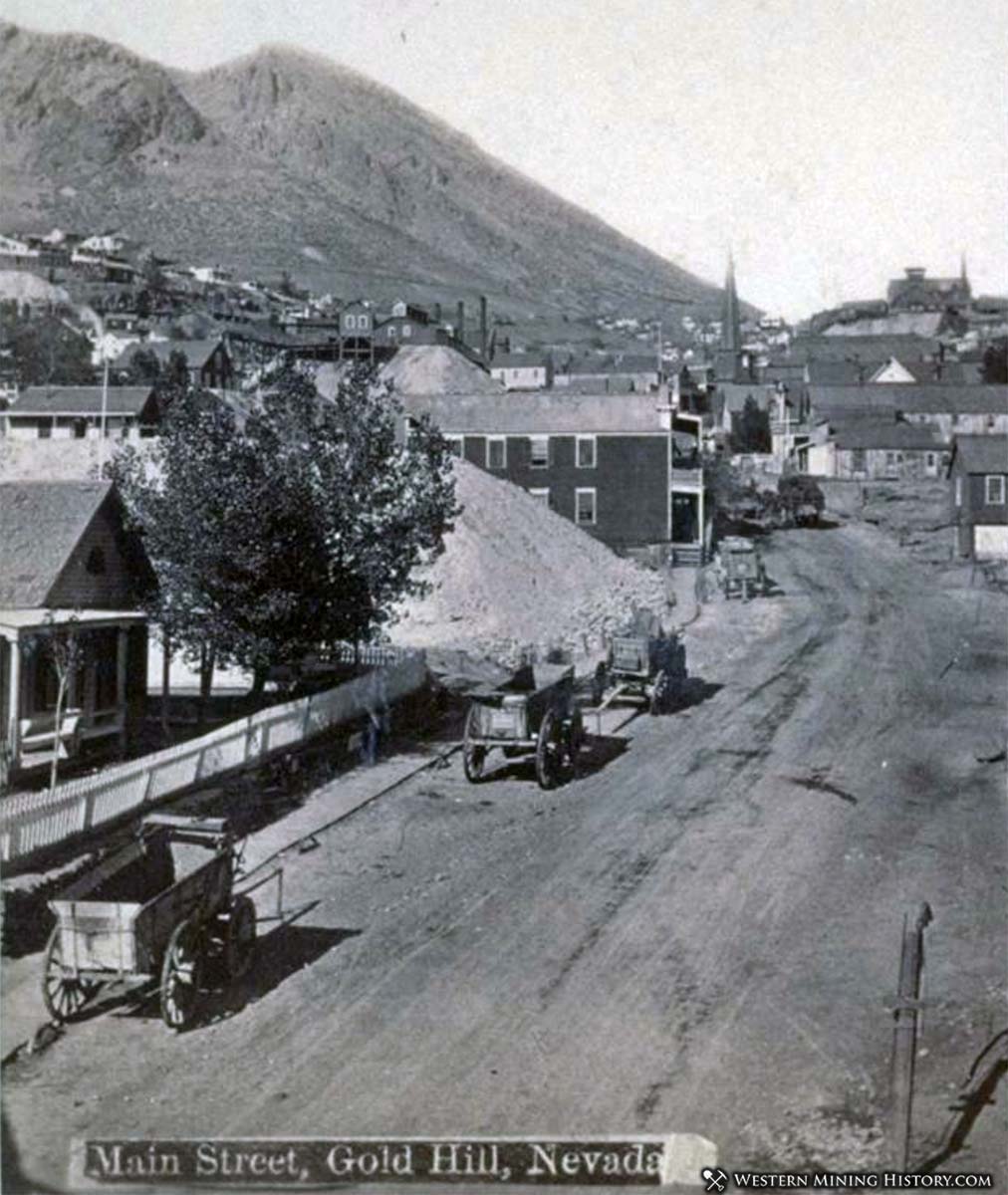
More Freight Wagons
There are many amazing photos of freight wagons at work hidden in various archives. As I run across them, I will add them here, so remember to check back to see how this collection grows over time.
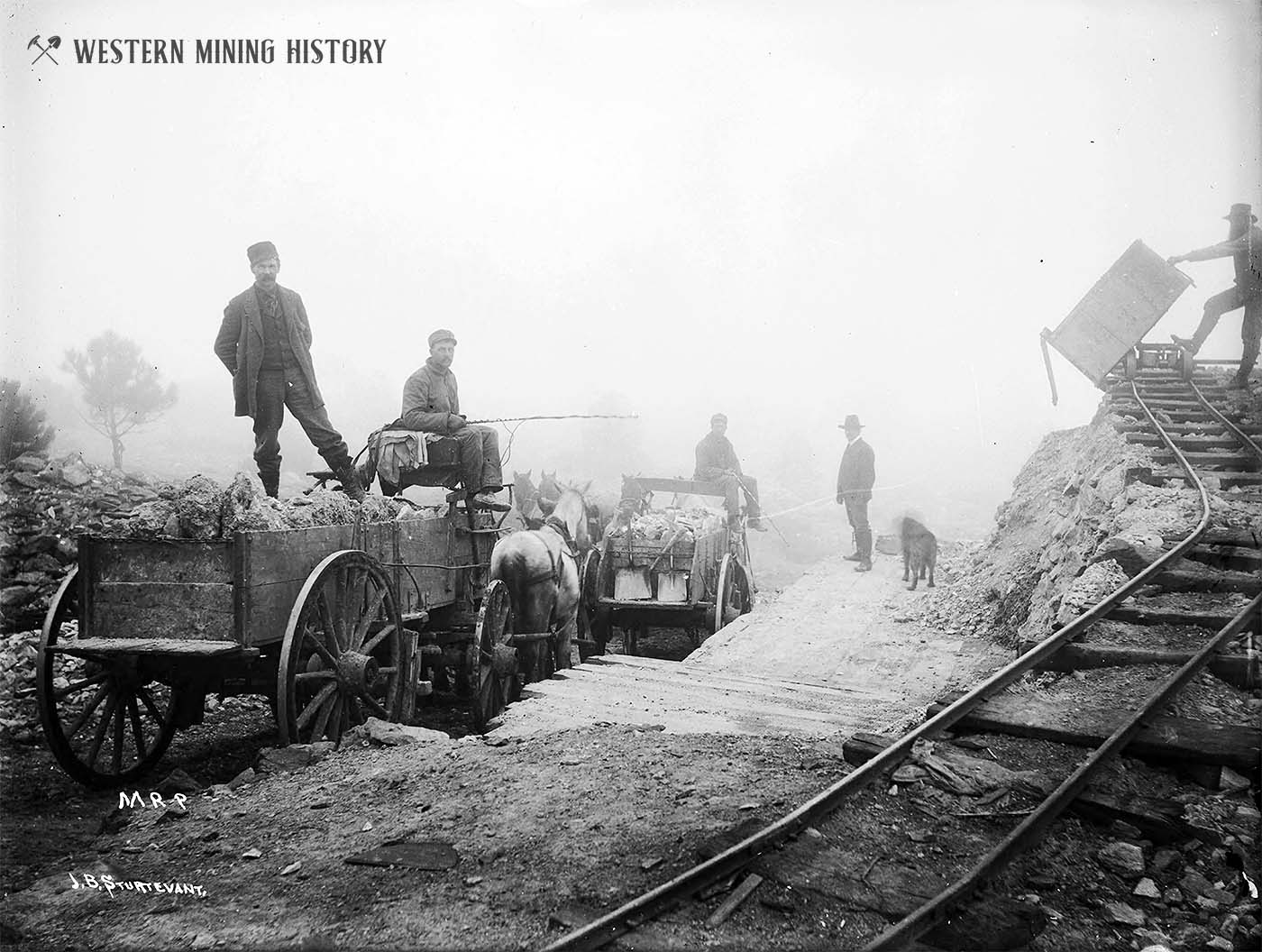
Related Articles
The following articles from Western Mining History explore more on the topics of freighting and transportation in the West.
The Twenty Mule Teams of Death Valley
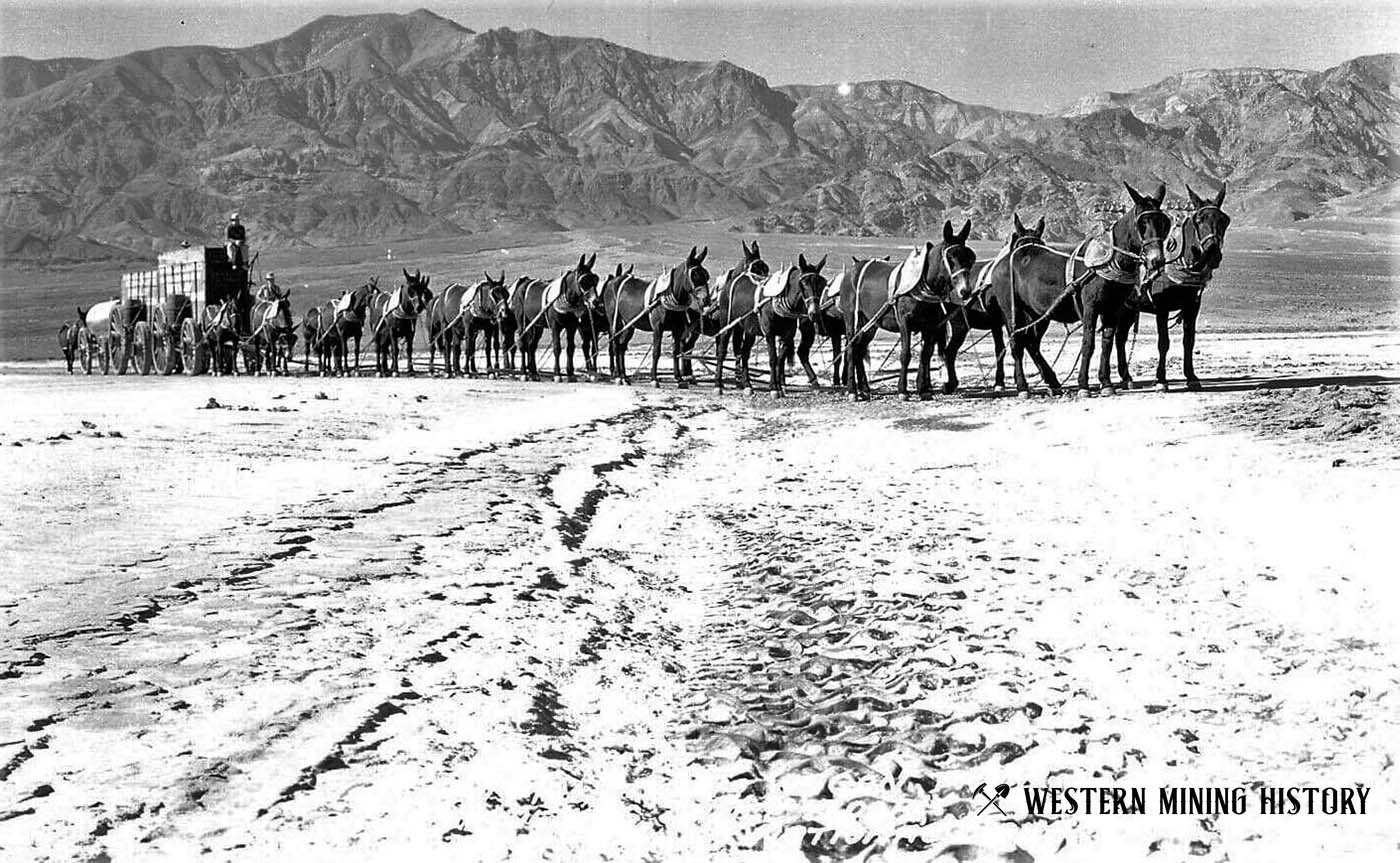
The Twenty Mule Teams of Death Valley presents text and diagrams from a series of reports by the Historic American Engineering Record. Included are historical images of these iconic western wagon teams.
The Impossible Road
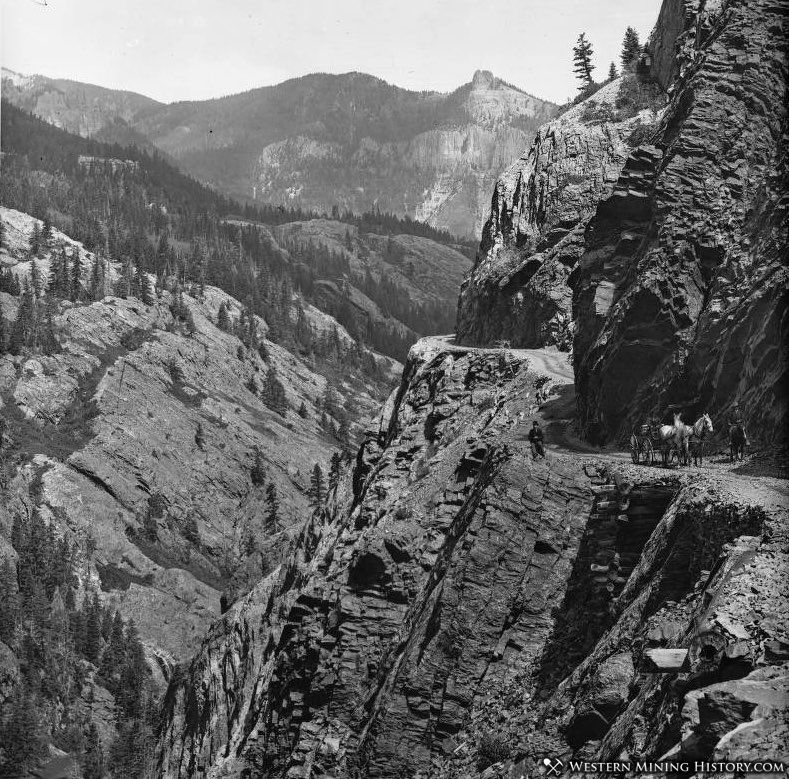
For years attempts were made at building a road between Ouray and Silverton, but these attempts were always a failure. Building the road was thought to be impossible by some, but by the mid 1880s Otto Mears, premier road builder of the region, was able to complete the job.
The Impossible Road: Incredible Photos of the Otto Mears Toll Road
Bibliography
GENi-Old West Teamsters and Freighters
History Net-“Though Bullwhackers often swore-etc”.-John Koster
HistoryTrailsWest.com—“Our Wagons”
Legends of America-Russell, Majors and Waddell
mulemuseum.org-Mule Teams and Freight Wagons
ouraynews.com—From Wagons to Apples-etc.,June 17,2020
Overland Freighting in the Platte Valley-1937-U. of NebraskaFloyd Bresee
The Story Behind Ketchum’s Famous Ore Wagons
Wagons on the Santa Fe Trail-Nat. Park Service-1997-Mark L. Gardner
Wheels that Won the West.com
National Parks Service – Twenty Mule Teams
Western Mining History is the work of Aaron Walton. About Western Mining History
Western Mining History needs you! Please consider becoming a member.
Western Mining History Memberships

Covered Wagons Heading West: Life on the Oregon Trail

Catherine Lugo
Amelia Stewart Knight knew the cross-country journey west would be a rough one; it was not for the weak or timid. The trip to Oregon would take at least four months; there were barren landscapes and tricky mountain passes to get through. As it turned out, that spring was especially rainy and the heavy wagon wheels kept bogging down in the many soft mudholes along the way. In her diary she recorded her daily events in an unadorned fashion, describing what it was like to travel the Oregon Trial:
(April 23, 1853) “Still in camp, it rained hard all night, and blew a hurricane almost, all the tents were blown down, and some wagons capsized, Evening it has been raining hard all day, everything is wet and muddy, One of the oxen missing, the boys have been hunting him all day. Dreary times, wet and muddy, and crowded in the tent, cold and wet and uncomfortable in the wagon no place for the poor children …”
Sometimes Amelia Stewart Knight and her family had to sleep “in wet beds, with their wet clothes on, without supper.”
Sick or well, Amelia had chores to do; and they were endless. Scrubbing and mending clothes, keeping watch over her seven children, preparing meals for her family of eight, (soon to be nine), and the five hired hands that traveled with them. Yes, she was pregnant with her eighth child during her time on the Oregon Trail. But even with all her responsibilities, she found time to write in her diary about the “ beautiful vallies, and dark green clad hills, with their ledges of rock, and then far away over them you can see Larimie peak, with her snow capt top…”
Even with all the hardships, Amelia’s story wasn’t much different from most of the folks traveling the Oregon Trail. Long wagon trains of families trekked across the plains, doing all they could to stay together in order to help each other. Struggling over treacherous mountain passes and parched deserts, the pioneers inched their way west in long, snaking wagon trains. The forerunners of the American dream lived through hail storms, pelting rain, muddy trails, lost livestock, and dreaded diseases like cholera, which caused excruciatingly painful death within hours.
Nowhere was the human struggle more poignantly played out than in the migration of settlers to the western United States in the 1800s. They came from Ohio, Illinois, Kentucky, and Tennessee, looking for the land of plenty in Oregon that they had heard about. They braved all that Mother Nature and life could throw at them; illness, accidents, and unthinkable hardships were just par for the course. Broken down wagons, scarce food and water, barren landscapes to trudge across, and hostile Natives were just some of the challenges they faced. Despite all this hardship and misery, new births , gorgeous scenery, weddings, and campfire dances were also part of their trek across the plains. Such things were recorded in the diaries of the women of the wagon as they inched across the new frontier; they were determined to outlast the Oregon Trail.

Their mode of transportation was the renowned covered wagon; the pickup truck of its day. What gave them the strength to carry on? It was the promise of fertile land and a new-found freedom. For some, it was the call of the wild, the promise of independence and a fresh start. This was their chance to forge new paths and create the original American dream. For others it was the lure of the California gold rush of 1848; gold fever was already at epidemic proportions by the time the pioneers began heading west. The Oregon Trail was a route blazed by fur traders. It went west along the Platte River in Nebraska, through the Rocky Mountains via the South Pass in Wyoming and then northwest to the Columbia River; the largest river in the Pacific Northwest.
Prairie Schooners
German immigrants built the first covered wagons around the year 1717 in the area near the Conestoga River in Pennsylvania, thus the name Conestoga Wagon. These wagons, also called “prairie schooners” were built extra sturdy and were able to haul up to six tons of freight. They were designed like a boat with both ends of the floor of the wagon curved up to prevent goods from falling out as the wagon bumped along rocky roads and through mountain passes. Thus, the name prairie schooner. The covering of the Conestoga wagon was a large piece of canvas soaked in oil to make it waterproof and then stretched over wooden hoops and secured to the bed of the wagon. Pioneer women spun the linen for the covers of the wagons themselves; they called the covers bonnets.
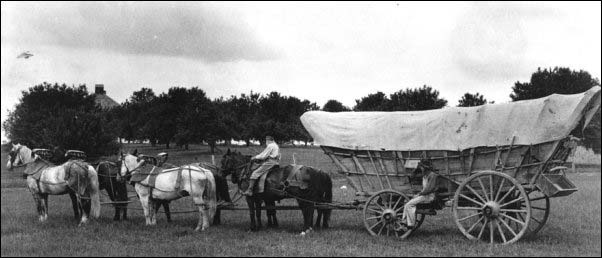
The Conestoga wagon is not the same as the covered wagon in that it was built much sturdier than the covered wagons that made their way west. Conestoga wagons were used mainly in Pennsylvania, Maryland, Ohio, and Virginia. The covered wagons that most folks went west in did not have the curved floors nor could they haul as much freight as the sturdy Conestoga’s. Still, the wagons that went west were built tough. The wagon wheels were made of hickory or oak and had rims of iron. The wagons had no brakes or springs, so the pioneers tied chains around the rear wheels to lock them or provide a drag whenever they had to go down steep hills; which they often did.
These sturdy wagons carried pioneer families and all their worldly goods across the uncharted terrain of America. Standing 7-8 feet tall and 10-15 feet long, the covered wagons of yesteryear were symbols of freedom. They were the vehicle that would carry the pioneers across the rugged terrain on their way to the building of America; and they had to be as tough as the pioneers who drove them.
Life on the Oregon Trail: Not Your Average Camping Trip
Traveling west in a covered wagon was truly one bold, daring and extraordinary journey for the pioneers of the 1800s. It was a grand life but a tough one. The promise of a better life drove them onward mile after grueling mile. At times, the trip probably seemed as impossible as the terrain was impassible. As they surveyed the lay of the land they must have felt overwhelmed; but their pioneer spirit pushed them to forge ahead. If it rained, they might only be able to travel one or two miles a day, due to washed-out trails.
Most covered wagon families could travel about 10-15 miles a day; carrying all that weight, it must have been agonizingly slow at times. Amelia Stewart Knight wrote in her diary on September 8, 1853, at the end of a long and treacherous day:
“ Traveled 14 miles over the worst road that was ever made, up and down very steep rough and rocky hills, through mud holes, twisting and winding round stumps, logs, and fallen trees. Now we are on the end of a log, now bounce down in a mud hole , now over a big root of a tree, or rock, then bang goes the other side of the wagon and woe to be whatever is inside .”
Families sometimes had to abandon their covered wagons along the way due to the roughness of the roads and make the rest of the trip on foot. Oxen were often chosen to pull the wagons because they were the strongest animals around. The oxen were controlled by an ox yoke; a curved wooden beam fitted to a pair of oxen so that they could work together pulling the covered wagons. Today, ox yokes are collected as primitive pieces of Americana. Oxen also had to be shod if they were to make it across the new frontier; so special shoes were forged of iron and carefully fitted to each ox. These shoes played an important role in the pioneer’s expansion of the new frontier; making it more likely that the pioneers would reach their destination.
Fields of magnificent wildflowers , rushing rivers, and breathtaking views awaited them along the way to the new land. But many times, the pioneer families had to go for days without water while traveling through open, often hostile, territory. Mothers gave their last swallow of water to their children; fathers worried as parched oxen trudged ahead. But the pioneers were hardy people and most of them persevered until water was found. They often had to lighten the load of the wagon by discarding items along the road or getting out of the wagon and walking along beside it. It’s said that the Oregon Trail was littered with the clothes, dishes, and furniture the pioneers had to leave behind to lighten the load as the trail became rougher and the oxen wearier for lack of water or food.
Keturah Belknap wrote in her diary along the trail: “Will start with some old clothes on and when we can’t wear them any longer will leave them on the road.”
“Use it up, wear it out, make it do, or do without.”
This was the motto that dictated the lives of the people traveling west to the new frontier. The pioneers had to be very careful how they packed their wagons. They didn’t want to overload them and make it impossible for the oxen to pull the wagon; the maximum weight the wagons could hold was 2,000 to 2,500 pounds. A well-stocked wagon could mean the difference between life and death as they traveled through stark and unfamiliar lands. The typical journey lasted four to six months and the wagons had to hold enough provisions for the entire family for the long trip.
Some of the things the pioneers had to carry included tools like shovels, hammers, axes, rope and grinding stones. Personal items would include clothing, rifles, knives , toys, and of course the family Bible. Food may have been the thing that took up the most weight. A large amount of flour was required, at least 200 pounds for each person of the family, and each family carried at least 50 gallons of water. Other necessities were bacon, rice, coffee, sugar, salt, beans, and cornmeal. Food had to be rationed very carefully along the way, as did the water; they never knew when they would find a lake or spring along the way. In addition to all the above, the pioneers carried household goods like coffee grinders, butter churns, bedding, spinning wheels, rocking chairs, cradles, buckets, Dutch ovens , and eating utensils. Wisely making use of every square inch of space, they attached hooks to the hoops inside the wagon to hold clothes, buckets, weapons, etc.

Pioneer woman Margaret Frink wrote in her diary: “The wagon was lined with green cloth, to make it pleasant and soft for the eye, with three or four large pockets on each side, to hold many little conveniences–looking glasses, combs, brushes, and so on.” So, as you can see, the pioneers were experts at making use of every little bit of space; they made their supplies last and they were also tough enough to outlast the Oregon Trail. They kept their eyes on the prize all the way across the country through countless, unthinkable trials and tribulations; and they laid the groundwork for the American dream; for the generations of Americans and immigrants that would one day follow in their footsteps.
Check out another pioneer woman: Matilda Jackson: Making a Home on the Last Frontier
Mollie Dorsey Sanford: Frontier Wife, Frontier Life
https://www.homestead.org/homesteading-history/mountain-men/
That is a wonderful and informative article on traveling in a covered wagon. Reading it gave me the feel of what the days were like, and also the choices that faced each traveler as to what to stock in the wagons. A portrait of the strong stock and dedication is also seen. Pioneers faced horrible weather on trails through the wilderness, not roads of any type. I wonder how they crossed the mountains. Was there a pass that let them through and how treacherous the journey must have been. What great dedication and also a great fellowship to accomplish the journey seems to have been the thread of success. Thank you so much for this article.
Leave a Reply Cancel reply
Your email address will not be published. Required fields are marked *
Notify me via e-mail if anyone answers my comment.
I consent to Homestead.org collecting and storing the data I submit in this form. (Privacy Policy) *
Notify me by email when the comment gets approved.
Notify me of followup comments via e-mail. You can also subscribe without commenting.
This site uses Akismet to reduce spam. Learn how your comment data is processed .
Why did so many Western-bound wagon trains use oxen instead or horses of mules?
by Marshall Trimble | Aug 1, 2001 | Inside History
Joshua Young Star Valley, Arizona
Oxen were slower than mules or horses, but they had their advantages, such as they ate less, required less care, and they could pull heavier loads. And while a mule or horse could cost $90, an ox could be bought for about $50.
Related Articles
Why did Mountain Men prefer riding mules over horses? And how come the Indians never…
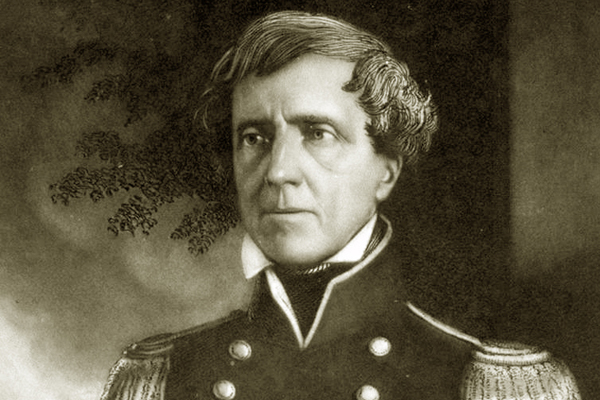
Stephen W. Kearny played a big role in the conquest and settlement of the West.…
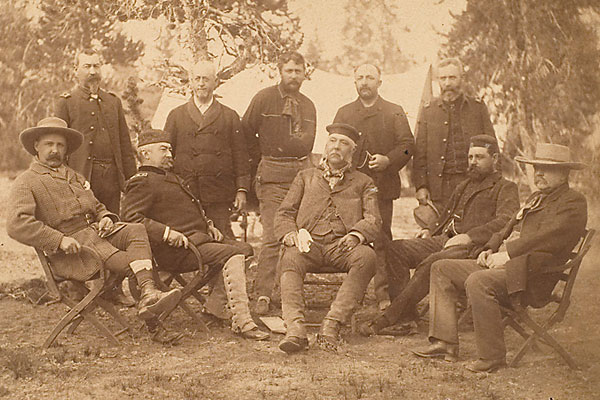
Chester A. Arthur is the only U.S. president to make an extensive overland march, mostly…

In This Issue:
- Discover the West!
- Tom Mix’s Last Sundown
- A Deadly Duel at 500 Yards
- The Last Hurrah
- Custer Almost Kills Curtis
- Bass Reeves Finally Gets His Due
Western Books & Movies
- In Search of the Real Bass Reeves
- Tucson Book Festival
- Grit and Grace
To The Point
- Brothers From Another Mother
More In This Issue
- What History Has Taught Me with Terrence Moore
- Doc Holliday, Reward Money and Fast-Draw
- Jerome, Arizona
- Rebel Yankees: The McCulloch Colts
- Rolling the Dice!
- Shooting Back
- Truth Be Known
Subscribe to the True West Newsletter
- Skip to global NPS navigation
- Skip to the main content
- Skip to the footer section

Exiting nps.gov
Wagons on the emigrant trails.
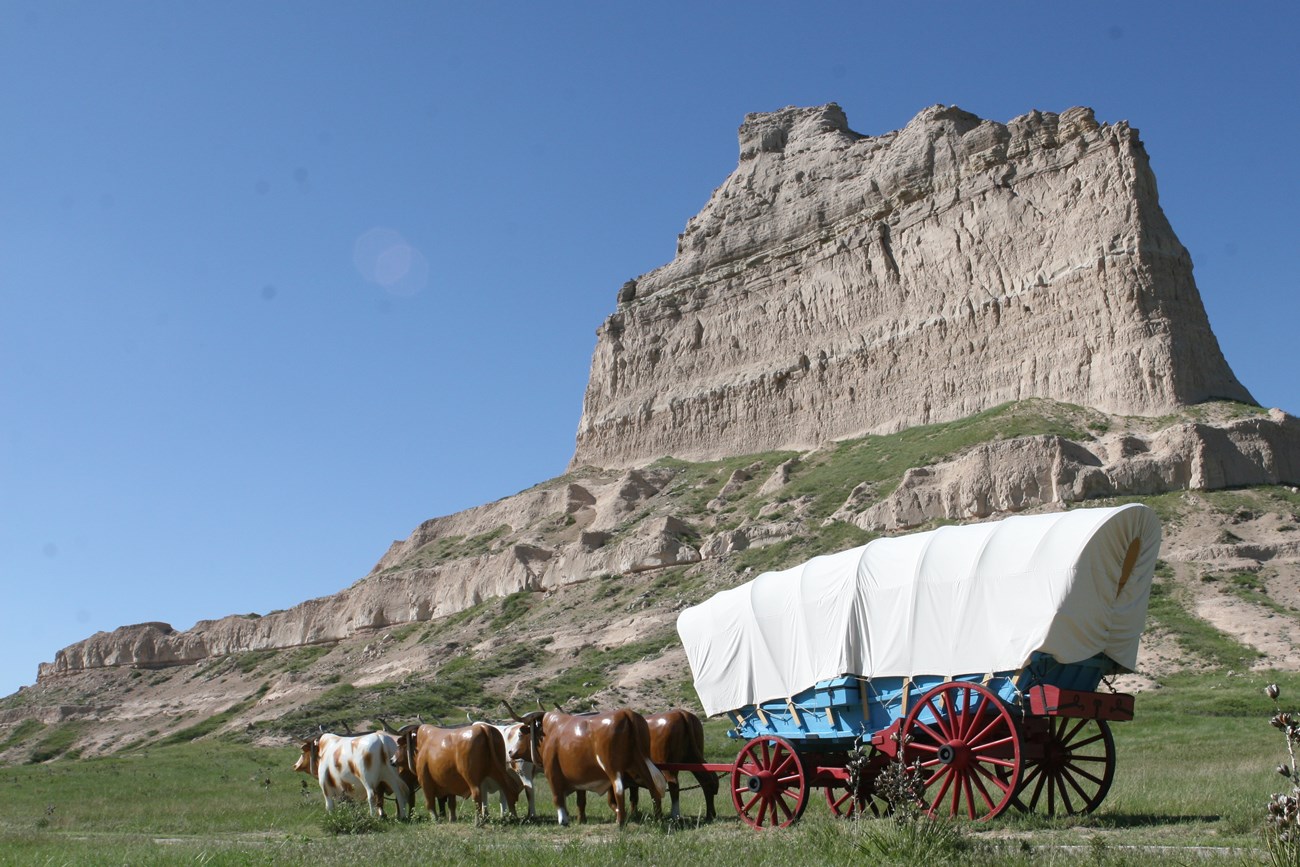
Minivan of the Emigrant Trails
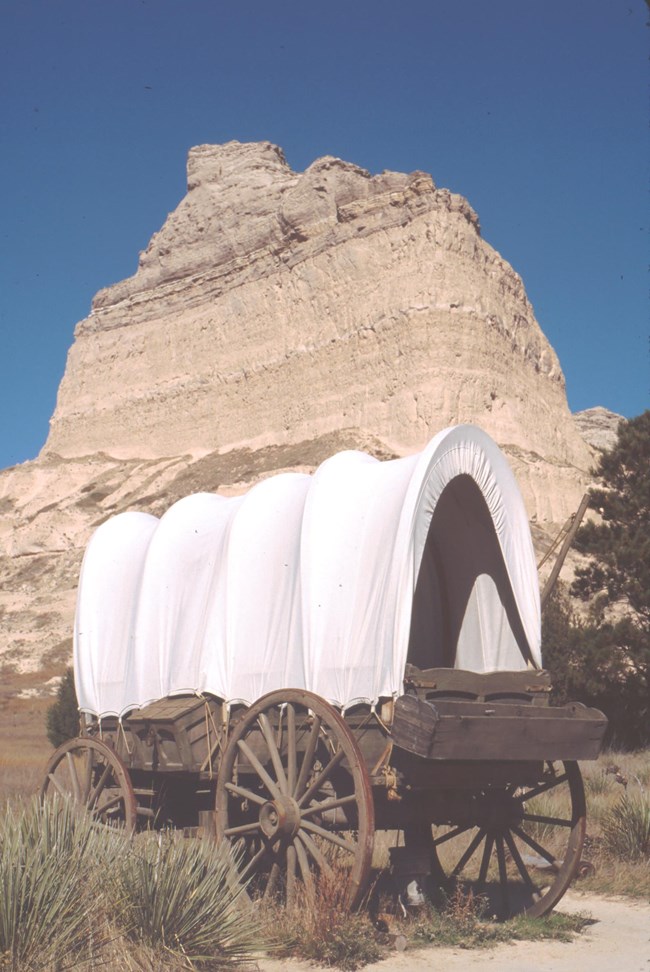
Murphy Wagon
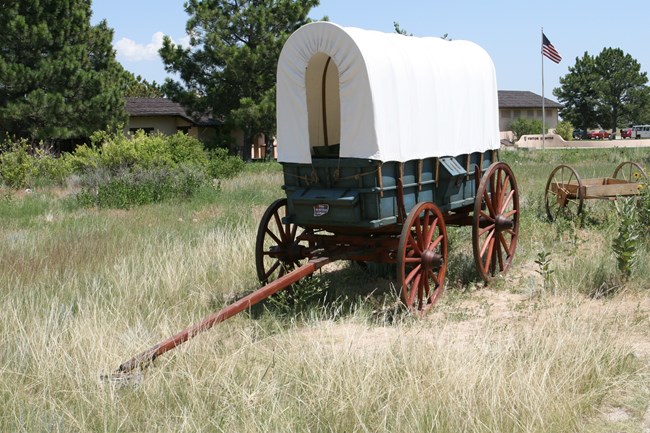
Studebaker Wagon
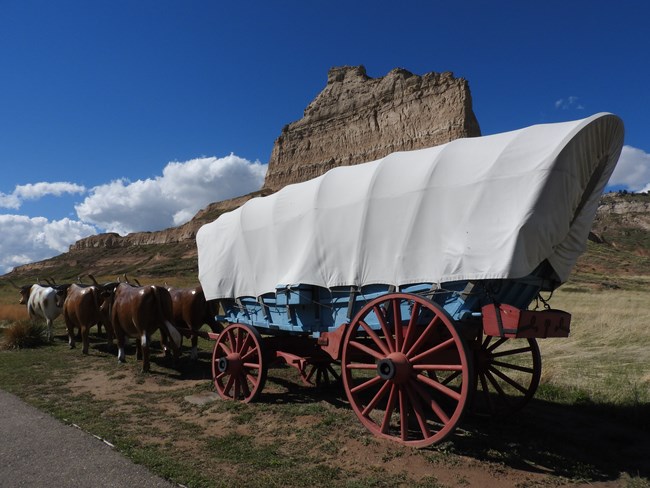
Conestoga Wagon
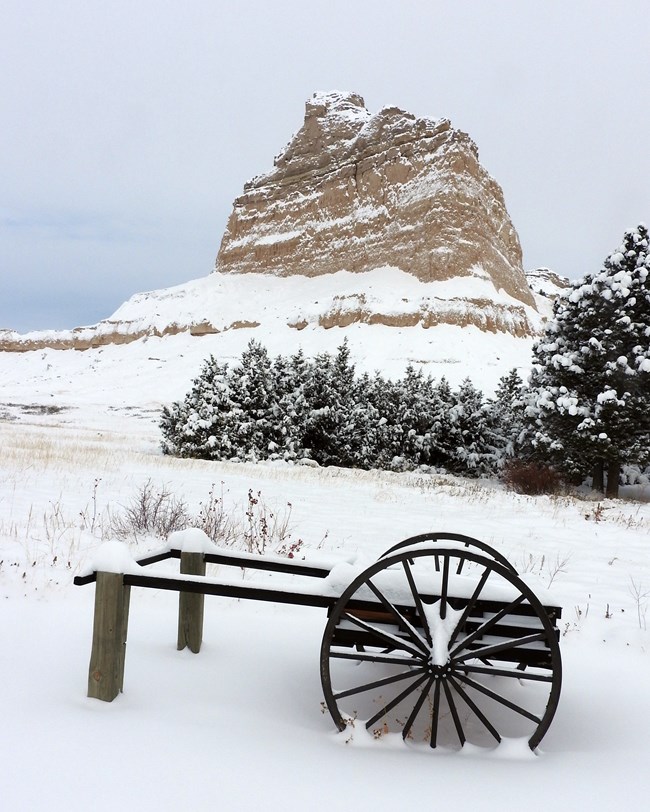
NPS/Eric Grunwald
Mormon Handcart
Part of a series of articles titled The Emigrant Experience .
Previous: Traveling the Emigrant Trails
Next: Death and Danger on the Emigrant Trails
You Might Also Like
- california national historic trail
- mormon pioneer national historic trail
- oregon national historic trail
- scotts bluff national monument
- emigrant trails
- covered wagons
California National Historic Trail , Mormon Pioneer National Historic Trail , Oregon National Historic Trail , Scotts Bluff National Monument
Last updated: November 9, 2021
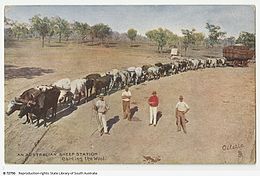
An ox-wagon or bullock wagon is a four-wheeled vehicle pulled by oxen (draught cattle). It was a traditional form of transport , especially in Southern Africa but also in New Zealand and Australia . Ox-wagons were also used in the United States . The first recorded use of an ox-wagon was around 1670, [ citation needed ] but they continue to be used in some areas up to modern times.
South Africa
Afrikaner symbolism.
Ox-wagons are typically drawn by teams of oxen, harnessed in pairs. This gave them a very wide turning circle , the legacy of which are the broad, pleasant boulevards of cities such as Bulawayo , Zimbabwe , which are 120 feet (37 m) wide, [1] and Grahamstown , South Africa , which are "wide enough to turn an ox-wagon".
The wagon itself is made of various kinds of wood, with the rims of the wheels being covered with tyres of iron , and since the middle of the 19th century the axles have also been made of iron. The back wheels are usually substantially larger than the front ones and rigidly connected to the tray of the vehicle. The front wheels are usually greater in diameter than the clearance under the tray of the vehicle so that the steering axle could not turn far under the tray. This makes little difference to the turning circle of the wagon because of the oxen drawing it (see above) and it makes the front of the wagon much more stable because the track is never much less than the width of the tray. It also allowed a much more robust connection between the hauling traces of the oxen and the rear axle of the wagon (usually iron chain or rods) that is necessary for heavy haulage.
Most of the load-carrying area was covered in canvas supported by wooden arches; the driver sat in the open on a wooden chest (Afrikaans: wakis ).
- Examples of ox-wagons
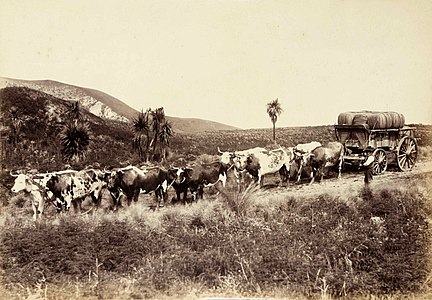
Bullock wagons were important in the colonial history of Australia. [2] Olaf Ruhen, in his book Bullock Teams remarks on how bullock teams "shaped and built the colony. They carved the roads and built the rail; their tractive power made populating the interior possible; their contributions to the harvesting of timber opened the bush; they offered a start in life to the enterprising youngster". Bullocks were preferred by many explorers and teamsters because they were cheaper, quieter, tougher and more easily maintained than horses therefore making them more popular for draught work. [3] Frequently comprising long trains of bullocks, yoked in pairs, they were used for hauling drays, wagon or jinker loads of goods and lumber prior to the construction of railways and the formation of roads. In early days the flexible two-wheeled dray, with a centre pole and narrow 3-inch (8 cm) iron tyres was commonly used. The four-wheeled dray or box wagon came into use after about 1860 for loads of 6 to 8 long tons (6.7 to 9.0 short tons; 6.1 to 8.1 t) and was drawn by 16 to 18 bullocks. A bullock team was led by a pair of well trained leaders who responded to verbal commands as they did not have reins or a bridle. [4] The bullock team driver was called a bullocky , bullock puncher or teamster .
Many Australian country towns owe their origin to the bullock teams, having grown from a store or shanty where teams rested or crossed a stream. These shanties were spaced at about 12-mile (19 km) intervals, which was the usual distance for a team to travel in a day. [5]
The Voortrekkers used ox-wagons ( Afrikaans : Ossewa ) during the Great Trek north and north-east from the Cape Colony in the 1830s and 1840s. An ox-wagon traditionally made with the sides rising toward the rear of the wagon to resemble the lower jaw-bone of an animal is also known as a kakebeenwa (jaw-bone wagon). South Africa has 800 varieties of wood of which 17 varieties were used for wagon building. South African wood varieties are regarded as the best for wagon building. Wood varieties used for wagon making ranged from hard yellowwood to Boekenhout, is a softer wood and was used as a shock absorber but still stayed firmly in place. The iron rim around the wheel was burnt onto the wheel, the charcoal would protect the iron rim from rust and rot, making it easy to cross rivers. The ox-wagon could be pulled by 12-16 oxen. [6]
The ox-wagon could also be disassembled in five minutes by hitting out four pegs on the wheels, then lifting the top of the wagon in seven pieces and carried by four people over rough terrain or across rivers. The ox-wagon could also twist 40 degrees which made it ideal for traversing difficult surface areas. The wheels of the ox-wagon were painted in red lead paint which acted as an excellent water repellant. Various flower and ornament designs were also painted on the wagons and the chests the wagons carried, making them look very colourful. [7]
Often the wagons were employed as a mobile fortification called a laager , such as was the case at the Battle of Blood River .
After the discovery of gold in the Barberton area in 1881, ox-wagons were used to bring in supplies from former Lourenço Marques . James Percy FitzPatrick worked on those ox-wagons and described them in his famous 1907 book Jock of the Bushveld .
In South Africa , the ox-wagon was adopted as an Afrikaner cultural icon. The ossewa is mentioned in the first verse of " Die Stem ", the Afrikaans poem which became South Africa's national anthem from 1957 to 1994. When a pro- German Afrikaner nationalist organisation formed in 1939, to oppose South Africa's entry into World War II on the British side, it called itself the Ossewabrandwag (Ox-wagon Sentinel). [8]
- South African cultural heritage

- Bullock cart (ox-cart)
- Conestoga wagon
Related Research Articles

A wheel is a rotating component that is intended to turn on an axle bearing. The wheel is one of the key components of the wheel and axle which is one of the six simple machines. Wheels, in conjunction with axles, allow heavy objects to be moved easily facilitating movement or transportation while supporting a load, or performing labor in machines. Wheels are also used for other purposes, such as a ship's wheel, steering wheel, potter's wheel, and flywheel.

A cart or dray is a vehicle designed for transport, using two wheels and normally pulled by draught animals such as horses, donkeys, mules and oxen, or even smaller animals such as goats or large dogs.

The Great Trek (Afrikaans: Die Groot Trek was a northward migration of Dutch-speaking settlers who travelled by wagon trains from the Cape Colony into the interior of modern South Africa from 1836 onwards, seeking to live beyond the Cape's British colonial administration. The Great Trek resulted from the culmination of tensions between rural descendants of the Cape's original European settlers, known collectively as Boers , and the British Empire. It was also reflective of an increasingly common trend among individual Boer communities to pursue an isolationist and semi-nomadic lifestyle away from the developing administrative complexities in Cape Town. Boers who took part in the Great Trek identified themselves as voortrekkers , meaning "pioneers", "pathfinders" in Dutch and Afrikaans.

A carriage is a private four-wheeled vehicle for people and is most commonly horse-drawn. Second-hand private carriages were common public transport, the equivalent of modern cars used as taxis. Carriage suspensions are by leather strapping or, on those made in recent centuries, steel springs. Two-wheeled carriages are informal and usually owner-driven.

The Ossewabrandwag (OB) was an Afrikaner nationalist organization with strong ties to national socialism, founded in South Africa in Bloemfontein on 4 February 1939. The organization was strongly opposed to South African participation in World War II, and vocally supportive of Nazi Germany. OB carried out a campaign of sabotage against state infrastructure, resulting in a government crackdown. The unpopularity of that crackdown has been proposed as a contributing factor to the victory of the National Party in the 1948 South African general election and the rise of Apartheid.

A wagon or waggon is a heavy four-wheeled vehicle pulled by draught animals or on occasion by humans, used for transporting goods, commodities, agricultural materials, supplies and sometimes people.
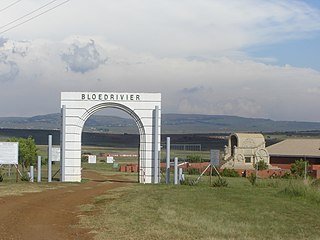
The Battle of Blood River was fought on the bank of the Ncome River, in what is today KwaZulu-Natal, South Africa between 464 Voortrekkers ("Pioneers"), led by Andries Pretorius, and an estimated 25,000 to 30,000 Zulu. Estimations of casualties amounted to over 3,000 of King Dingane's soldiers dead, including two Zulu princes competing with Prince Mpande for the Zulu throne. Three Voortrekker commando members were lightly wounded, including Pretorius.
The year 1838 was the most difficult period for the Voortrekkers from when they left the Cape Colony, till the end of the Great Trek. They faced many difficulties and much bloodshed before they found freedom and a safe homeland in their Republic of Natalia. This was only achieved after defeating the Zulu Kingdom, at the Battle of Blood River, which took place on Sunday 16 December 1838. This battle would not have taken place if the Zulu King had honoured the agreement that he had made with the Voortrekkers to live together peacefully. The Zulu king knew that they outnumbered the Voortrekkers and decided to overthrow them and that led to the Battle of Blood river.
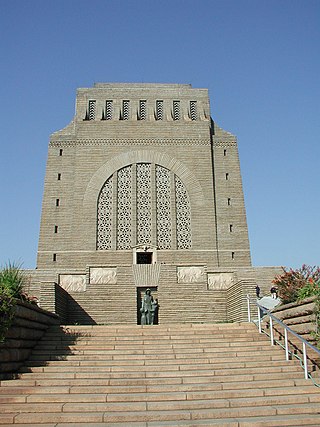
The Voortrekker Monument is located just south of Pretoria in South Africa. The granite structure is located on a hilltop, and was raised to commemorate the Voortrekkers who left the Cape Colony between 1835 and 1854. It was designed by the architect Gerard Moerdijk.

A teamster in American English is a truck driver; a person who drives teams of draft animals; or a member of the International Brotherhood of Teamsters, a labor union. In some places, a teamster was called a carter, the name referring to the bullock cart.

The Conestoga wagon is a specific design of heavy covered wagon that was used extensively during the late eighteenth century and the nineteenth century in the eastern United States and Canada. It was large enough to transport loads up to six short tons, and was drawn by horses, mules, or oxen. It was designed to help keep its contents from moving about when in motion and to aid it in crossing rivers and streams, though it sometimes leaked unless caulked.
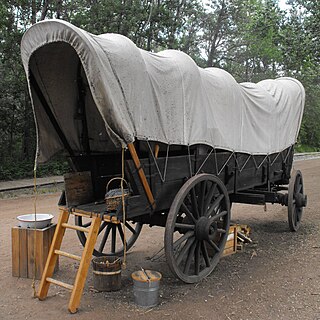
A covered wagon , also called a prairie wagon , whitetop , or prairie schooner , is a horse-drawn or ox-drawn wagon with a canvas top used for transportation or hauling. The covered wagon has become a cultural icon of the American West.

An ox OKS , also known as a bullock , is a bovine, trained and used as a draft animal. Oxen are commonly castrated adult male cattle; castration inhibits testosterone and aggression, which makes the males docile and safer to work with. Cows or bulls may also be used in some areas.

A bullock cart or ox cart is a two-wheeled or four-wheeled vehicle pulled by oxen. It is a means of transportation used since ancient times in many parts of the world. They are still used today where modern vehicles are too expensive or the infrastructure favor them.

A horse-drawn vehicle is a piece of equipment pulled by one or more horses. These vehicles typically have two or four wheels and were used to carry passengers or a load. They were once common worldwide, but they have mostly been replaced by automobiles and other forms of self-propelled transport but are still in use today.
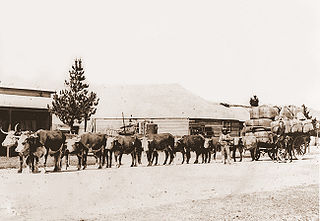
A bullocky is an Australian English term for the driver of a bullock team. The American term is bullwhacker . Bullock drivers were also known as teamsters or carriers.

A wagon fort , wagon fortress , wagenburg or corral , often referred to as circling the wagons, is a temporary fortification made of wagons arranged into a rectangle, circle, or other shape and possibly joined with each other to produce an improvised military camp. It is also known as a laager , especially in historical African contexts, and a tabor among the Cossacks.

The Afrikaans Language and Culture Association , ATKV , is a society that aims to promote the Afrikaans language and culture. The association was founded in 1930 in Cape Town. Since its inception and up to the end of Apartheid in 1994, membership was only open to members of the Afrikaner Christian community. Membership was thereafter opened to include people of all ethnicities, sharing the same values as the ATKV.

Hoërskool Voortrekker is a public Afrikaans medium co-educational high school situated in the municipality of Boksburg in the city of Ekurhuleni in the Gauteng province of South Africa. The academic school was established in 1920.
The Battle of Vegkop , alternatively spelt as Vechtkop , took place on 16 October 1836 near the present day town of Heilbron, Free State, South Africa. After an impi of about 600 Matebele murdered 15 to 17 Afrikaner voortrekkers on the Vaal River, abducting three children, King Mzilikazi ordered another attack. The voortrekkers, under the command of Andries Potgieter, repulsed them, but at the cost of abandoning their livestock.
Henning Johannes Klopper (1895–1985) was a South African politician who served as Speaker of the National Assembly, and the first chairman of the Afrikaner Broederbond. He is known for promoting Afrikaans and fighting White Afrikaner poverty in South Africa.
- ↑ The Australian Encyclopaedia . The Grolier Society. Halstead Press, Sydney. {{ cite book }} : CS1 maint: others ( link )
- ↑ "Annual Berry Show" . www.berryalliance.org.au . Archived from the original (PDF) on 9 December 2012 . Retrieved 3 February 2022 .
- ↑ Beattie, William A. (1990). Beef Cattle Breeding & Management . Popular Books, Frenchs Forest. ISBN 0-7301-0040-5 .
- ↑ "Chisholm, Alec H.". The Australian Encyclopaedia . Vol. 2. Sydney: Halstead Press. 1963. p. 181. Bullock-driving.
- ↑ Davie, Lucille. "Step into a wagon and go back 200 years" . The Heritage Portal . Retrieved 9 October 2018 .
- ↑ Davie, Lucille. "Step into a wagon and go back 200 years" . The Heritage Portal .
- ↑ Williams, Basil (1946). Botha Smuts And South Africa . London: Hodder And Stoughton. pp. 160–161.

EVOLUTION OF WAGONS

By: Judas Makwela, Junior Curator – DITSONG: National Museum of Cultural History
The history of transport includes the era of the ox wagon. The DITSONG: National Museum of Cultural History (DNMCH) is proudly home to diverse heritage assets. Amongst them that caught my attention and interest is the Museum’s wagon collection and specifically the development of the ox wagon, of which there are various types that were used for different reasons.

Figure 1. An open ox-drawn or transport wagon such as this example was used by different cultures to load, and transport goods such as farming produce and other large loads.

Figure. 2 Ox-drawn traveling wagon covered with a canvas tent for protection.
Wagons were built in different sizes according to the purpose for which they were used. In South Africa, 17 varieties of wood were used for wagon building. South African wood varieties are regarded as the best for wagon building.
Some wagons were used to travel long distances to other towns or farms. Most of the load-carrying area was covered in canvas, supported by wooden arches, and protected the travellers from rain and the hot sun. They could also sleep in their wagons. Larger wagons were built for transporting goods and large raw materials.

Figure 3. Ox-drawn transport wagon.
This article addressed some aspects in the development of the ox wagon. They were initially used by Europeans for transporting goods or when taking long journeys/ trekking . African people managed to acquire these ox wagons and utilize them. Even after automobiles were introduced in South Africa (1896), it still took many decades to completely phase them out and replace them by cars. Even today, in some rural areas, ox wagons are still in use as an alternative means of transport or for leisure purposes.
Rosenthal, Eric. 1975. Victorian South Africa . Tafelberg: Cape Town.
DITSONG: National Museum of Cultural History, “Transport Collection. Accession Number: L 2311 (Figure 2).
Wagons in history: the bokwa : Figures 01 and 03.
Photographs by Judas Makwela (Junior Curator), DNMCH.
Related Posts

THE CARVED KRAG JÖRGENSON RIFLE OF CHRISTIAAN BEYERS, ASSISTANT COMMANDANT-GENERAL DURING THE ANGLO-BOER WAR OF 1899-1902

THE TIMELINE OF MONEY DESIGN CHANGES IN SOUTH AFRICA BETWEEN 1652 AND 2023

THE CARVED MAUSER OF LOUIS BOTHA, ONE OF THE YOUNGEST BOER GENERALS IN THE ANGLO-BOER WAR OF 1899-1902

THE MIGHT OF FIJIAN WAR CLUBS

Mules, Horses or Oxen
Historical trails, trail basics - mules, horses or oxen.
Early Wagon Train
Which would be best to pull your heavy wagons? Mules are strong, can go faster, but are often tricky to handle. Mules also had tendencies to bolt and become unruly. Oxen are slower, but more reliable and tougher than mules. They will eat poor grass. Oxen were very strong and could haul fully-loaded wagons up ravines or drag them out of mudholes. A large wagon needed at least three pairs of oxen to pull it.
Scholars put the percentage of pioneer wagons pulled by oxen at one-half to three-quarters. The cost of a yoke of oxen during the last half of the 1840s varied from a low of $25 to a high of $65.
The three main parts of a prairie wagon were the bed, the undercarriage, and the cover. BED = was a rectangular wooden box, usually 4 feet wide by 10 feet long. At its front end was a jockey box to hold tools. UNDERCARRIAGE = was composed of the wheels, axle assemblies, the reach (which connected the two axle assemblies), the hounds (which fastened the rear axle to the reach and the front axle to the wagon tongue) and the bolsters (which supported the wagon bed). Dangling from the rear axle was a bucket containing a mixture of tar and tallow to lubricate the wheels. COVER = was made of canvas or cotton and was supported by a frame of hickory bows and tied to the sides of the bed. It was closed by a drawstring. The cover served the purpose of shielding the wagon from rain and dust, but when the summer heat became stifling the cover could be rolled back and bunched to let fresh air in.
Wagons being pulled by horses and mules
Double Wooden Ox Bow
Notes From The Frontier
- Oct 21, 2019
What Pioneers Packed to Go West
Updated: May 11, 2023
Pioneers packed like their lives depended on it, because they did!

Westering pioneers had many routes to choose from but the main ones were the Oregon, California, Sante Fe, and Mormon Trails. Whatever route they chose, many read guidebooks like Landsford Hastings’ 1845 “The Emigrant’s Guide to Oregon and California” or Captain Randolph Marcy’s 1859 “The Prairie Traveler: A Hand-Book for Overland Expeditions.” They offered advice on what and how to pack, what draft animals to buy, distances, water, grass, terrain, weather, firearms and ammunition, tools, wagon parts, how to make repairs, and what hardships they might meet along the way.

Two primary types of wagons were used on wagon trails going west. The Conestoga wagon was named for Conestoga Township in Pennsylvania where many German pioneers in the 1750s first started West on the Appalachian Trail to settle land east of the Mississippi. It was a huge and very heavy wagon, 28 feet long with wheels five feet tall and, loaded, could weigh as much as six tons and took three pair of oxen to pull. (Like pulling a semi!)
Later, the much smaller Prairie Schooner became most common on the Oregon, California and Sante Fe Trails to the Western frontier. It was usually built in the Midwest for the departure points in Missouri, where all three trails started. The prairie schooner was half the size of the Conestoga, 12-13 feet long, and weighed 1,300 pounds empty and as much as two tons loaded. It required less animals to pull and to feed on the trail and could move faster (20 miles a day vs. 13-15 for the Conestoga wagon).

The sides of the wagons were waterproofed with tar, so they could ford rivers and keep the cargo dry. A thoroughly water-proofed wagon would also float in high water, making the crossing much easier. The canvas tops were oiled to keep out the rain. Wooden wheels had iron rims to prevent wear.
The Oregon Trail took roughly four to six months to complete. Packing could mean the difference between life and death on the trail and varied wildly depending upon the sensibilities (and sometimes the sense!) of the travelers. James Miller’s 1848 diary entry describes what they packed for food: “We had… 200 lbs. flour for each person, 100 lbs. bacon, corn meal, dried apples and peaches, beans, salt, pepper, rice, tea, coffee, sugar, and many smaller articles for such a trip.” Pioneers also commonly packed 80 lbs. lard, 20 lbs. sugar, 10 lbs. each of coffee and salt per person, yeast, hardtack and crackers.

A wagon was filled with essentials, so travelers usually walked alongside the wagons. This also saved the energy of the oxen, mules or horses pulling the wagons. Teams grazed at night for grass.
Some travelers brought cattle to butcher along the way. Many brought a milk cow and a chicken or two for eggs. Each morning, after milking the cow, the buckets of milk were covered and hung under the wagon. The jarring of the unsprung axle would churn the milk! At night, the fresh butter would be skimmed off. A Dutch oven was the standard cooking container because it was versatile and could be used to bake bread, cook soups, grill meat, and make oatmeal in the morning.
Most wagons had a “chuck box” at the back of the wagon that consisted of a fold-down table surface in front of a cabinet that contained food stuffs, utensils, plates and basics needed to prepare a meal. Shelving below the axle contained larger Dutch ovens, bowls for making bread dough, tubs for washing, or even bottles of a more sundry nature.

Large wooden water kegs were carried on the sides of the wagons. Water would be resupplied from rivers along the way. However, there were some dry stretches and water was carefully preserved. Cholera epidemics were most common along the Platte River and were caused by contaminated water from the massive numbers of travelers that bivouacked there.
Medical and surgical supplies were essential: bandages, ointment, laudanum, cough syrups that contained cocaine, painkillers that contained opium, and of course alcohol for drinking. (Alcohol as an antiseptic was not commonly used until the 1890s.) Surgical instruments for suturing wounds, pulling teeth, lancing boils, extracting bullets or arrowheads, and a bone saw for amputating were commonly packed as well.
Tools for repairing or rebuilding wheels, axles, wagons, ox bows, and harnesses were heavy but crucial to have. The basics were hammers, saws, augers and gimlets. Prudent planners would also pack heavy rope, chains, spare parts, axle grease, and even pulleys. Oil and candle lanterns were essential since work and repairs often had to be done at night, so all would be ready when the wagon train left in the morning.
Warm clothing for rain and cold was packed, as was bedding. Although bedding took up space, it was crucial to get as much sleep as possible. Travelers walked about 20 miles a day over often rough terrain, or in prairie grass as tall as they were, and were exhausted at the end of each day.

Those who insisted on packing iron stoves, heavy furniture, pianos, sewing machines, iron plows, kegs of whiskey, blacksmith anvils, or other weighty items usually discarded them on the side of the trail as the grazing and water ran out. Fort Laramie in Wyoming became known as “Camp Sacrifice” because it was so littered with jettisoned cargo, antique furniture and family heirlooms, chests of silver and china, stoves, and pianos, broken wagons, and dead animals.
Most wagon trains had at least 25 wagons. Perhaps the largest wagon train to travel on the Oregon Trail left Missouri in 1843 with over 100 wagons, 1,000 men, women and children, and 5,000 head of oxen and cattle. The train was led by a Methodist missionary named Dr. Elijah White. But wagon trains became so common on the trail that processions seemed to have no beginning or end. Diaries told of hundreds of wagons passing by Fort Laramie in a single day in the 1850s. Foraging for the teams became a serious challenge because grazing near the trail had been exhausted.
Two posts from the pioneer diary of Elizabeth J. Goltra provide a glimpse of traveling on the trail:

September 20, 1853: Two of our horses are missing this morning. Bought 30 pounds of beef and some other eatables… found plenty of wood and water and grass one mile south. We are now at the foot of the Cascades, in heavy timber. Bought 80 pounds of flour off an emigrant at 10¢ per pound. We now have plenty of provisions to last us through. We guard our cattle very closely or we would lose them in the timber. Rest the remainder of the day to let the cattle eat plenty for feed is scarce in the mountains.
September 24, 1853: This is a very rainy morning. The roads are very bad. Fearful of being caught in a snowstorm… This is the roughest and steepest hill on the road. Got down all safe by cutting and chaining a tree behind the wagon 100 feet long. Camped at the foot of the hill and tied our stock up with nothing to eat but a little grass we carried along with us.

PHOTOS: (1) Conestoga wagons were used early in pioneer history to travel on the Appalachian Trail and east of the Mississippi. But they were extremely heavy—up to six tons loaded--and required up to six animals, usually oxen, to pull. (2) The smaller Prairie Schooner started to replace the larger Connestoga wagons and were often built in the Midwest near the starting point of the Oregon Trail. (3) Two families rest at the end of the day on the trail at the foothills of the Rockies in northern Utah,1870. Photograph by Henry Martinean. Denver Public Library. (4) A very rare photograph of the inside of a covered wagon packed for the Oregon Trail shows the crowded quarters. (5) Custer’s Black Hills Expedition of 1874 included 110 covered wagons, 1,200 men, artillery and food supply for two months. This expedition was about the same size as the largest wagon train ever to travel the Oregon Trail.
You may also enjoy these related posts:
-What Pioneers Ate
https://www.notesfromthefrontier.com/post/what-pioneers-ate
-Pioneer Survival Guides
https://www.notesfromthefrontier.com/post/pioneer-survival-guides-in-the-1800s
"What Pioneers Packed" was originally posted on Facebook and NotesfromtheFrontier.com on June 24, 2019
513,667 views / 23,754 likes / 14,767 shares / 676 comments
© 2021 NOTES FROM THE FRONTIER
- Homesteading Life
- Most Popular
Thank you for this wonderful and detailed post. the photos and drawings are awesome and so helpful in research.
Thank you, Gini❣️
I really enjoyed this article! I’m always fascinated with American pioneer history!!
Great article and photos. Much appreciated. Really brought out what hardships they faced and what was needed to survive them. Interesting re: food supplies.
Thanks for your question, Jim. I can’t answer your question off the top of my head, but I do know that reliable wagon masters were a rare breed and a very valuable commodity! Many had worked the fur trade or been Indian scouts. This would make an excellent post in the future! Look for it. Thanks again.
Any recollection of a Peter Purrier as a wagon master? Approximately how many “reliable” wagon masters were there. Thanks Jim Wheeler
Deborah Hufford
Author, Notes from the Frontier
Deborah Hufford is an award-winning author and magazine editor with a passion for history. Her popular NotesfromtheFrontier.com blog with 100,000+ readers has led to an upcoming novel ! Growing up as an Iowa farmgirl, rodeo queen and voracious reader, her love of land, lore and literature fired her writing muse. With a Bachelor's in English and Master's in Journalism from the University of Iowa , she taught students of Iowa's Writer's Workshop , then at Northwestern University , Marquette and Mount Mary . Her extensive publishing career began at Better Homes & Gardens , includes credits in New York Times Magazine , New York Times , Connoisseur , many other titles, and serving as publisher of The Writer's Handbook .
Deeply devoted to social justice, especially for veterans, women, and Native Americans, she has served on boards and donated her fundraising skills to Chief Joseph Foundation , Missing & Murdered Indigenous Women ( MMIW ), Homeless Veterans Initiative , Humane Society , and other nonprofits.
Deborah's soon-to-be released historical novel, BLOOD TO RUBIES weaves indigenous and pioneer history, strong women and clashing worlds into a sweeping saga praised by NYT bestselling authors as "crushing," "rhapsodic," "gritty," and "sensuous." Purchase BLOOD TO RUBIES online beginning June 9. Connect with Deborah on DeborahHufford.com , Facebook , and Instagram .

- Travel Website
- Travel trade website
- Business events website
- Corporate & media website
- Welcome to South Africa
- What you need to know
- Things to do
- Places to go
- Get in touch
Choose your country and language:
- South Africa
Asia Pacific
- South Korea
- Netherlands
- United Kingdom
By creating an account, I agree to the Terms of service and Privacy policy
Vibrant culture
Become an oxwagon pioneer – clarens oxwagon camp.
O O xwagons – South Africa’s Voortrekker pioneers rode in them, blazed trails in them, sometimes gave birth in them and died in them. Relive those days when you sleep out at the Clarens Oxwagon Camp. Dine out beside a crackling camp fire before bedding down in a comfortable old-time oxwagon .
The Clarens Oxwagon Camp is a living reminder of those feisty, Dutch-speaking Voortrekkers (literally 'one who goes before') who left the British-ruled Cape Colony in the 1830s and 40s to forge independence and a new life for themselves in the vast, largely unexplored interior of South Africa.
Oxwagons carried these pioneer families, their worldly possessions and their dreams of a place where they could live in freedom , unfettered by British rule.
Tucked away in a tall poplar grove surrounded by golden sandstone mountains on St Fort farm just outside Clarens , off one of the most beautiful scenic roads in the e astern Free State, is Clarens Oxwagon Camp.
St Fort farm is known for its views of the aptly named Mushroom Rock , the nearby San rock paintings and the excellent fly-fishing.
Inside the sturdy wooden walls encircling the open-air camp you'll find the wagons. There are 14 of them, each authentic and restored, furnished with 4 single bunk beds , sleeping up to 8 people .
The camp is self-catering , so bring all your own food and drink. There's a kitchen with a kettle, a two-plate stove, a washing up area and an undercover braai area. Most importantly, however, there's a campfire where you can sit late into the night and swap tales with the other guests.
At the end of the evening as the stars blaze over the mountains, climb into your white canvas oxwagon with its cheerful red wheels, curl up in a comfortable bunk and dream of those long - ago days.
The area around Clarens is one of the loveliest in the whole country – expect soaring red mountains, clear mountain streams, winding roads lined with poplars and panoramic views.

T T ravel tips & planning info
Who to contact
Clarens Oxwagon Camp
Tel: +27 (0) 58 256 1 260
How to get here
Take the N3 west from Johannesburg. Then the R26 to Bethlehem and follow the signs for Clarens . The Oxwagon Camp is 7 km from Clarens on the Fouriesburg Road.
Best time to visit
It can get very hot in summer and bitterly cold in winter, so spring and autumn are best.
Things to do
The Golden Gate Highlands National Park is a short drive away , as is the arty town of Clarens .
What will it cost?
Please enquire directly about rates .
Length of stay
One night is sufficient for the oxwagon experience. But if you are using the camp as a base for exploring the area, then 2 or 3 nights.
What to pack
The Clarens Oxwagon Camp is self-catering , so bring all your food and drink ( Clarens has a number of excellent supermarkets, butcheries, delis and liquor stores) , as well as cooking utensils.
What's happening
Among the most popular events in the area are the Clarens Craft Beer Festival in February and the Cherry Festival in November.
Best buys
Clarens is a shopping mecca. Find African crafts and curios, art galleries, handcrafted leather, pottery, handmade quilts, jewellery , jams and preserves, freshly baked bread and pastries… and lots more.
Related links
- Clarens Destination s
- Clarens Oxwagon Camp
- Clarens Craft Beer Fes t ival
- Eastern Free State Oxw a gon
South Africa on social media
The BMW International Open has made us excited for the BMW Golf Cup World Final to be hosted in SA. We caught up wi… https://t.co/XiU3waBo1T
Always a pleasure partnering with local businesses to promote SA on the global stage. Warren Weitsz, Co-Founder of… https://t.co/YRxoX6Jdtx
To say the players are bringing their A-game is an under statement! Round 2 has given us many unforgettable moments… https://t.co/4bBdAuXMUL
"...Patrons have been keen and interested in engaging on where the best fairways in SA are. Paired with some of our… https://t.co/tIoXM2uUrh
Our stand at the BMW International Open has been drawing a lot of attention – and rightfully so! “We are proud and… https://t.co/ulYSTje4CB
Clear skies, rolling greens, supportive crowds – the conditions couldn’t be better for a day at Golfclub München Ei… https://t.co/3TMmUxsN0m
What happens when an amateur and pro hit the fairway together? Find out in the Pro-Am Tournament, where 3 amateurs… https://t.co/hkvHUw0H0E
Ready to get into the swing of things? The Pro-Am Tournament of the 2023 BMW International Open starts today in Mün… https://t.co/WqLU7FshdH
South Africa has many exquisite golf courses. As we gear up for The BMW International Open in Germany, we hope to s… https://t.co/vTFwgOa78W
South African Tourism will be showcasing our beautiful country's offerings in Germany! We have so much to offer glo… https://t.co/O1m4yVy491
#DidYouKnow South Africa has produced some of the top golfers in the world. As we gear up for the BMW International… https://t.co/E1GsW6z1Fy
#DidYouKnow ? #VisitSouthAfrica ❤️🇿🇦 https://t.co/Y4zWjb8xIz
RT @Roberto_EUBXL: Amazing #YouthDay2023 long weekend in @MidlandsMeander ! Another 💎 of multifaceted #SouthAfrica : touches of 🇬🇧 🇧🇪 🇱🇺 co…
What does golf, South Africa, BMW and Germany have in common? The 34th staging of the BMW International Open in Ger… https://t.co/YdvuWOjs8O
Golf was first played in South Africa in 1885, in Cape Town. Now we are taking our love of golf to the world, as we… https://t.co/dXc5uIyGxI
RT @PublicSectorMan: Today marks 47 years since the youth uprising of 16 June 1976. Deputy President Paul Mashatile will lead the commemor…
We look forward to showcasing South Africa’s abundant tourism offerings to a global audience while reminding them a… https://t.co/yVz97hDGaa
A dynamic collaboration between SA Tourism and the iconic BMW Group is set to supercharge the country’s efforts tow… https://t.co/JhLDwHlLix
50 days until the kick-off – or shall we say the tip-off – of the Vitality #NWC2023 in SA! Excitement levels are at… https://t.co/Ni2fHwh2NJ
#VisitSouthAfrica ❤️🇿🇦 https://t.co/ApcA6wNNop

- Useful links
- Travel partners
- Business events
- Travel trade
- Accommodation
- Useful contacts
- Visa & entry info
- Digital Assets Library
- Image Library

What You Probably Didn't Know About Covered Wagons
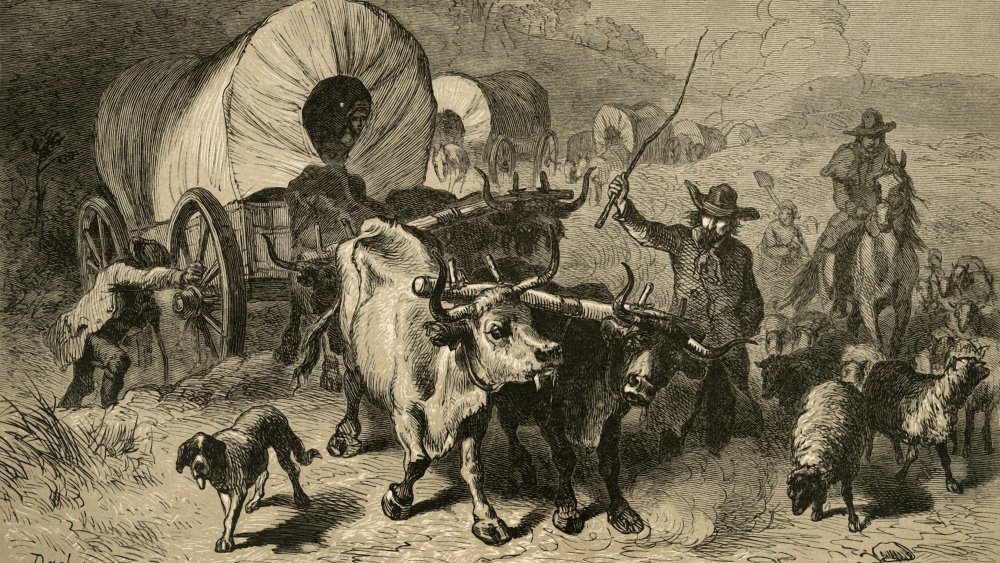
Safety in numbers. Or, if you prefer, misery loves company. Either way, the great Western Migration of the 19th Century was largely accomplished by people crossing the Great Plains, bound from the East, or even what's now the Midwest, en route to the lush lands of Oregon and California, there for the taking, there for the settling — if you survived the trip.
There was no easy way to make a new life for yourself in the 1800s. Not if you wanted to move, and not if you wanted to move a family. Passage by ship around the tip of South America was an expensive and dangerous option. Railroads? The transcontinental railroad wasn't completed until 1869, according to History . Stagecoach? Impractical for families, plus what they might need when you got where you were going — tools, household goods.
Not that the alternative was a whole lot better. While many of the Latter-day Saints made the trip to Utah using handcarts (and walking), relates Historynet , many others would invest in a covered wagon of some kind. There were various sizes available, and of course in this case, size actually mattered — because you had to take into consideration how you were going to move that wagon, loaded up with supplies, tools, and household goods with which to make your new start in a new land.
Most people walked most of the way
They would travel in packs — wagon trains, a collective of like-minded folk, guided by someone who claimed to know where they were going and the best way to get there (though that didn't always work out — ask the Donner Party ). Migration began in earnest with the opening of the Santa Fe Trail in the 1820s, then picked up considerably with wagons headed for Oregon and California in the 1840s, writes Marshall Trimble in True West Magazine . The first wagons generally measured about 10 feet long, four feet wide, and two feet deep, writes Jana Bommersbach, also for True West . Arches over the top of the wagon were covered by heavy canvas. The incredible weight being moved required significant animal power, and so most often, wagons were pulled by teams of oxen, though occasionally mules or horses were utilized instead. Added benefit: an ox wasn't a very attractive target for thieves — they moved slowly, you couldn't ride them, and not particularly tasty. As the trip wore on, and the oxen wore out, it was not unusual for families to start abandoning the things that seemed so important before they left.
The so-called Conestoga wagon was extremely popular until the 1850s — as popular as something as primitive as this could be, anyway — rugged, dependable, and incredibly uncomfortable. One advantage of using oxen was that the family could walk alongside at a relaxed pace.
Wagons were built to endure
On a good day, a wagon train might cover 20 miles — seven days a week, with no holidays, trying to take advantage of good weather before autumn and winter struck, trying to cover some 2,000 miles in about five months. There was a break for lunch, then the evening stop for the night, with beds unrolled underneath the wagon — there wasn't room within for people. Repairs had to be done on the road. The wagons had springs, but if you did try to ride, it was a bone-jarring trip and most people didn't bother. Advancements in wagon design — it's probably a stretch to call it "technology" — resulted in the slightly smaller, perhaps faster, "prairie schooner," replacing the Conestoga in the middle of the century.
Wagon trains, especially the larger groups, were rarely attacked by Native Americans. More problematic was the weather. A swollen river could prove impossible to cross, causing days, even weeks, of waiting. Muddy ground could slow progress. And if the guide was inexperienced, there was always the nightmare of getting lost, losing time, and getting stuck. (Donners, anyone?)
The voyage completed, the wagon often served as temporary shelter
Once arrived in the new territory, the wagon would provide the first shelter for the family, until something a little more permanent could be built, whether of timber or simply prairie sod. The vehicle itself would continue to be used to move what needed moving as the family settled in.
Texas rancher Charles Goodnight is credited (by some) with inventing another form of Old West wagon: the chuckwagon , a rolling kitchen serving the needs of cattle drives. The cook would drive the wagon ahead of the herd during the day, meet up to serve hot food, move ahead again to prepare for the evening, while gathering firewood and perhaps fresh game or even wild bird eggs along the way. It was smaller than the prairie schooner or the Conestoga, and would feature fold-down work spaces, maximized storage for cooking equipment, and no matter who invented it, was generally an ingenious piece of American engineering.

Search form
How the ox-wagon and transport-rider opened up this country.
Hans Sauer says the trek ox is the real pioneer of the southern African sub-continent. They dragged the wagons across the whole of South Africa and crossed the Limpopo and Shashe Rivers and then across the Lundi (Runde) to Victoria and finally Salisbury.
Before the coming of the railways it was the trek ox that provided all the transport leading to the development of the diamond fields at Kimberley and the goldfields of the Witwatersrand and finally the occupation of Mashonaland and conquest of Matabeleland.
The trek ox brought from the coast into the interior all the food, furniture, clothing, household utensils, corrugated sheeting, timber, heavy machinery required for mining, the portable steam engines that provided power and permitted the development of the towns at Victoria (Masvingo) Salisbury (Harare) Gwelo (Gweru) and Bulawayo.
To the transport-riders the road had huge appeal. Stanley Hyatt says to him, the road was what the sea is to other born wanderers. He had already sailed around the world in a wind-jammer, but this was nothing in comparison to the dusty, narrow track which ran from the railhead towards the heart of Africa.
To see examples of wagons, visit the excellent Mutare Museum, which specializes in transport, and has some excellent wagons and carts donated by the Strickland family, or see the article under Manicaland Province on the website www.zimfieldguide.com
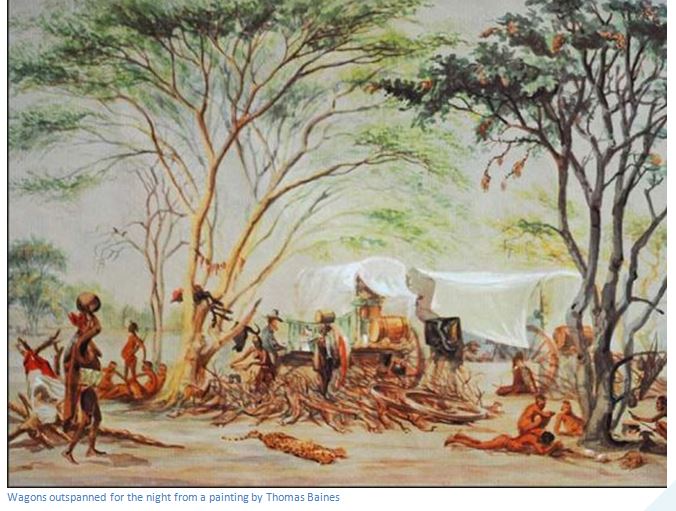
So quickly did land transport develop – the railway reaching Bulawayo in 1897 and Salisbury from Beira in 1899 and from Bulawayo in 1902, that the era of the ox wagon and the transport –rider was a short one and their significant part in the opening up of the country is largely forgotten.
Louis Bolze reminds us in the Foreword to The Old Transport Road by Stanley Portal Hyatt that wagons plying the route between the railhead at Vryburg and Bulawayo took two months to complete the 840 kilometre route; in 1895 the Bulawayo Chamber of Commerce reported over 2,000 ox wagons had arrived in Bulawayo and in the same year a passenger on a Zeederberg coach counted over 100 ox wagons between Palapye and Bulawayo.
Stanley Hyatt, born in 1877, felt great pride and affection for his trek oxen, their individual characters and positions in the span, their care and training, the driver skills and resourcefulness called for to keep an ox-wagon on the road, from repairing a broken wheel in the bush, righting a capsized wagon with an 3,600 kilogram load, to looking after a sick ox.
For Hyatt who came to Matabeleland when he was 19 the fascination of the transport road was immense. He says it did not lead to places, to Palapye, to Bulawayo, to the Victoria Falls. It led through them, past them. It went on; it was always going on, into the very heart of the Dark Continent. One year a District would be a blank on the map, a mere name at best; the next year you would find that the road had reached it, had passed through it, and in the new edition of the map there would be scores of names of mountains, rivers and townships even, on that space.
In 1891 the only route from Fort Tuli to Salisbury was along the route cut by the Pioneer Column between July and September of the previous year. In their hurried march during the previous year Dr Hans Sauer says the worst obstacles they left behind were the many foot-high tree stumps as, unlike stone boulders which the wagon wheels climbed over, they produced a dead shock followed by a violent swerve which could result in the dϋsselboom , or wagon pole snapping. When this happened, everyone looked for a suitable shaped tree to replace the broken dϋsselboom which often had to be cut down by starlight.
On his journey Sauer followed the routine of the Afrikaner transport riders, which was the tried and tested method for oxen when long distances were being traversed. Two treks were made every 24 hours. The first began about 4pm when the voorloper would crack his whip and bring the oxen back to the wagon for in- spanning. The trek began at 5pm and lasted until 9pm when the oxen were unyoked and tied to the trek chain to lie down and chew the cud. Two or three fires were lit around the camp to scare off lions and for the evening meal. Dry firewood was collected and stacked for use during the night. After supper everyone slept, rising about 2am when the second trek began and ended just after sunrise at 5am.
During the day the oxen were let out to graze with a herder, and the wagon conductor or driver, the voorlooper and other assistants would take long naps, just waking to check on the oxen. All passengers followed their example as it was difficult to sleep whilst the waggons were trekking due to the wheels constantly bumping against boulders and stumps.
The only exception to this routine was in the rainy season when the roads washed out, every rut became a river and scooped out the road into trenches up to three feet deep and travelling by night became dangerous; the Selukwe-Victoria road was notorious for wash-outs.
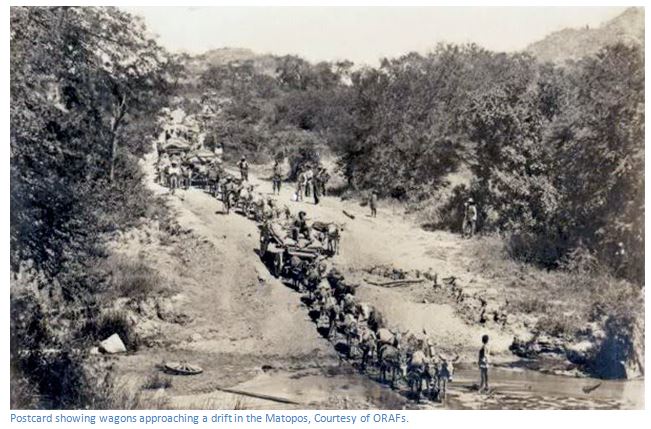
Approaches to drifts across rivers were always taken cautiously especially if the pull-out was steep or narrow, often just a cutting in the river bank. It was always difficult to get the span to begin a heavy pull with a dead-straight chain, they preferred a swing and often at drifts two spans would be used as the wheels would get caught in a wash-out into which they sank.
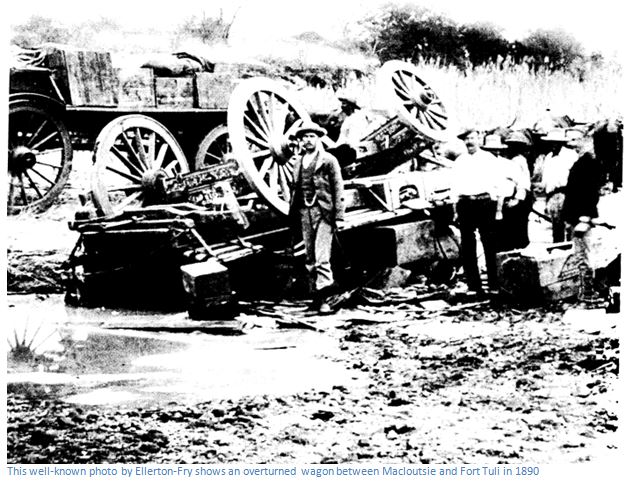
On flat ground the driver had an easy time sitting on the front box with his helper smoking endless pipes of Boer tobacco. Trekking by night in broken country intersected by dongas and small streams could be very difficult. The driver would be on foot beside the oxen, shouting their individual names and cracking the whip in the air when they were not doing their fair share of pulling, touching an ox with his whip on occasion when it refused to obey an instruction and prodding the wheeler in the ribs with the whip butt end to make him swerve and miss a stump or boulder on the road.
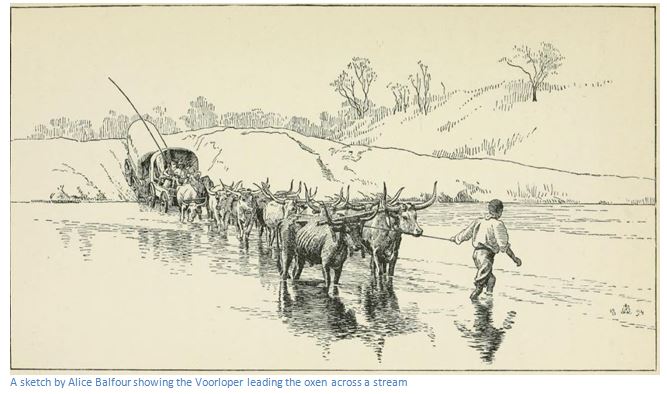
When the voorloper shouted they were approaching a steep stream bank, the driver would rush to the rear of the wagon to screw the brake onto the two rear wheels to prevent the wagon gaining speed and injuring, and even killing the two hind oxen, or wheelers. The constant braking and then loosening the brake when negotiating difficult ground was hard work and a great test of the driver’s ability; demanding strength and stamina and quick thinking. Hans Sauer says he tried it and found seven or eight kilometres of bad road quite exhausting work.
Accidents were common. Lord Randolph Churchill does not mention this happening in his book Men, Mines and Animals in South Africa to one of his ox-wagons when crossing the Lundi River (Runde) on his grand tour of Rhodesia in 1891. The slope leading down to the river was very steep and the driver too slow in applying the brakes so that the wagon rushed down on the team of oxen, killing both wheelers and injuring others. A little later, voorloper was killed by a crocodile, another incident which also goes unmentioned, but is recounted by Hans Sauer, who was crossing the Lundi River at the same time.
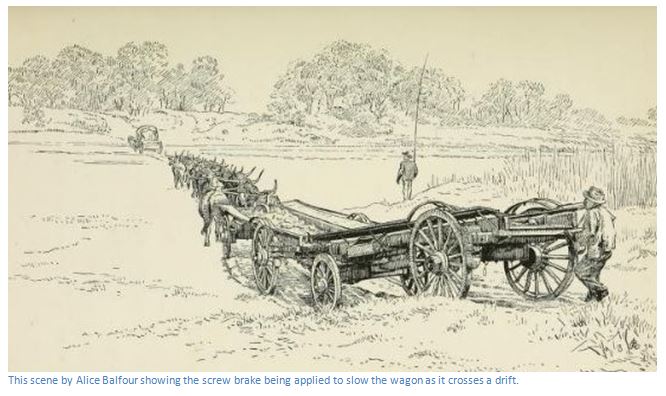
Trekking was a noisy affair; the driver shouting out the names of the oxen if he considered they were not pulling their weight. “Englishman” or “ Rooinek ” was the name usually given to the worst in the span and was an old-standing joke with Boers. Other common names were Bandom, Biffel, Jackalass, Jonkman, Sixpence, Fransman, Witkop, Blom, Appel, Basket, Scotchman, Swartland and Dudmaaker.
Biffel, the left hind bullock of the Stanley Hyatt’s black span was his favourite. Like all true Mashona cattle he was short in the legs and long in the body with a beautiful head, short flat horns and the kindest, wisest eyes. He was fond of strolling up to strangers in the mining camps and would stand still as they scratched his ears, or put an arm around his great neck.
The two hind oxen, achter-os, or wheelers, who steered the wagon, had most work to do in avoiding obstacles in the road and were the most important oxen. They had to push sideways against the dϋsselboom and the pulling strain of the other fourteen oxen in the span. If they were slow in obeying the driver’s orders, they would receive a cut from his whip, causing the ox to swerve violently against the dϋsselboom and his companion to change the direction of the wagon and miss a boulder or stump in the road.
On inclines the wheelers would help brake the wagon by planting their feet in the ground and causing a backward pull on their yoke with the rest of the span being held back whilst the voorloper would also pull back on the “tow” a leather riem attached to the horns of the two leading oxen. In addition, he might shout for them to go slow, even punch the leaders on the nose, or throw handfuls of dirt at the others to make them slow up.
Next in importance to the wheelers were the voor-os or leaders and expected to be a cut above the other oxen. They have to choose and follow the most promising track and not wander into the veld, or lunge at the voorlooper when he unhooked the tow. They act for the rest of the team; for instance if attacked from the front by lion they keep their nerve and gently back up with their heads down and horns pointing out. The worst thing they could do would be to turn around followed by the rest of the team as this would snap the dϋsselboom , or capsize the wagon.
Hans Sauer says near Hartley Hills where he was inspecting old workings with Bob Williams and Edward Maund, their wagon was charged in the early morning by a fully grown male lion. The first he heard was the lion roaring and the shouts of the driver and on getting up saw the lion making short menacing rushes at the lead oxen. The voorloper abandoned the tow and bolted underneath the wagon and refused to return. As the lion rushed forward, the oxen moved quietly backwards until they were hunched around the dϋsselboom and showed no fear, standing stolidly with their heads down and horns pointed up to protect themselves. Sauer fired at the lion, wounding him and he vanished into the long grass.
Stanley Hyatt describes a journey down to Filabusi, where sixteen kilometres short of their destination near the Killarney Mine they stuck fast in the mud and it took five days to move a kilometre. It was a huge grassy vlei, saturated with water from constant rain, and the ox-wagon stuck up to its axles in the black mud. Any attempt to move made the ox-wagon sink deeper whilst the heaving cattle trampled the ground into a pond of black slime and were up to their bellies in thick mud.
The only way out was to unload all their freight onto a “sledge” made from the fork of a large tree and pulled by six oxen onto higher ground on a number of trips; each load being stored under corrugated iron sheets borrowed from the nearby Killarney Mine. Then sixty feet of chain was made fast to the dϋsselboom of the now empty wagon which was pulled out by the entire span.
Hyatt disliked trekking on the highveld between Bulawayo and Gwelo he never shot anything here which meant he never had fresh meat on that road. In the bush country towards Fort Victoria there were trees for firewood and villages to buy milk, pumpkins, sweet potatoes and eggs; also guinea-fowl to shoot. The disadvantage was that the rivers were much bigger and the chances of being held up by them increased. Both Sauer and Hyatt say that it was good practice to cross a river as soon as it was reached, in case it rose in the next few hours.
When they were held up at a river a stick would be driven into the bank at the edge of the flood and left for an hour or two before it was inspected to see if the level had fallen. Hyatt says his spirits would rise and fall with the water. A drop of an inch and you gave the wagon boys extra sugar; a rise of half an inch and you throw your boots at the cook boy. His younger brother Amayas was once compelled by floods to wait six weeks at the Tebekwe River, but as he was so ill with fever, he never noticed the time.
Sauer favoured the red Afrikander, a native of the Cape with long wide spreading horns and the largest of its kind and says a well-selected and matched team of Afrikander’s, with their immense horns, stepping out on a transport road, was a sight not easily forgotten. Stanley Hyatt, with more experience of transport-riding in this country, favoured the local cattle found in Manicaland. They initially bought sixteen young cattle which cost £64 in cash; they all developed into fine beasts and three years later he could have sold them for over £400. They bought many hundreds of cattle over the next three years, but always hung onto their original sixteen.
The conductor, or driver, needs to search out the best places for pasture when they stop in the early morning and find soft ground for the oxen to lie down comfortably tied to their chain at night. He must notice and doctor all wounds and cuts on his oxen, especially on the hoff , or hump, and for this he uses the greased tar used for the axles of the wagon. He will rest his oxen for up to ten days when they look weary and throw over and shoe them with two shoes, or ox cues when their hooves get worn out. He will not allow his oxen to come into contact with any other cattle for fear of them catching lung-sickness or red-water.
Matching the temperaments of oxen was an important matter as pairing an eager ox with a slow one acts as a brake on the span because the eager ox with the slight advance of the yoke-end tends to push his mate back. In the first ten or fourteen days of a trek the driver will constantly change the pairings until he is satisfied they are perfectly paired.
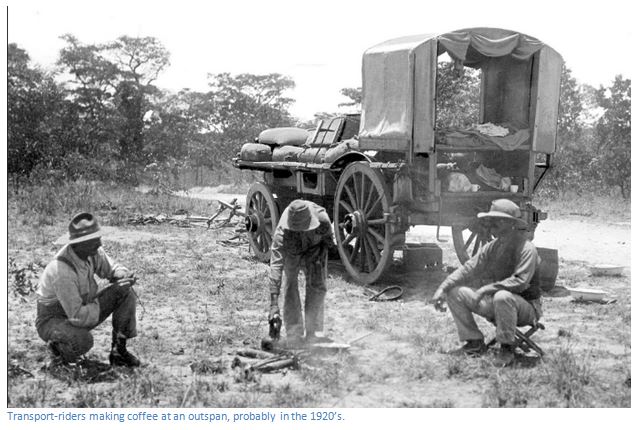
The driver’s whip is made up of a long and hefty bamboo shaft from 3.6 to 4.3 metres in length to which is attached a 6 to 9 metre lash, made out of buffalo, giraffe, hippo or rhino hide trimmed to the thickness of a finger and made very pliable and supple by a process called “braying” or constant rubbing with a greasy hand. The long lash ends in two shorter pieces called the achter-slag and the voor-slag ; the latter being at the end of the whip. When a whip is properly handled, the achter-slag and even more the voor-slag inflicts the punishment and produces the rolling and cracking sound which can be heard for miles around. Anything else according to Amous, Hyatt’s Basutu driver, was “ fit only for a Zulu, or a thief from Cape Colony .” A good driver never hit his bullocks if he could avoid it. The crack of his whip was sufficient, together with his voice, except when the wagon was badly stuck in a stream or black vlei.
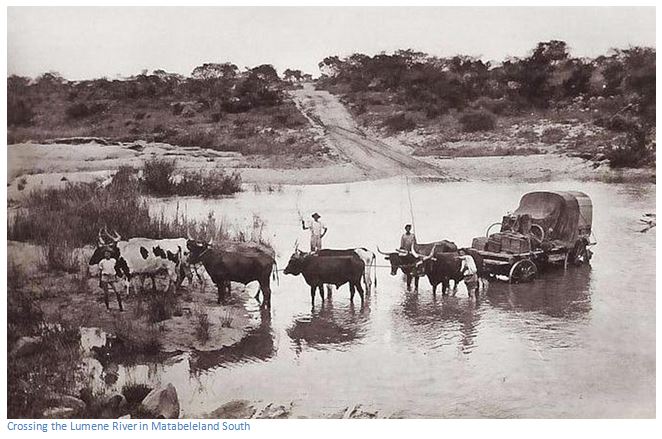
A lot of the driver’s spare time is taken up with keeping trek gear in good condition including the mending and replacing of broken yokes, strops, yoke-skeys and riems. The riem is indispensable, anything broken is bound up, and it serves to tie up the oxen at night, for the tow, catching the oxen at inspan time, for arranging them in yokes and for a hundred other purposes.
The driver must be agile too as he mounts and dismounts whilst the waggon is in motion. To get onto the wagon he puts his foot on the dϋsselboom and pulls himself up with his left hand by catching hold of the side rail. The surface of the dϋsselboom is highly polished by the hind oxen, achter-os, or wheelers rubbing against it. This slippery surface and the constant motion of the wagon have caused many unlucky drivers to slip and fall directly in front of a wagon wheel and be crushed to death.
Stanley Hyatt’s driver was Amous, a little Basutu and very contemptuous of his previous driver, a Zulu schelm called Joseph. He had horse hair plaited into the ends of his moustache to make it appear long and fierce, he was small and slightly built, but as tough as a watch-spring, absolutely tireless and indifferent to danger and hardship and unaffected by wet, cold, hunger, thirst or heat. His costume was always the same; blue dungaree trousers, a tattered canvas shirt and a huge sombrero, known as a “B.P” but according to Hyatt in use and known by this name long before Baden-Powell had been heard of in Africa.
When they met, Amous explained, quite truthfully as it turned out, that he was the best driver in the country. They agreed £3 a month and food; he saluted, borrowed some tobacco and went to inspect the oxen. An hour or two later, Amous returned saying they were “cattle indeed” and set to work to overhaul the wagon and gear, keeping up a running fire of uncomplimentary remarks about the Zulu character. All his thoughts and conversation were about cattle and he constantly lectured the picannin and young cook-boy on the beauties of the “ very little oxen indeed .”
Hans Sauer says the trek ox is the most delicate and least resistant to hardship, overwork, cold and bad feeding and soon goes “off-colour.” They do not have a great reserve of endurance or resistance to conditions foreign to their usual habit, but in character an ox is uncomplaining, tolerant and a bit of a stoic. He says he has never known the ox display any affection towards mankind!
Hyatt described in 1896 the Tuli outspan outside Bulawayo, close to the racecourse, as filled with scores of wagons and unbelievably filthy. The perfect breeding place for flies, filled with the litter of empty tins, no trees but plenty of low scrub to hide a sneak-thief; cow dung was used as fuel which half-choked everyone with its acrid smoke. Locals at the outspan comprised a choice collection of rascality and when not forging names to liquor passes would hand around the wagons and steal anything from a bullock to a pair of boots!
He concedes the one good point about Bulawayo is that the streets are so wide that you can turn a full span of bullocks in most of them; otherwise it has no merits whatsoever. The red dust is abominable, choking everything, whilst a single shower of rain changes the dust to slimy red mud!
He says that generally the Bulawayo man could neither ride nor shoot and would have lost his way five kilometres out of town; yet he invariably wore riding-breeches, puttee leggings and a hunting stock and any stranger hearing him talk to a barmaid about his mighty deeds would have taken him to be one of the original Pioneers.
The transport-rider on the other hand, wore dungaree trousers, a flannel shirt open at the neck and a disgraceful sombrero and at his three or four favourite bars around market square liked to be served by a man and to talk about his oxen and the rotten prices the forwarding agents were offering.
The rinderpest devastated the cattle herds in 1896 when 85-90% of the cattle were wiped out and transport rates rose enormously. Ox-wagons were abandoned in their hundreds; they might cost £80 – £100 at the coast, but in the interior they cost £3 - £4, or Stanley Hyatt says you could just take them and trust to luck not to meet their former owner later on. However from the viewpoint of the transport-rider rates were not extravagant as “salted” cattle (i.e. those that survived the rinderpest) cost £40 each, so a span cost over £640. Transport rates were 25 shillings per 100 pounds weight for a journey of over 320 kilometres along almost inconceivably bad roads, with long dry stretches and the possibility of lions at every outspan. On his first trip to the Geelong Mine this journey took Hyatt over six weeks.
In the last days of the Boer war in 1902 African East Coast fever came to the country. Rinderpest had spared up to 10% of the cattle and those that survived, being salted, increased very much in value. But African East Coast fever spared practically none and was carried by a tick. Hyatt had one bullock spared out of hundreds and their death was a long drawn out agony. Hyatt blamed the British South Africa Company that would not draw a cordon around Umtali (now Mutare) when the disease entered the country. Rhodes had just died and Hyatt thought the news of a new disease would send their share price down. Dr Koch told Hyatt that all cattle born along the coast were infected, and were unaffected unless they moved inland to the highveld. Hyatt believed that Rhodes’ Australian cows were landed at Beira, became infected and out of a thousand, all except three died when they entered Manicaland.
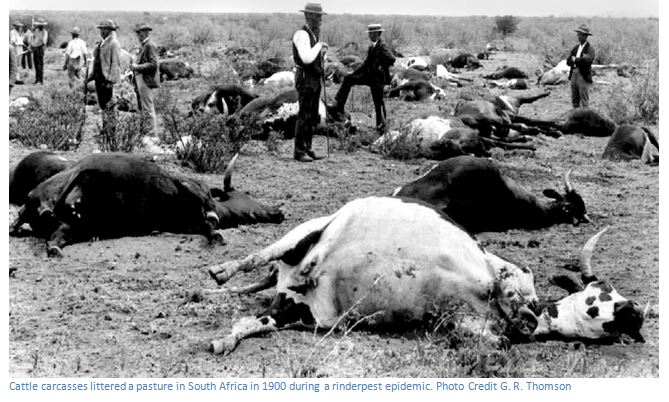
In a few weeks the disease spread throughout the country and the price of cattle fell dramatically killing the transport business. Their black span all died at Selukwe, the red span’s wagons were abandoned, fully loaded, near Tebekwana drift and Hyatt and his brother lost everything. A few weeks before they had been offered £550 for the black span, without the wagon.
This tragedy, which similarly affected all transport-riders throughout the country, combined with the spread of the railway, effectively finished the days of the ox-wagon as a means of transport, except in very out of the way areas. Robin Taylor writes in his article Gweru, a Railway Centre , that asbestos was moved from Shabani (Zvishavane) to the rail head at Selukwe (Shurugwi) a distance of 72 kilometres by ox wagon from 1913. Up to 5,000 oxen were used to pull 400 wagons continuously to move 18,000 tons of asbestos to Selukwe and supplies and machinery to Shabani. This method of transport by ox wagon continued until the railway line, which ran from Somabhula and was built by the Shabani Railway Company, was formally opened by Sir John Chancellor, then Governor of Southern Rhodesia on 11 May 1928.
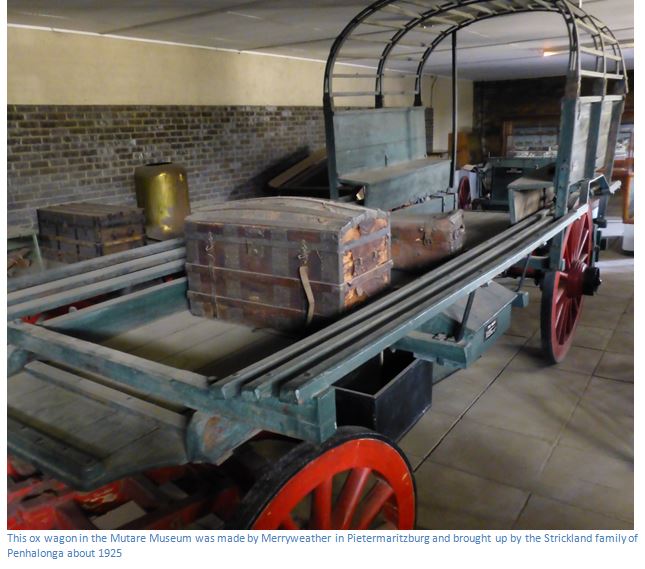
Acknowledgements
H. Sauer. Ex Africa. Books of Rhodesia, Volume 27 1973
S.P. Hyatt. The Old Transport Road. Books of Rhodesia, Volume 3 1969
R. D. Taylor. Gweru, a Railway Centre. Heritage of Zimbabwe No 20, 2001
Copyright © 2024,
Site by 3 Degrees
Horses-Mules-Oxen
c ompiled by Stephenie Flora copyright � 2007
Once the type of wagon was chosen it was time to choose the type of animal that would pull it. There were pros and cons to all the choices.
Horses were thought to be faster but required additional grain to keep them fit for the arduous journey. That meant that valuable space in the wagon had to be used to store their provisions. The stamina of the horse was not equal to the mule or the oxen and they were more likely to stray or be stolen by marauding Indians. Many an emigrant mourned the loss of their horses or had to lay over while they went in search of them.
Mules tended to have more stamina than the horses. Mules could travel about 20 miles a day. They also were more surefooted in treacherous climbs due to the fact that, unlike a horse, they are able to see where they are placing their hind feet.. Although known as "easy keepers" they still required a certain amount of grain to keep them fit when working under severe conditions. Randolph B. Marcy, Captain, US Army stated in his guide book, Prairie Traveler:
"Upon good firm roads, in a populated country, where grain can be procured, I should unquestionably give the preference to mules, as they travel faster, and endure the heat of summer much better than oxen; and if the journey be not over 1000 miles, and the grass abundant, even without grain, I think mules would be preferable. But when the march is to extend 1500 or 2000 miles, or over a rough sandy or muddy road, I believe young oxen will endure better than mules."
A mule's reputation as being stubborn comes from the fact that a mule will stop and look over a questionable situation before proceeding. A mule will refuse to proceed if it determines that it is dangerous. It took a special type of person to deal with the mules and many a teamster rued the day he became involved with them. Also, the cost of a team of six mules was around $600 making the oxen a much more economical choice.
Oxen became the choice of a majority of the emigrants. Almost without exception, the guide books recommended oxen. They were a little slower, traveling only 15 miles per day on average. However, oxen were dependable, less likely to run off, less likely to be stolen by the Indians, better able to withstand the fatigue of the journey and were more likely to survive on available vegetation. If they strayed they could be pursued and overtaken by horsemen. Not only were they the least expensive to purchase but they were more valuable on arrival, especially to farmers. In 1846 a yoke of oxen cost around $25. During the gold rush years prices peaked at around $40-$60 in the late spring.
And one final issue that entered into the decision was the difference in time to harness oxen as compared to a horse or mule. Suze Hammond, while reading "March of the Mounted Riflemen to Oregon in 1849" by Major Osbourne Cross noticed reference to this point and brought it to my attention. As one who has had to harness horse teams, Suze made this observation -
"An ox requires the hoop under the yoke be slid up, the yoke attached to the wagon tongue and a lead string put through its nose ring, and that's about it! (The second ox is a little harder to hook up because you have to get the first one to stand still too, as they are to be solidly attached to one another.) The equine has a cinch under its belly, a bridle with a bit, traces to attach to the singletrees, lines to arrange so they will not tangle, a cross-lines arrangement so that the teamster ends up with only one set of lines and not one for each animal, a horsecollar closed, and all straps lying flat so as not to abrade its skin over the day's pull. The amount of time difference would be significant when preparing to leave each morning." For an additional look at harnesses go to HARNESSES .
Care of the Animals
Whatever animal was chosen, the success of the journey depended on the care that the animals received. The greatest error of the inexperienced traveler was to overwork the animals at the beginning of the journey. To avoid problems it was best to start out with short and easy drives until the teams were broken in and became used to the routine of the day.
Grass and water were normally abundant in the eastern portions of the route. To the west were long stretches where grass and water were scarce, and it required animals in good condition to endure the fatigues and hard labor associated with the passage of these deserts. Drivers were encouraged to not abuse their animals or force them out of a walk. The teamster who made the least use of the whip usually kept their animals in the best condition.
In traveling with ox teams in the summer, the best mileage could be made by starting at dawn and making a "nooning" near grass and water during the heat of the day, as oxen suffer greatly from the heat of the sun in midsummer. When it cooled they could be hitched to the wagons again and the journey continued in the afternoon. Sixteen or eighteen miles a day could be made this way without injury to the animals.
Additional Information:
The Prairie Ox Drovers: located in Western Canada are dedicated to sharing their knowledge of the oxen. A wonderful site.
Centennial Farm of Orange County: This 5-acre farm includes an oxen team that is used during the tours to help educate the public to their use and value.

- Mar 5, 2021
- 20 min read
The Western Wagon Train: Part-One, The Routes West, Wagons, Prairie Schooners & How They Were Packed
Updated: Aug 21, 2021
What were the routes of the western emigrant? What kinds of wagons were used? How were they made and was there standard wagon-wheel spacing? How were they packed and what would all this cost?
*Note: Stay tuned for parts 2 & 3 on the Western Wagon Train. These will cover life on the trail, livestock & tack so for now, we'll focus on just the routes and wagons.

Picture yourself driving down a desert highway or crossing the Great American plains along the interstate. Turn off the radio and pull off onto some country road away from the roar of the traffic. Now get out of the car and listen to the silence. A bug buzzes by as a soft breeze lifts a rustling chorus from the scrub and grass around you. Take a breath and start walking; at least do so for a short while. If it was over a century and a half ago, this would be the speed of an emigrant caravan. Suddenly the world seems a lot larger when seen from the days of wagons, sweat and iron-will.

I remember a similar situation riding a horse along the Mojave Road past the ruins of Camp Cady (1860). As I followed the +160 year-old wagon ruts I could hear nothing but a desert wind. I paused to look at the rusted locomotive boiler that once powered freight winches back when this outpost was alive with soldiers, animals, and western travelers. I stood on top of the berm overlooking the now subterranean river taking in endless miles of desert. In my mind, I imagined a dragoon with his carbine or a seasoned ‘borderer’ with his rifle surveying the landscape and how short the reach of a fired ball would be in such vastness! Truly, you cannot appreciate how small you really are until you are in places like this. When you are standing at a remote location that has witnessed such history, you can hear the groan of Osage-orangewood wheels, the rattle of ox harnesses and canvas wagon covers in the breeze. A mule snorts; the oxen grunt and dusty wheels creak down a well-traveled road.

The Wagon Routes West
It was a long trip. For those coming from eastern cities such as Buffalo, New York, emigrants had already traveled hundreds of miles to reach outposts like Westport, Independence or St. Joseph which were the designated ‘start points’. To the south, travelers entered into places like Houston and San Antonio before lurching forward into the great unknown. From there, the journey would take from around 75 to 90 days. The optimal time to start the journey was through March right up to about April 20th at the latest. This would ensure that grass and water would be the most abundant with the least threat of winter storms or summer heat. There were 4 main routes that went through 3 different passes to clear the Rockies. The main routes are named below.

The two northern routes ( Oregon Trail & California Trail ) had the most water and greenery but were prone to winter snows. Both passed through the Rockies by means of the South Pass .

The two southern routes were the Old Spanish Trail & Gila River Trail. The Old Spanish trail (aka. The Santa Fe Trail ) went from Independence through the Sangre de Cristo Mountains by way of the Santa Fe Pass and was less vulnerable to winter weather than the two northern routes. The Gila River Trail (aka. Southern Emigrant Trail) followed the El Paso Route west. It had much better weather year-round but also suffered extreme heat and ‘journadas’ (long expanses where there is no water). Here are basics on each route.

The Oregon Trail – (1,940 miles) Westport to Astoria through the Rockies by way of the South Pass
The California Trail – (2,020 to 2,034 miles) Independence/Westport to Fort Hall and on to Sutter’s Fort through the Rockies by way of the South Pass
The Old Spanish Trail - (1898 miles) Ft. Leavenworth to Santa Fe through the Santa Fe Pass , then up into Utah Territory down through Mountain Meadows, across the Mojave Desert, through the Cajon Pass into Los Angeles & San Pedro Harbor
The Gila River Trail (later known as the, The Southern Emigrant Trail ) – (1,417 miles) Houston to San Diego following the El Paso Route.
A common alternate to the Gila River Trail is General Kearney’s Route (1,916 miles) from Fort Leavenworth through the Santa Fe Pass and Southern Arizona, to San Diego.
*Note: there are numerous alternate routes, trail names, origin-and-terminus points not mentioned here. The author selected the primary routes for the purpose of simplicity. There are many books detailing the various journey’s to the western states & territories. Two good recommendations to start with are The Prairie Traveler (1861-revised edition) and Disturnell’s Emigrant’s Guide to New Mexico, California and Oregon (1849).

If Ocean Travel Was the Fastest, Why Did So Many Go by Land?
Going by land was cheaper. At the very beginning, clipper ships took over 100-days 'round the horn' but that quickly changed to steamships dropping off passengers in Central America crossing the isthmus to the Pacific side and another ship. This trip took a month or less. The fastest ocean routes crossed the Isthmus of Tehuantepec (Mexico) or in Panama & Nicaragua. The problem is that the minimal cost for ocean travel was around $300 and the traveler arrived in San Francisco with only his/her carry-on luggage (8ft³ for cabin and 6ft³ for steerage). Anything extra went into the hold and was shipped as freight at an extra cost of around 70 cents per cubed foot. Freight on specie (gold & silver) was 1% of the specie’s value. Extra items such as food and equipment purchased in San Francisco or the Gold Country were sold at the inflated ‘California’ prices. The cost of going overland was around $200 or less per individual and the land-traveler would arrive fully equipped and provisioned for months.
Types of Wagons
The prairie schooner.

The prairie schooner shared many traits with a standard workaday farm-wagon. In many cases, the two were one in the same. It weighed around 900 lbs. and had a bed length of about 10 feet though some specimens were as long as 12 feet. The width typically varied from about 38-44 inches. With a load capacity of between 2000-2500 lbs., they were preferred over larger, heavier freight wagons such as the Conestoga not only because of cost but because it was hard enough to get a prairie schooners over some of the early western trails. For freight wagons, it was virtually impossible at first. Upon arrival at it's western destination, the prairie schooner could commence (or resume) it's next role as a farm wagon or other commercial vehicle.
Doug Hansen of Hansen Wheel and Wagon Shop contributed greatly to this article from the perspective of someone who makes wagons as an occupation. According to him, most people are surprised at how small the prairie schooner really is. Traditionally, prairie schooners and other light utility wagons did have a blue painted body and red painted wheels along with a red undercarriage or running gear. However, it is the white canvas or drill cover that got the prairie schooner its name.

It is said that the prairie schooner earned its name due to the way its white canvas cover resembled a small ship plying the great oceans of unending prairies, especially from a distance. In maritime terminology, there are differences between ocean schooners and the much faster 'clipper' ships that were used to bring the first Argonauts by sea. Perhaps there was greater meaning in using a different type of ship (schooners) to describe these wagons as the slower alternative by land. That said, one can easily draw the parallel between oceans of water and of grass. Both are long journeys In my opinion, the name 'prairie schooner' fits these hearty wagons of our American ancestors. When crossing prairie grasslands, it would have been a sight to behold a column of prairie schooners with white drill covers kicking up dust on a lonely trail. During the era of wind and sail, the oceans were plied by 'wooden ships and iron men'. The prairie schooners were manned by a similar breed of hearty individuals willing to face the unknown. Sweating beast replaced trade winds, but the same steel-nerve, fortitude, and the ability to endure great discomfort or loss were necessary traits of this tough generation of frontier people.
'Conestoga' and Other Freight Wagons

A common misnomer is that the average emigrant used Conestoga Wagons . They did not. Conestoga wagons were the 'freight trucks' of their day. Many of the early wagon roads were barely suitable for a prairie schooner, let alone a freight wagon that may be triple the weight of your average emigrant wagon. Larger wagons such as Conestogas could not make it through many mountain passes until significant improvements to the roads were made.

The Conestoga was a popular type of freight wagon dating from early 18th century Pennsylvania. Previous to westward expansion, it had been a workhorse along the frontier for generations. It’s characteristic long, curving frame enabled it to carry heavy loads over the country roads east of the Mississippi. These wagons were significantly longer than the prairie schooner at 12 to 15 feet in length over the prairie schooner’s customary 10-11 ½ foot average bed length.
Why is the bed of a Conestoga Wagon curved? According to Doug Hansen, the curved design of a Conestoga wagon bed is ideal for cradling a heavy cargo so that it does not shift on the rural roads of the Colonial Frontier. This allowed for a significantly heavy cargo to be carried in a single vehicle over uneven surfaces without compromising the wagon's structural integrity.

Due to its considerably heavy weight; heavy freight wagons were also not a favorite for the narrow and typically broken paths of loose sand and deep mud. Although desperately needed at various frontier outposts, road improvements were needed in order to get these large wagons to their destinations. As a national wagon road system was further established through the 1850s, road grading, widening and other improvements quickly made freight wagons a common fixture across the frontier.

Heavy freight wagons as seen here were about 36-44 inches wide & about 14-15 feet long with a high box (up to 7-feet) capable of carrying over 6-tons of freight. An original freight wagon at the Leonis Adobe in Calabassas, California measures 43" x 174" with a 6-ton freight capacity. The frontier forts and other outposts of civilization were initially supplied by pack horses and mules over primitive footpaths. With the coming of established wagon roads, the heavy freight wagons which were sometimes linked in twos and threes, would increase the logistical supplies needed to sustain these growing communities.

How were freight wagons driven?
The heavier freight wagons and ‘Conestogas’ were manned by 2-individuals, the driver and swamper . When using horses and mules, the driver was typically mounted on the left wheel horse (horse nearest the wagon’s front wheels). He operated jerk line that ran out to the lead horse so that he could control the team from behind. The swamper usually rode on top of the wagon or walked alongside it mainly to set the brakes and assist the driver. This system continued to be used even with the large borax wagons of the late 19th century where 20-mule teams hauled 2-3 wagons with a load of 10-tons or more. When working with oxen, the driver or 'bullwhacker' guides the team on foot. Nose leads or 'rings' attached to lead lines and a 'blacksnake' or bull-whip were then used to drive and steer the teams.
Other Wagon Variants

The type of wagon that classified as a prairie schooner would be capable of carrying about a ton of cargo (mostly supplies) over a great distance on primitive roads. In order to pass over those roads the design must be fairly light in weight when compared to other wagons. Many farm wagons and smaller freight wagons were pressed into service provided they were both lightweight and sturdy enough to ford streams and if necessary, be dismantled to ferry deep water or be moved through/around various obstacles along the way.

One such obstacle was Canon de San Fellipe (now called 'Box Canyon' in Anza Borrego Desert State Park) along the Gila River Trail near Vallecito. This narrow 'canon' had to be widened by the Mormon Battalion using picks and axes in order to get their wagons through during the winter of 1846-47. It would remain a narrow defile and local landmark through the days of the Butterfield stage route. It is still popular with hikers today.
Parts of the Western Wagon

This article will cover just the wagon right up to the falling tongue where the draft animals are hitched. The sequel articles cover animals, tack, driving, and camp life.
The image above is of a typical prairie schooner. It is a flat bed, small wagon with a box that may be planked or it may be paneled like a Conestoga and other freight wagons. 'Rave-framed' boxes (layman also call it 'Paneled') are a crisscross of horizontal plank sidings being ribbed by raves or 'rails' from the bed to the top for added durability. Rave framed construction was a weight-saving feature. Prairie schooners often had this type of box design. Another variant is for the siding composed to a few planks bolted and strapped together with perhaps a couple of raves for added weight. This second style was a little lighter and more economical but sacrifices some durability.
Was there a standardized track-width for old west wagons and how was it determined?
According to Doug Hansen, there is a purpose as to why the wagon bed is comparably narrow. Even in freight wagons, the bed is often 44 inches or less in width. This is because, the narrow box allowed clearance for the steering of the front wheels, also the track width of the wagon was equal to the width of the animals pulling it.
With 2-draft animals hitched together, common track widths were around 56” aka. 'Narrow Track ', or a 60” 'Wide Track . Also, wider wagons would have required a wider trail, and in the mountains, that was a big deal. Also, the longer the axle is, the more prone to breakage it becomes when passing over ruts or any uneven surface. This narrow width is the optimal balance between maximum load accommodation and durability against breakage. For minor repairs and maintenance, the jockey box carries the tools and hardware needed to keep the wagons in good order and the animals shod.

Brakes were an important part of freight wagons and prairie schooners. They provide the needed drag when coming down a grade. Operation was simple. The brake arm lever made the connecting rod move the brake bar which was connected to the brake block. This put the needed pressure on the rear wheels to prevent them from rolling. Brakes can also be set when the wagon is parked so that it will not roll. This is especially useful when the animals are unhitched. Brakes may or may not be on lighter wagon designs. If not, stones or heavy beams may be used to chock the tires when parked. If a wagon is traveling down a grade, the rear wheels may be chained to achieve the necessary amount of drag. For extreme grades, all four wheels may be chained so that the team can drag the wagon downhill without rolling into the team and complicating the process.
Wagon Construction & Wheels

What the Original Sources Said About Wagon Construction:
"Wagons should be of the simplest possible construction—strong, light, and made of well-seasoned timber, especially the wheels, as the atmosphere, in the elevated and arid region over which they have to pass, is so exceedingly dry during the summer months that, unless the wood-work is thoroughly seasoned, they will require constant repairs to prevent them from falling to pieces."
-The Prairie Traveler (1859)
"Let your waggons be strong, but light, with good lock chains..."
-The Emigrant's Guide to California (1849)
"The provisions for not more than three persons should be hauled in any one wagon, and that should be such an one as is known in Wisconsin as a light two-horse wagon. There should be no superfluous iron work about it, and the timber, particularly of the wheels, should be perfectly seasoned."
-The Overland Route to California (1852)
"The wagon should be an ordinary sized, two horse lumber wagon of the States ; not too heavy, but well made ; with a brake, or good lock chains for both hind wheels. The brake is an admirable fixture on a wagon for the plains, exceptionable only on account of its weight."
"It is often thought expedient, as a matter of safety, to rivet a light bar of iron the whole length of the wagon tongue. There should be a strong cotton (“ factory ”) cover to the wagon, and if double all the better; and what we mean by a double cover is, that there be one cover attached to the under or inside of the wagon hoops, that support the wagon cover, and the other upon the outside, as it offers far better protection against the beating winds and rains of the first three weeks, and the broiling sun of the rest of the journey."
-The National Wagon Road Guide (1858)
Notations on the Wagon Cover
The National Wagon Road Guide advises that the best wagon cover materials are of strong “ ...factory or drilling, not duck or heavy goods " . While some guides advise that the cover be painted or oiled, The National Wagon Road advises against it. I have to agree with Doug Hansen in his belief that an unpainted/un-oiled cover is the best way to go. The material in a regular unpainted wagon cover will tighten when wet and this will allow the wagon bonnet to shed water without a hard rain striking through. For added shelter from the rain, a double-cover (one below the wagon bows and one above) not only ensures a dry interior of the wagon, but it also creates a buffer airspace which is a better protection against an intense sun.

My previous experience in outdoor fabrics such as awnings and shades, is that a painted or oiled cover traps humidity rather than allowing it to escape. This means that an oiled or painted cover would not only make the wagon interior hotter and more humid than outside, but the indoor air quality would not be as good. Nineteenth-century Americans understood the positive effects of good air quality on health and that stagnant air aided illness in its progress. Although an oiled or painted cover would do a good job against rain, the interior will not be nearly as comfortable as it would be using a double layer of unpainted fabric.
Additional Notes on Wheel Construction:
"Wheels made of the bois-d'arc, or Osage orangewood, are the best for the plains, as they shrink but little, and seldom want repairing. As, however, this wood is not easily procured in the Northern States, white oak answers a very good purpose if well seasoned."
"...and the tire well riveted through the fellowes—if not thus fastened, you will have to wet your wheels every day, to prevent them from coming off'."
Outfitting for the Trip West
I have seen colorful diagrams depicting prairie schooners carrying stoves, beds, other furniture and perhaps a few sacks of grain. Although this imagery is more appealing to the eye, it does a terrible disservice to reality. The primary cargo of a pioneer wagon was provisions enough for the trip and perhaps up to a year to feed the emigrants as they got settled in. The few inexperienced travelers who packed heavy bureau drawers, stoves and the like, quickly discarded them out of necessity. According to Andrew Childs in his 1852 book on the Overland Route to California:
"Emigrants should be careful to take nothing which is not absolutely necessary, as all such articles will be thrown away when the journey is fairly entered upon. The value of property left on the California route in the season of 1850, was double that of the amount carried through. If you travel with a wagon, take a few extra bolts and nuts, a wrench, hammer, hatchet, &c., but no heavy or cumbrous tools. Take no stove ; if you do, you will most likely leave it by the road side in a short time. Your camp utensils and water cans should be made well, but not of heavy material."
While horses are reliable to pull wagons under most circumstances, and they were used on the western trails, those with more experience in emigrant trains over the western routes preferred mules or oxen which were considered more suitable for the hard task at hand. According to Joseph Ware in his 1849 Emigrant's Guide to California:
"Your teams should be either oxen or mules. If oxen, they should not be over six years old and not too large; the greatest difficulty may arise here¬ after, unless you are careful at the start. Your time for starting from home should be arranged so as to be on the frontier by the 20th April."
Here are two recommended load-outs; one with mules and the other is for oxen.
Outfit Plan No. 1 - Mules

Why Mules? - They have smoother, stronger muscles that give them superior strength over horses. They also have greater bone density and are less prone to illness and injury than horses. In everyday use, their endurance is greater than any other American draft animal including oxen. Their eyes are set further out of their sockets than a horse allowing them to see all 4 of their feet at once for greater terrain agility. They are smarter than horses and show the same sense of affinity towards people that asses do. They sleep more lightly and are better at detecting intruders than dogs; in fact, they can be better and more savage 'guard dogs' than, dogs are. (Author's Note: Those who disbelieve the last statement have never seen a mule get hold of a stray dog, coyote or even a mountain lion. People are not necessarily exempt either.)
*For 4 persons, with Mule teams. Wagon. harness, and 6 good Mules.
Item Details Cost
Wagon, Prairie Schooner $85,00
3 sett of harness $8 each 24,00
Mules $75 each 450,00
Wagon cover painted with two coats, $8. Total for team, - $567,00
Flour for 4 persons,—824 lbs. at $2 per 100 lbs. $16,48
Bacon " " - 725 lbs. at $5 per 100 lbs. 36,25
Coffee " " - 75 lbs. at 7₵ per pound 5,25
Sugar " " - 160 lbs. at 5₵ per pound 8,00
Lard & Suet " " - 200 lbs. at 6₵ per pound 12,00
Beans " " 200 lbs. at 40₵ per bushel 1,60
Peaches and apples " " 135 lbs. at 80₵ per bushel 3,20
Salt, pepper, saleratus (aka. baking soda), &c. 25 lbs. 1,00
Cooking utensils, including tin plates, spoons, coffee pot, camp kettle, knives, and extras $20,00
Total $670,78
Making the cost to each one of the party $167,69
From which deduct value of wagon, teams, &c., at journeys end, ... $450,00
Leaving cost of travel, ... $220,78
‘Cost to each individual, ... $55,19
Outfit Plan No.2 - Oxen

Why Oxen? - They are physically, the most suitable draft animal for long journeys pulling heavy loads in excess of 1,500-2,000 miles over rough, sandy, or muddy roads. Eight animals (4-yoke) cost only $200. This means that an ox is literally half the price of a mule. Oxen are less likely to stampede and more easily recovered if they do. They are difficult to rustle since they travel slow and would not make much headway before their theft is discovered. Oxen can be saddled and ridden if needed. They are also tastier than mule meat if it comes down to that. (Author's note: I have some friends who disagree with me on that last culinary statement.)
*One year's provision for 3 persons, with Ox teams
Four yoke of oxen. at $50 per 'yoke' (2-oxen) $200,00
One wagon cover, &c. 100,00
Three rifles. at $20, each 60,00
Three pair pistols. at $15, each 45,00
Five barrels flour. 1080 lbs., 20,00
Bacon. 600 " 30,00
Coffee. 100 " 8,00
Tea. 5 " 2,75
Sugar 150" 7,00
Rice. 75 " 3,75
Fruit, dried. 50 " 3,00
Salt, pepper, &c., 50 " 3,00
Salaratus. 10" 1,00
Lead. 30" 1,20
Powder. 25 " 5,50
Tools, &c., 25" 7,50
Mining tools. 36" 12,00
Tent. 30" 5,00
Bedding. 45" 22,50
Cooking utensils. 30" 4,00
Lard. 50" 2,50
Private baggage, & Matches. 150" Case of matches $1
One mule. 50,00
Candles and soap. 50" 5,30
TOTAL 2,583 lbs. $600
*Cost per man is $200,00
Cost to one man, $200,00 .
Portrait of a Packed Wagon

While the period wagon guide-books showed how to lay a flat pack that one could lay upon, there were times where necessary items took presence. These images of a modern day reenactment show just how full a wagon may be. If one wanted to sleep in this wagon, some unpacking would be required. This is a good demonstration of how small these wagons are. Perhaps two adults may sleep here side by side but that would be it.

This fully laden wagon from a modern reenactment demonstrates the priority of loading. Tools were hung off the sides of the box for ready use. Wash basins were always needed for a variety of purposes and ready to be easily accessed. Emigrants were well aware of hygiene but frontier travel was very dirty and knowing about cleanliness is completely different from being able to stay clean under such conditions. The most essential items such as bedding, camp chests and bags of useful items are packed on top to be accessed first. The food is packed beneath. This kept the food cooler and there was no need to access it until making camp. There is also a barrel on the lazy board. For long jounreys, this barrel would not be open-ended but rather, closed to prevent water loss during movement. The bung is where the barrel was replenished and a tap was used to dispense water to weary travelers.
Details of the Items to be Packed.

For the 75-90 day passage, it is recommended that about 280 pounds of food be carried per traveler. Although wild game can provide additional sustenance, it is also an unreliable food source. Wild herd animals learned to keep their distance from wagon trains so carrying about 3 pounds of food per person, per day is a good formula to providing more nourishment than would be necessary.
Meat (cured pork or bacon) - 75-80 lbs. per person, removed from the barrels and brine to be packed in 100-lb. sacks or boxes surrounded in bran to insulate against hot climates. These should be placed in the bottom of the wagon to keep cool. An additional 5-lbs. of dried or 'jerked''-beef should also be available.
Flour & Meal - 75 lbs. " " packed in 30-100 lb. sacks kept on top of the meat with care that moisture insects does not get into it.
Crackers or Pilot Bread - 50 lbs. " " either boxed or kept in sacks like meal.
Sugar - 30 lbs. " " kept in India Rubber or gutta percha sacks.
Rice and Beans or Peas - 10 lbs . " " kept in the same manner as flour & meal.
Coffee - 20 lbs. " " packed like beans and peas raw to be roasted & ground as needed.
Additional foods - Cheese (5 lbs.) kept in sacks near the meat; 20 lbs. of dried fruits & vegetables ; 5 lbs. of butter (canned); 5 lbs. of salt, spices, and citric acid ; other foods like honey, molasses, pickles, eggs, preserves, etc. to be carried at the traveler's discretion.

Cottons and linens may be suitable to the humidity of the eastern states but it provides little protection against the western sun or the freezing cold. Numerous accounts cite wool as the best material, even with underwear. There should be at least 2-each of drawers, undershirts, flannel overskirts, pantaloons, and coats. There should also be 2-pairs of shoes/boots, and 6-pairs of socks to accompany other items such as overcoats, talmas, headwear, camp shoes/moccasins, gloves, mittens, scarfs, blankets, ground cloths, buffalo robes, etc.

This includes tents, cookware, bedding, candles, soap, and other camp gear along with personal baggage to the amount of 300-350 pounds. In some cases, light camp furniture such as folding tables, stools, cots and chests could be easily accommodated.
Armaments & Ammunition

Each individual would carry either a rifle, fowler, or double-barreled shot-gun, along with a pair of single-shot pistols or a Colt's revolver and knife. Each would have about 10 pounds of lead. 8 pounds of powder in flasks or cannisters, caps or flints, with the necessary tools to maintain them.

The total allowance of tools per wagon amounts to about 60 pounds of weight. These are for homesteading, wagon repair, and prospecting as in the case of the California Gold Rush.
Homestead tools - Hammers, Saws, Ironware, Gimlets, Augurs, Froes, Hoes, Drawknifes, Axes, Hatchets, Caulking tools, & etc.
Prospecting tools - Picks, Shovels, Spades, Pans, Assay kits, and other items as specified in the illustration.
Don't Forget Your Water!
Typically, you want to avoid cumbersome kegs and barrels in a pioneer wagon, but water is absolutely critical, especially when crossing 'journadas' or long waterless expanses between water sources. A good method is to carry a cask or two on the outside of the wagon. These often held about 20 gallons each. In the National Wagon Road Guide (1858), the following was recommended as well:

"You will find it of great service along the way, to have a large tin can, holding ten or fifteen gallons, in which to carry water over long stretches where there is none."
There are few things that justify the extra weight. Water is one of them.
Imagine the scene as emigrant trains assembled in places like Independence, Westport, or St. Joseph. There would be children playing while the adults handled final business transactions; perhaps a few final emotional good-byes while animals were bought and hitched. Wagons were loaded with anticipation of the trip turning the air electric with excitement of a great adventure. The inexperienced would have started out with songs and jubilation. The more experienced pilots, guides, and teamsters knew for certain that the songs would fade and at times, graves would be dug. The great journey across the plains, mountains and deserts would be a life-changing event. The hardships turned iron will into steel-resolve. Those who completed the journey or perished on the trail embodied a pioneering spirit that not only changed our land forever, but it changed the spirit of our nation as well.
The Wainwright
Special thanks to doug hansen of hansen wheel and wagon shop..

The best way to understand the level of craftsmanship required to be a good wagon-maker or wainwright, one should consult a master and industry leader. Doug Hansen is the Master Craftsmen & Historian who founded Hansen Wheel & Wagon Shop in 1978. Mr. Hansen follows the methods from the original craftsmen from the era. He is considered an expert in the field and gives regular seminars on the practical working of historic horse drawn vehicles specializing in the study of western US carts and wagons.
About Hansen Wheel & Wagon Shop
Motivated by a love of history and a desire to preserve our heritage, Hansen Wheel & Wagon Shop has grown to be the premier builder of authentic, horse-drawn vehicles. For thirty-five years, its experienced staff of dedicated craftsmen have fashioned a line of superior quality wagons, wheels, and equipment to suit a wide range of individual budgets and interests. The company is dedicated to product quality and commitment to service and customer satisfaction.

The list of Hansen's customers include Henry Ford's Greenfield Village , Ketchum Wagon Museum , and Grant’s Farm-Anheuser Busch (That's right! working on the World Famous Clydesdale Wagon.) Accolades include Hollywood productions such as The Hateful Eight & Hell on Wheels . They are also the first manufacturer to create a genuine borax wagon since the 1880s.
The editorial staff at the Frontier American Illustrated News is grateful for Doug Hansen's insight and the company photography which made this article possible.
- How Life Was in the Old West
- Trail Tips to Frontier Travel
Recent Posts
Survival Tricks for When Less is More: Alternate Uses for Common Old West Items
The Mesquite: Super-Food Treasured by The Ancients. It is Delicious & Easy to Prepare. Here's How...
Mules in the American West
14 Comments
On the Oregon Trail, it would probably be a good idea to watch out for diseases such as Cholerea and Dysentary
Yes, the gif is random
Where can i get seed to plant tne mesquite for future trees?
When are the books going to be published??
Glad you asked, Marty. Settling into the new job really took away time on the project. I have been pulling late nights to get them done. I figured that a year behind schedule is late enough. This first one is a project that I started for some Colorado Volunteers and it took on a life of its own. It has elements from the other books I have been working on. I am using a pretty extensive collection of public domain illustrations along with a few of my own creation. This will have topics that foreshadow the other books in the series. Hopefully I can go into production on this one next month.
Thanks Santee. The pleasure is mine. This content is actually the scaled down article from what I have in the book. I look forward to your coming episodes.
I have seen a lot of wagons since I moved out West, and have done some research, but this is really helpful for future projects. I look forward to the next two.

5 famous constellations that (almost) anyone can find
From Andromeda to Ursa Major, these cosmic landmarks dominate the sky. Learning how to spot them will turn you into a star gazer.
The night sky is so vast; where do you start? Finding your way through the sky begins with a few dominant constellations, containing everything from star clusters and nebulae to obscure galaxies. If you keep looking upward, you’ll see these five constellations parade throughout the sky and through the seasons.
1). Andromeda (The Chained Maiden)
Andromeda, the Chained Maiden constellation, can be seen from August through February. This large constellation in the northern sky is conspicuous thanks to its attachment to the neighboring constellation Pegasus and that constellation’s Great Square asterism. The brightest star, Alpheratz, which represents the head of the maiden, happens to be shared with Pegasus. This blue giant star lies 97 light-years from Earth and shines 200 times brighter than our sun. Four main stars of Andromeda form a curved line toward the east, with Mirach representing her hips and Almach her chained foot. Although Mirach is nearly identical in brightness to Alpheratz, it is a larger red giant 197 light-years away.
Although Andromeda is considered a northern constellation, most of its stars can be glimpsed from the Southern Hemisphere, but always near the horizon, making it a bit trickier to observe its famous deep-sky objects. The most celebrated of these is the grand spiral called the Andromeda galaxy, or Messier 31. This, the closest large galaxy to our Milky Way, lies 2.5 million light- years away. To the surprise of many people, it can be spotted with the naked eye from a typical suburban backyard on a clear autumn night. It represents one of the farthest objects the unaided human eye can see in the universe.
2). Canis Major (The Great Dog)

Canis Major is the larger of the two faithful hunting dog companions to Orion, the Hunter (explained below.) Standing by the Hunter’s foot, the Great Dog is an easy-to-find constellation visible from most areas of the world, thanks to being positioned just south of the celestial equator. Canis Major’s sparkling eye is the brightest star in the sky: Sirius.
Introducing Nat Geo Kids Book Bundle!
The dog days of summer were named specifically for the Dog Star. In the Northern Hemisphere, ancient sky-watchers noticed the intensely bright star would rise and set with the sun. The combined power of the two suns was thought to be the cause of the stretch of hot weather experienced in late summer.
For binoculars and telescopes, Canis Major is rich in star clusters. Leading the pack is the beautiful open cluster M41, also known as the Little Beehive, which lies only four degrees south of Sirius. Containing some 80 stars, this fourth-magnitude cluster is 2,300 light-years away, yet is visible as a hazy patch to the naked eye on a dark night. It is an impressive sight through a backyard telescope, with orange stars scattered within.
3). Orion (The Hunter)

Visible across the world, Orion is one of the most identifiable as well as one of the oldest constellation figures, crossing cultures and thousands of years. Orion straddles the celestial equator, so it is well known to observers in both the Northern and Southern Hemispheres and holds the record for containing the most bright stars in one stellar pattern.
Many stories are attached to Orion, a great hunter in Greco-Roman myths. The most famous says that he was stung by a scorpion (Scorpius) in an epic battle, which is why the two figures have been placed in opposite parts of the sky. Orion boasts two first-magnitude stars, with Betelgeuse marking the shoulder to the viewer’s left and Rigel his foot on the right. Sitting between Rigel and Betelgeuse is Orion’s stellar line of three stars, Alnitak, Alnilam, and Mintaka, marking the Hunter’s belt.
Orion includes an area of the Milky Way that features intense star production. Beneath the Hunter’s belt, in the middle of three stars that form Orion’s sword, is the Orion Nebula (M42). Visible to the naked eye as a fuzzy, faint patch, in backyard telescopes delicate wreathlike structures show where star formation is taking place at a furious pace.
4). Crux (The Southern Cross)

One of the most famous of all southern constellations, Crux is the smallest constellation in the sky, yet it is among the most recognizable. Its distinctive cross asterism is marked simply by four bright stars. In ancient times before Earth’s precession shifted the stars toward the south, the stars of Crux were visible from Europe. But it wasn’t until the 17th century, when European navigators sailing south recognized the cross-like pattern, that Crux became its own official constellation. While best explored from south of the Equator, keen-eyed sky-watchers as far north as the southern tip of Florida can glimpse the Southern Cross.
Crux straddles a rich section of the southern Milky Way band and so is filled with deep-sky treasures of all kinds. Just east of Crux lies what appears to be a hole in the sky—a dark region devoid of stars known as the Coalsack Nebula. It is clearly visible to the naked eye as a strikingly large, dark gas cloud silhouetted against a bright star-studded Milky Way.
5). Ursa Major (The Great Bear)

Ursa Major, also known as the Great Bear, is one of the most prominent northern constellations, and its main claim to fame is that it contains the Big Dipper, a highly recognizable asterism. The easily identifiable Big Dipper represents the bear’s rear torso and tail, with the other stars of the constellation mapping out its long nose and legs. For most observers in the Northern Hemisphere, the Great Bear is close enough to the north celestial pole that it never sets below the horizon, and it rotates around the North Star once a day.
While to the ancient Greeks this stellar group represented a large bear, other cultures saw everything from a chariot to a horse and wagon, a team of oxen, and a hippopotamus (by Egyptians, who had likely never seen a bear). Some Native American tribes believe the cup of the dipper represents a bear and the stars in the handle represent warriors who pursue it.
Finally, remember that you will get your best viewing on moonless nights away from brightly lit areas. Give your eyes time to adjust to the darkness—and good hunting!
- Environment
- Paid Content
History & Culture
- History & Culture
- History Magazine
- Mind, Body, Wonder
- Terms of Use
- Privacy Policy
- Your US State Privacy Rights
- Children's Online Privacy Policy
- Interest-Based Ads
- About Nielsen Measurement
- Do Not Sell or Share My Personal Information
- Nat Geo Home
- Attend a Live Event
- Book a Trip
- Inspire Your Kids
- Shop Nat Geo
- Visit the D.C. Museum
- Learn About Our Impact
- Support Our Mission
- Advertise With Us
- Customer Service
- Renew Subscription
- Manage Your Subscription
- Work at Nat Geo
- Sign Up for Our Newsletters
- Contribute to Protect the Planet
Copyright © 1996-2015 National Geographic Society Copyright © 2015-2024 National Geographic Partners, LLC. All rights reserved

OxTrail prepares trail with 30 life-size ox sculptures across city
More than 30 life-size ox sculptures have been sponsored by companies in and around Oxford as part of a giant art installation event next month.
This year’s OxTrail will feature ox sculptures taking over the streets on Saturday, July 6 to raise money for Sobell House Hospice Charity.
Stagecoach West is sponsoring an ox decorated by local artist Mary Blackshaw that will appear in the trail which will be free to follow.
READ MORE: Student scrambles for funds from public after costly University of Oxford offer
The trail will see individually painted sculptures dotted around the city for the public to go and find.
(Image: Contribution)
Mary Blackshaw, a sculpture artist, said: "I am thrilled to have created our ox for Sobell House Hospice thanks to the generosity of Stagecoach West’s sponsorship.
“As a local, I sought to capture the playful eccentricities of Oxfordshire, both old and new across the county .
“I have illustrated local legends and folklore, some famous and some lesser known which I am excited for everyone to see, very soon."
Stagecoach West has backed the OxTrail app where players find and ‘collect’ Ox sculptures and unlock a sponsor reward for each one.
The busy company donate £1 to Sobell House Hospice for each unlocked visit to its Ox sculpture on the app.
READ MORE: Home with 750ft railway track, five wagons and station in the garden goes on sale
Karen Coventry, commercial and marketing director at Stagecoach West says: “We’ve had a sneak preview of our ox and can’t wait for everyone else to see Mary’s masterpiece ‘grazing’ out in public.
"We’re honoured to be part of such a special art event which will bring families and friends together to explore our beautiful city whilst raising money for an incredible cause at the same time.”
The display until the end of August 2024 and after this sculptures will be auctioned off to raise money for the hospice.
The charity provides palliative care and support to around 3,000 adult patients a year as well as their families, friends, and carers.
Amelia Foster, CEO of Sobell House Hospice Charity, said: “Across eight weeks, OxTrail will encourage locals and visitors of all ages to explore Oxford’s iconic attractions and find some hidden gems.
“It’ll be a huge event for the city but one we would not be able to do without the fantastic support and sponsorship from local businesses such as Stagecoach West.”
For the eight weeks in summer, 139 oxen in total will be situated across the county for people to visit including the 31 large oxen painted by artists all situated outdoors.
Then 108 of the smaller oxen will be across the city and the county in publicly accessible buildings within Oxfordshire towns.
OxTrail is being held in partnership with Wild in Art.
Cities across the world have famously brought their streets to life through Wild in Art installations including Manchester, Sydney, Cape Town and São Paulo.

View prices for your travel dates
- Excellent 6
- Very Good 11
- All languages ( 25 )
- Russian ( 25 )
- English ( 0 )
Own or manage this property? Claim your listing for free to respond to reviews, update your profile and much more.
ELEKTROSTAL HOTEL

- Bahasa Indonesia
- Eastern Europe
- Moscow Oblast
Elektrostal
Elektrostal Localisation : Country Russia , Oblast Moscow Oblast . Available Information : Geographical coordinates , Population, Altitude, Area, Weather and Hotel . Nearby cities and villages : Noginsk , Pavlovsky Posad and Staraya Kupavna .
Information
Find all the information of Elektrostal or click on the section of your choice in the left menu.
- Update data
Elektrostal Demography
Information on the people and the population of Elektrostal.
Elektrostal Geography
Geographic Information regarding City of Elektrostal .
Elektrostal Distance
Distance (in kilometers) between Elektrostal and the biggest cities of Russia.
Elektrostal Map
Locate simply the city of Elektrostal through the card, map and satellite image of the city.
Elektrostal Nearby cities and villages
Elektrostal weather.
Weather forecast for the next coming days and current time of Elektrostal.
Elektrostal Sunrise and sunset
Find below the times of sunrise and sunset calculated 7 days to Elektrostal.
Elektrostal Hotel
Our team has selected for you a list of hotel in Elektrostal classified by value for money. Book your hotel room at the best price.
Elektrostal Nearby
Below is a list of activities and point of interest in Elektrostal and its surroundings.
Elektrostal Page

- Information /Russian-Federation--Moscow-Oblast--Elektrostal#info
- Demography /Russian-Federation--Moscow-Oblast--Elektrostal#demo
- Geography /Russian-Federation--Moscow-Oblast--Elektrostal#geo
- Distance /Russian-Federation--Moscow-Oblast--Elektrostal#dist1
- Map /Russian-Federation--Moscow-Oblast--Elektrostal#map
- Nearby cities and villages /Russian-Federation--Moscow-Oblast--Elektrostal#dist2
- Weather /Russian-Federation--Moscow-Oblast--Elektrostal#weather
- Sunrise and sunset /Russian-Federation--Moscow-Oblast--Elektrostal#sun
- Hotel /Russian-Federation--Moscow-Oblast--Elektrostal#hotel
- Nearby /Russian-Federation--Moscow-Oblast--Elektrostal#around
- Page /Russian-Federation--Moscow-Oblast--Elektrostal#page
- Terms of Use
- Copyright © 2024 DB-City - All rights reserved
- Change Ad Consent Do not sell my data

IMAGES
VIDEO
COMMENTS
An ox-wagon or bullock wagon is a four-wheeled vehicle pulled by oxen (draught cattle). It was a traditional form of transport, ... These shanties were spaced at about 12-mile (19 km) intervals, which was the usual distance for a team to travel in a day. South Africa
Travel by oxen was at an average of about two miles per hour, which was one-half to two-thirds the speed of a horse or mule. Freight teams at Pony, Montana ca. 1900 ... Wagons were loaded according to the number of horse or mules needed. A big mule could pull more than a ton and more than the average size horse. Mules and horses were more ...
A bullock cart or ox cart (sometimes called a bullock carriage when carrying people in particular) is a two-wheeled or four-wheeled vehicle pulled by oxen. It is a means of transportation used since ancient times in many parts of the world. ... The first indications of the use of a wagon (cart tracks, incisions, model wheels) are dated to ...
Most covered wagon families could travel about 10-15 miles a day; carrying all that weight, it must have been agonizingly slow at times. ... a curved wooden beam fitted to a pair of oxen so that they could work together pulling the covered wagons. Today, ox yokes are collected as primitive pieces of Americana. Oxen also had to be shod if they ...
Out of necessity, the Mormon pioneers had milk cows pulling about 20% of their wagons. It took about two cows to equal the strength of one ox. Starry the milk cow "pulled in sunshine, rain, and heat over dry, rocky, muddy, sandy, level, hill mountain roads, across sloughs and swiftly-flowing creeks and river, for months [all while being] very ...
Why did so many Western-bound wagon trains use oxen instead or horses of mules? Joshua Young. Star Valley, Arizona. Oxen were slower than mules or horses, but they had their advantages, such as they ate less, required less care, and they could pull heavier loads. And while a mule or horse could cost $90, an ox could be bought for about $50.
Minivan of the Emigrant Trails. Between 250,000 and 500,000 people made their way west from 1841 until 1869. The covered wagon was one of the main methods of transportation during this time period, often drawn by mules or oxen. Wagons in the nineteenth century varied widely depending on what they were used for.
Ox-wagons are typically drawn by teams of oxen, harnessed in pairs, and depending on the weight and size of the wagon they would harness anywhere between 8 and 18 oxen. ... inspan (harness the oxen to the wagons) at four o'clock in the morning and travel slowly till about eight o'clock and then outspan for the day and at four o'clock in ...
The first recorded use of an ox-wagon was around 1670, ... (19 km) intervals, which was the usual distance for a team to travel in a day. [5] South Africa. The Voortrekkers used ox-wagons (Afrikaans: Ossewa) during the Great Trek north and north-east from the Cape Colony in the 1830s and 1840s.
Figure. 2 Ox-drawn traveling wagon covered with a canvas tent for protection. Wagons were built in different sizes according to the purpose for which they were used. In South Africa, 17 varieties of wood were used for wagon building. South African wood varieties are regarded as the best for wagon building. Some wagons were used to travel long ...
Narrow covered wagon used by west-bound Canadian settlers c. 1885 Painting showing a wagon train of covered wagons. A covered wagon, also called a prairie wagon, whitetop, or prairie schooner, is a horse-drawn or ox-drawn wagon with a canvas top used for transportation or hauling. The covered wagon has become a cultural icon of the American West.
(Travel by horse and mule could cut a full month off travel time for a 2,000-mile journey, but oxen had other advantages that could mean the difference between life and death.) ... PHOTOS: (1) Oxen-hitched wagons lining up to cross the Arkansas River at Great Bend, Kansas. Date unknown. Riverbanks on wagon train trails were often bogs of deep ...
Mules also had tendencies to bolt and become unruly. Oxen are slower, but more reliable and tougher than mules. They will eat poor grass. Oxen were very strong and could haul fully-loaded wagons up ravines or drag them out of mudholes. A large wagon needed at least three pairs of oxen to pull it. Scholars put the percentage of pioneer wagons ...
Perhaps the largest wagon train to travel on the Oregon Trail left Missouri in 1843 with over 100 wagons, 1,000 men, women and children, and 5,000 head of oxen and cattle. The train was led by a Methodist missionary named Dr. Elijah White. But wagon trains became so common on the trail that processions seemed to have no beginning or end.
O O xwagons - South Africa's Voortrekker pioneers rode in them, blazed trails in them, sometimes gave birth in them and died in them. Relive those days when you sleep out at the Clarens Oxwagon Camp. Dine out beside a crackling camp fire before bedding down in a comfortable old-time oxwagon.. The Clarens Oxwagon Camp is a living reminder of those feisty, Dutch-speaking Voortrekkers ...
Arches over the top of the wagon were covered by heavy canvas. The incredible weight being moved required significant animal power, and so most often, wagons were pulled by teams of oxen, though occasionally mules or horses were utilized instead. Added benefit: an ox wasn't a very attractive target for thieves — they moved slowly, you couldn ...
Hans Sauer says the trek ox is the real pioneer of the southern African sub-continent. They dragged the wagons across the whole of South Africa and crossed the Limpopo and Shashe Rivers and then across the Lundi (Runde) to Victoria and finally Salisbury. Before the coming of the railways it was the trek ox that provided all the transport ...
That meant that valuable space in the wagon had to be used to store their provisions. The stamina of the horse was not equal to the mule or the oxen and they were more likely to stray or be stolen by marauding Indians. ... Mules could travel about 20 miles a day. They also were more surefooted in treacherous climbs due to the fact that, unlike ...
The prairie schooner shared many traits with a standard workaday farm-wagon. In many cases, the two were one in the same. It weighed around 900 lbs. and had a bed length of about 10 feet though some specimens were as long as 12 feet. The width typically varied from about 38-44 inches.
While to the ancient Greeks this stellar group represented a large bear, other cultures saw everything from a chariot to a horse and wagon, a team of oxen, and a hippopotamus (by Egyptians, who ...
Price trend information excludes taxes and fees and is based on base rates for a nightly stay for 2 adults found in the last 7 days on our site and averaged for commonly viewed hotels in Elektrostal.Select dates and complete search for nightly totals inclusive of taxes and fees.
The busy company donate £1 to Sobell House Hospice for each unlocked visit to its Ox sculpture on the app. READ MORE: Home with 750ft railway track, five wagons and station in the garden goes on sale
A mix of the charming, modern, and tried and true. See all. Apelsin Hotel. 43. from $48/night. Apart Hotel Yantar. 2. from $28/night. Elektrostal Hotel.
Elektrostal Hotel, Elektrostal: See 25 traveler reviews, 44 candid photos, and great deals for Elektrostal Hotel, ranked #1 of 2 B&Bs / inns in Elektrostal and rated 4 of 5 at Tripadvisor.
Elektrostal Geography. Geographic Information regarding City of Elektrostal. Elektrostal Geographical coordinates. Latitude: 55.8, Longitude: 38.45. 55° 48′ 0″ North, 38° 27′ 0″ East. Elektrostal Area. 4,951 hectares. 49.51 km² (19.12 sq mi) Elektrostal Altitude.